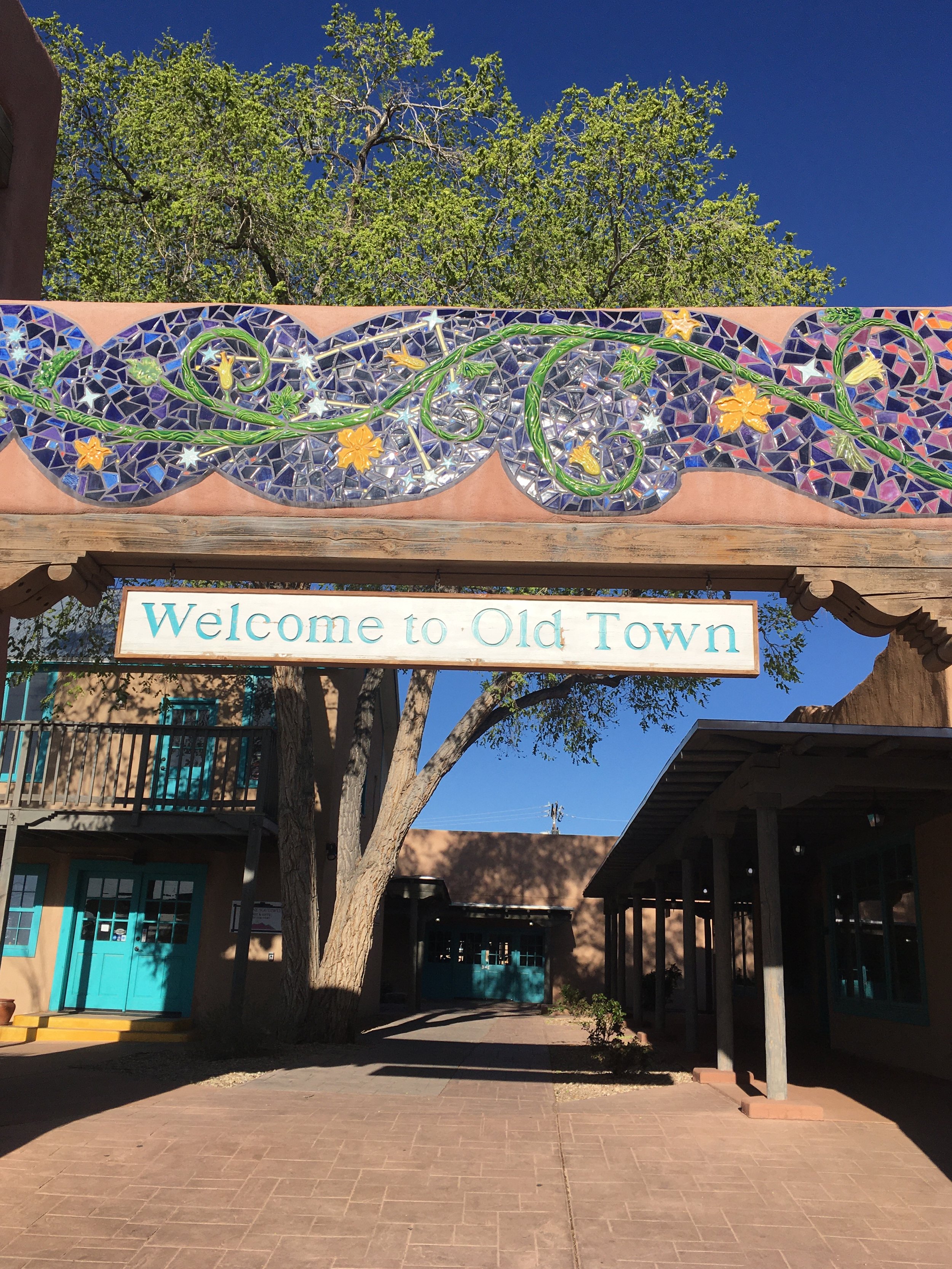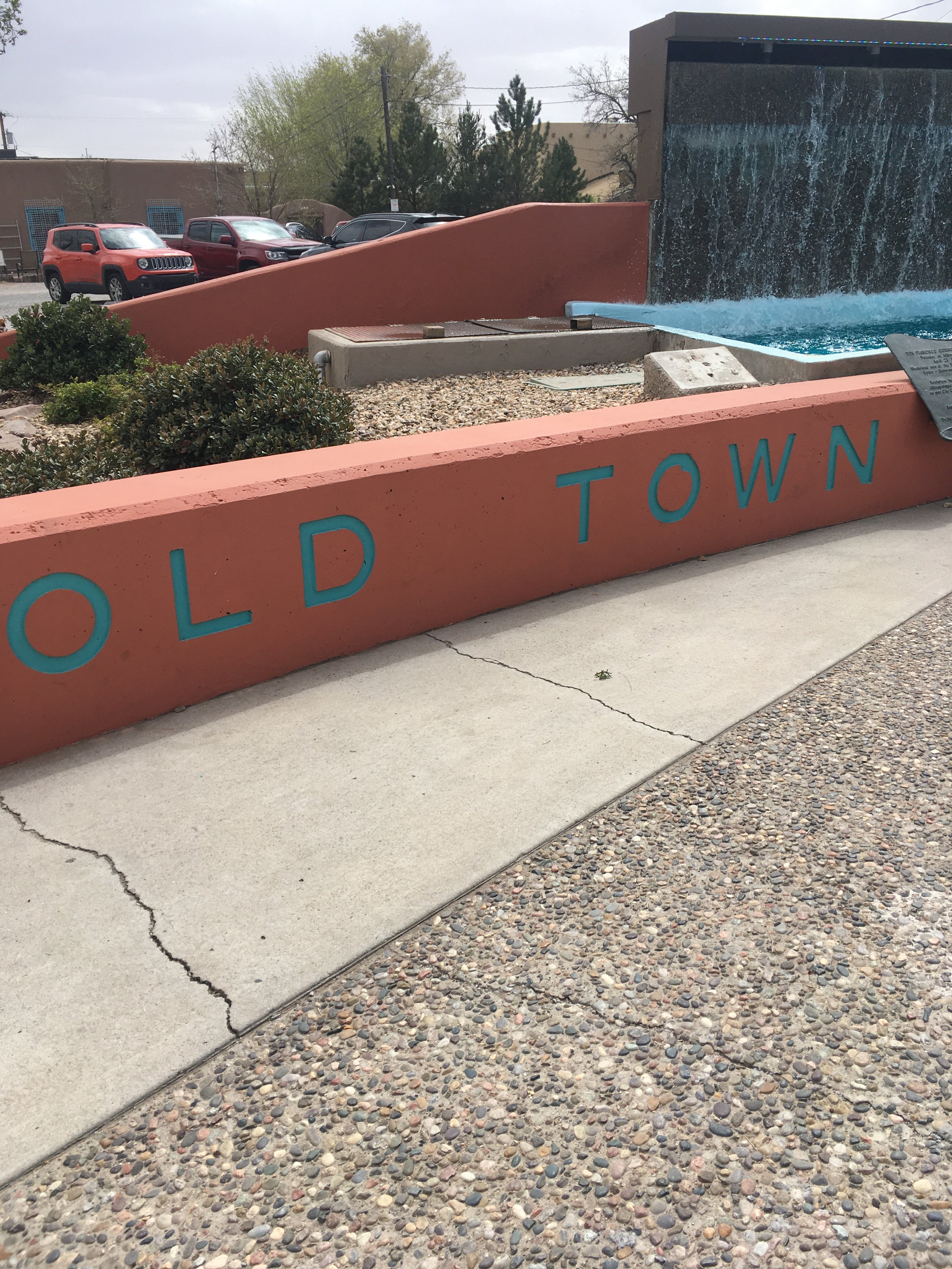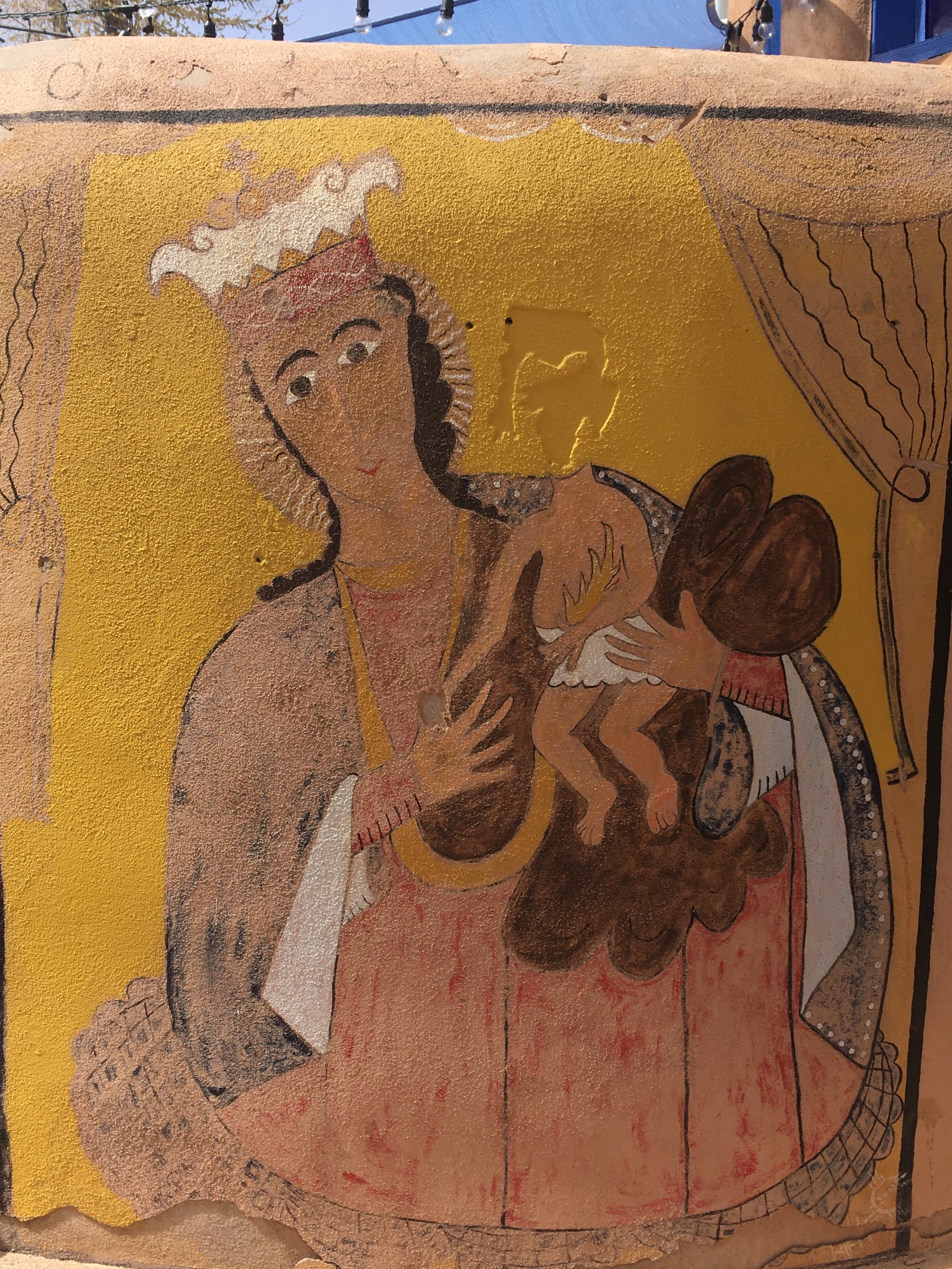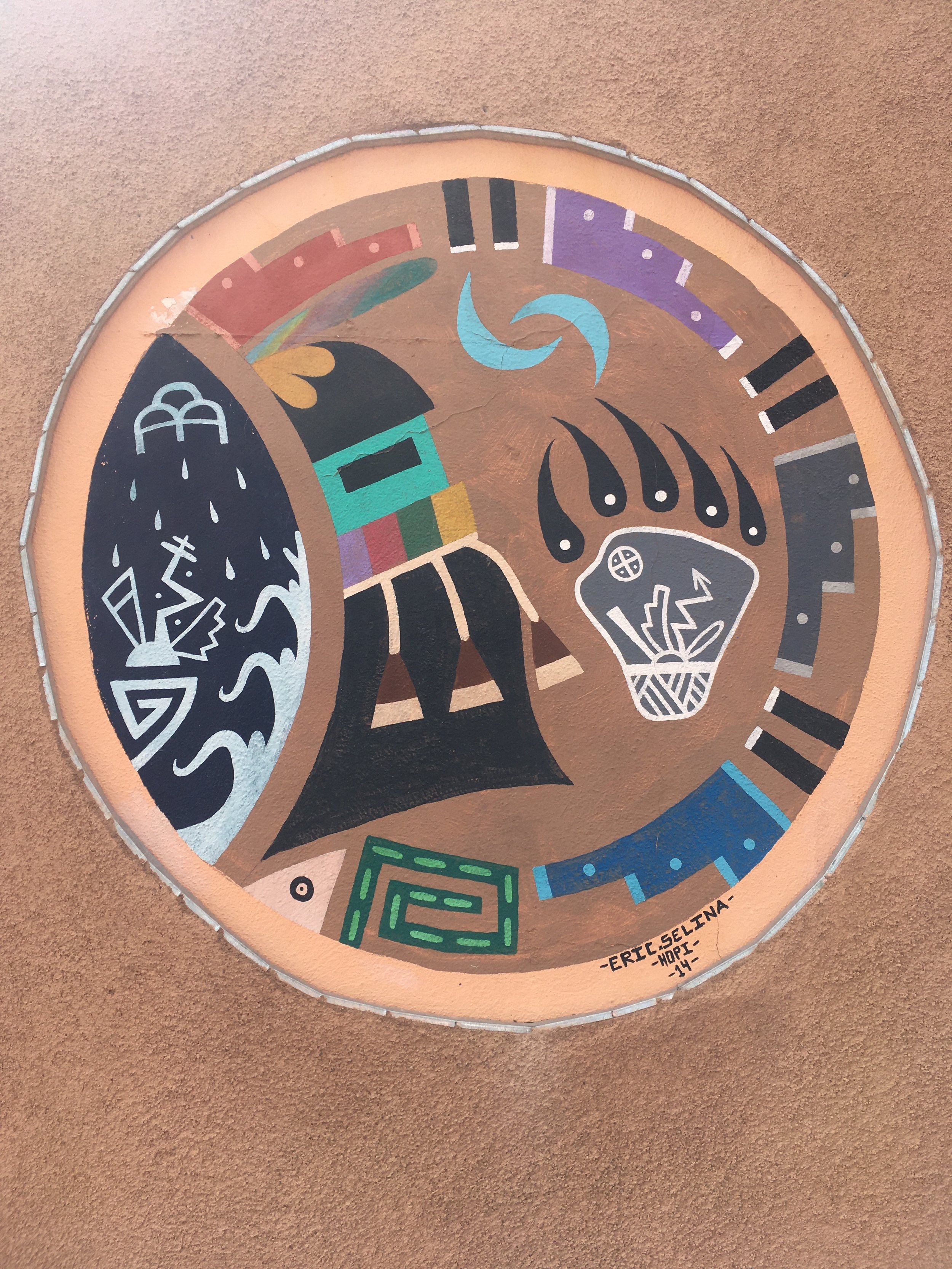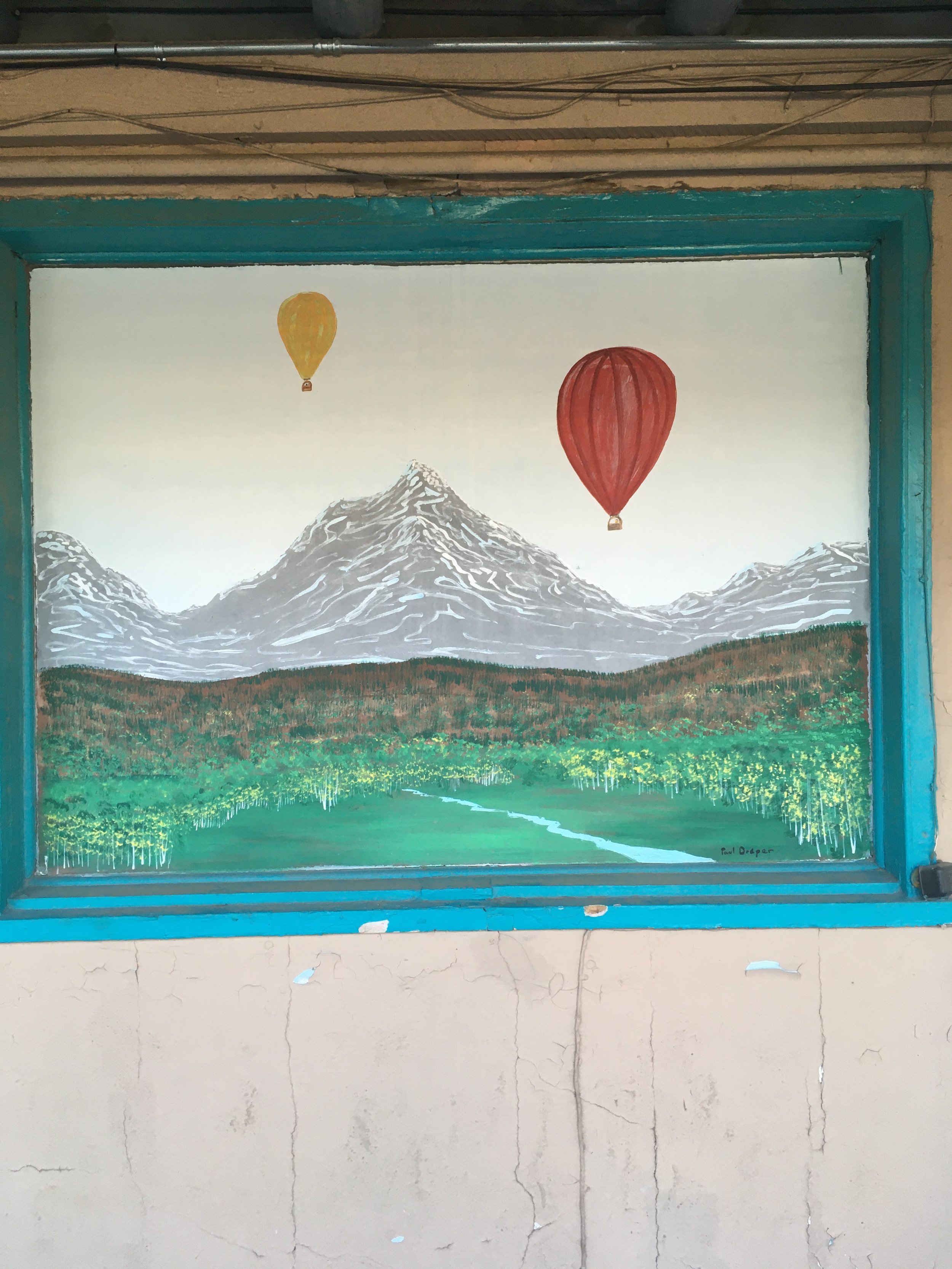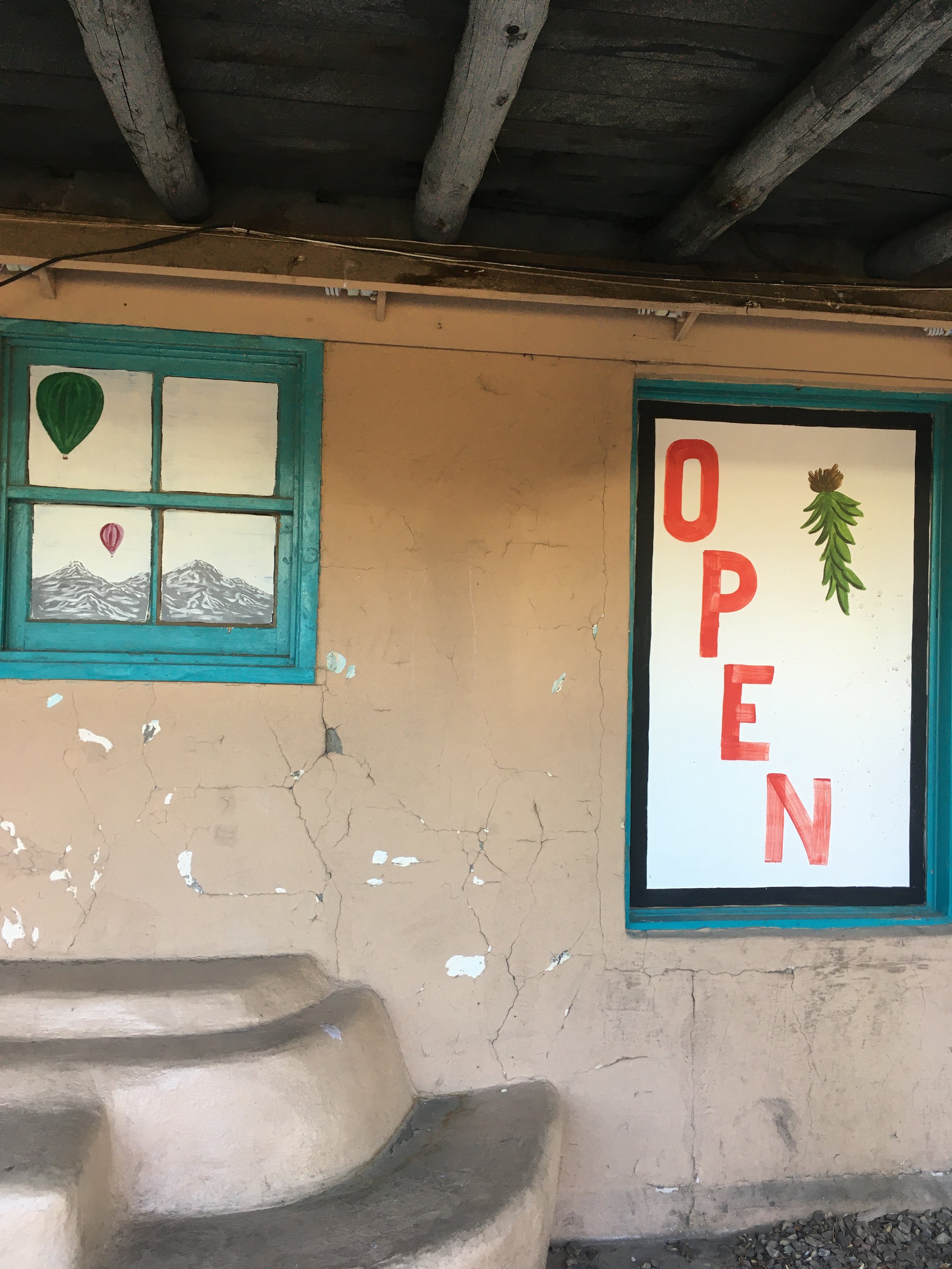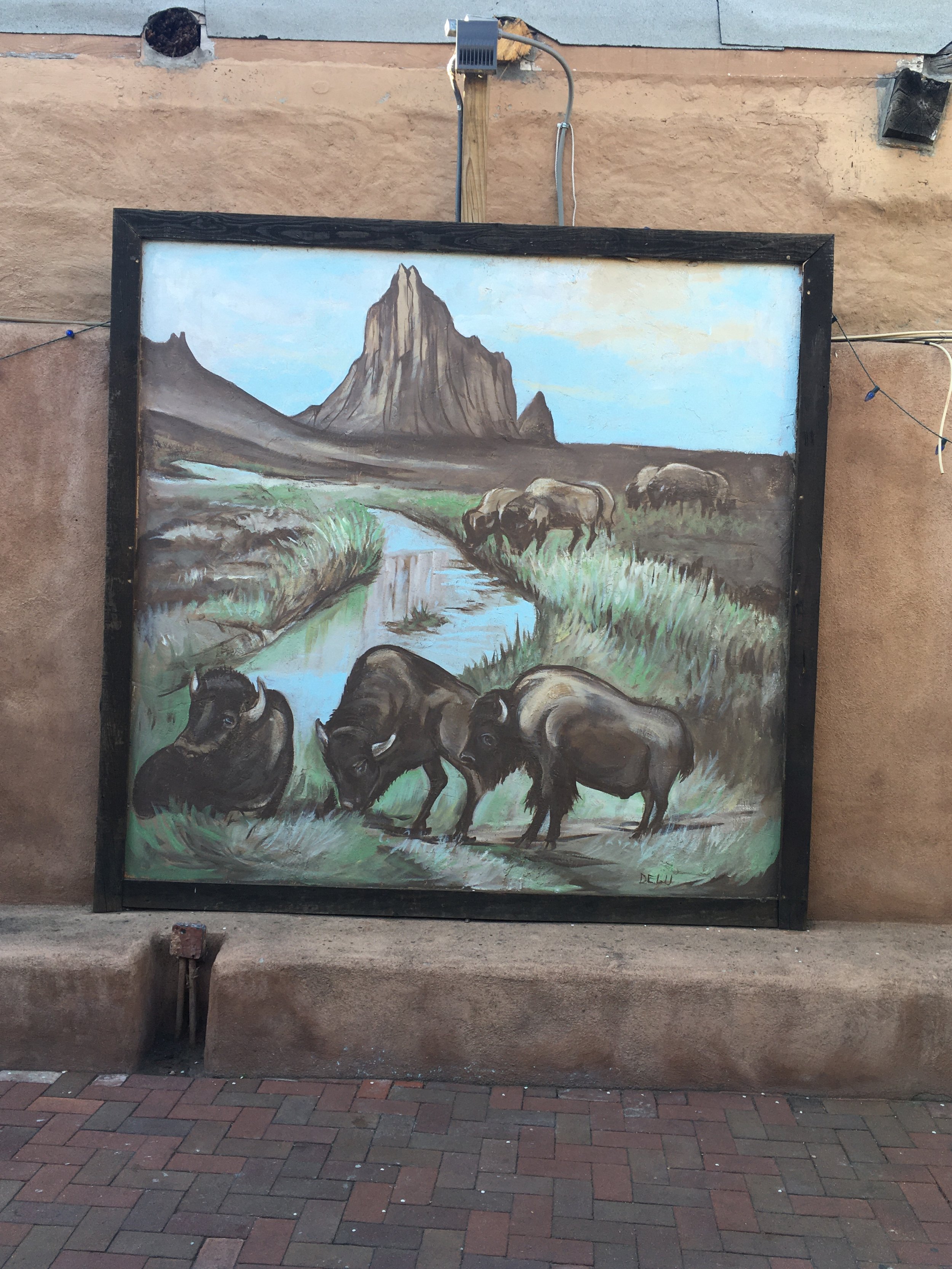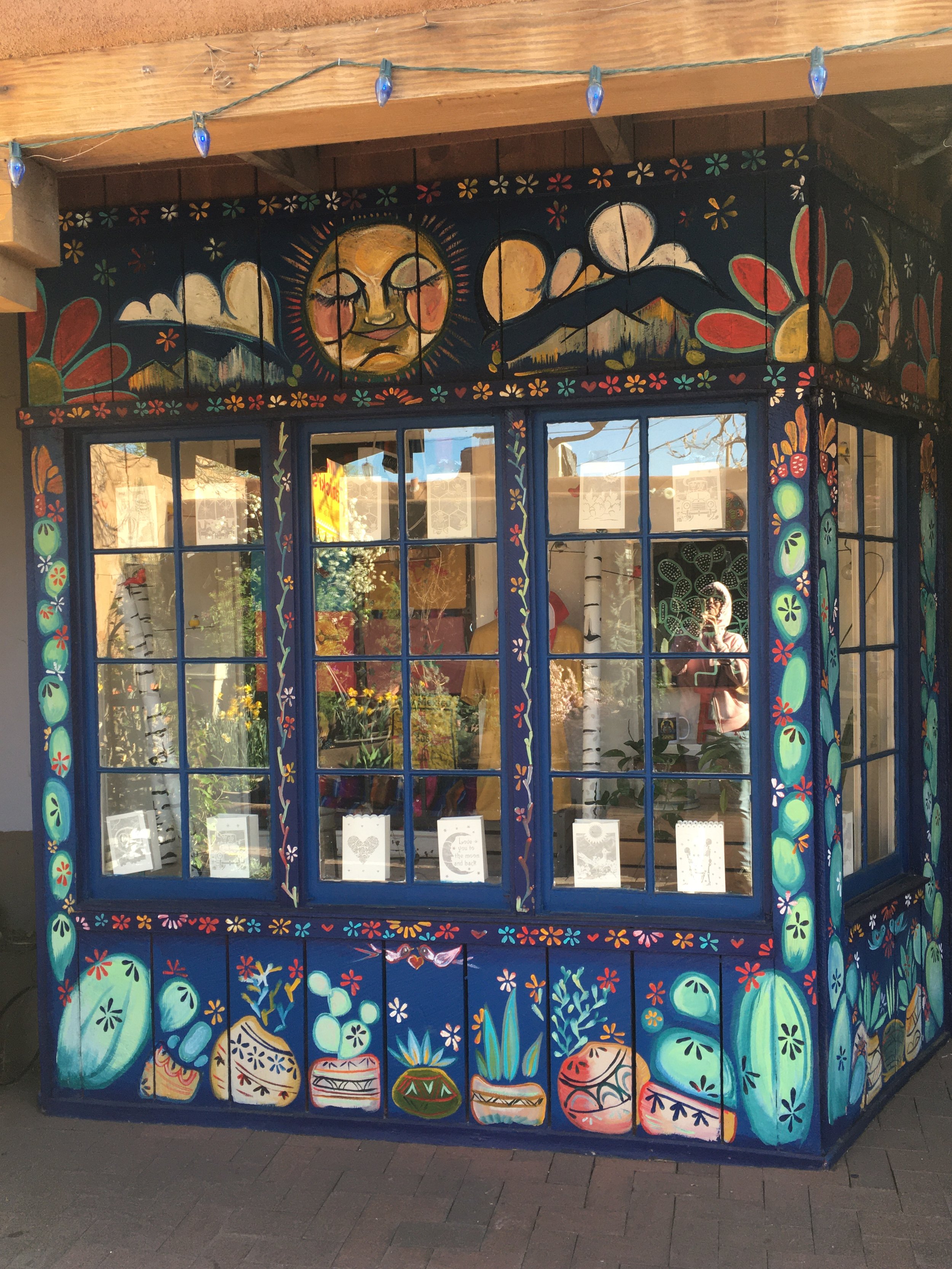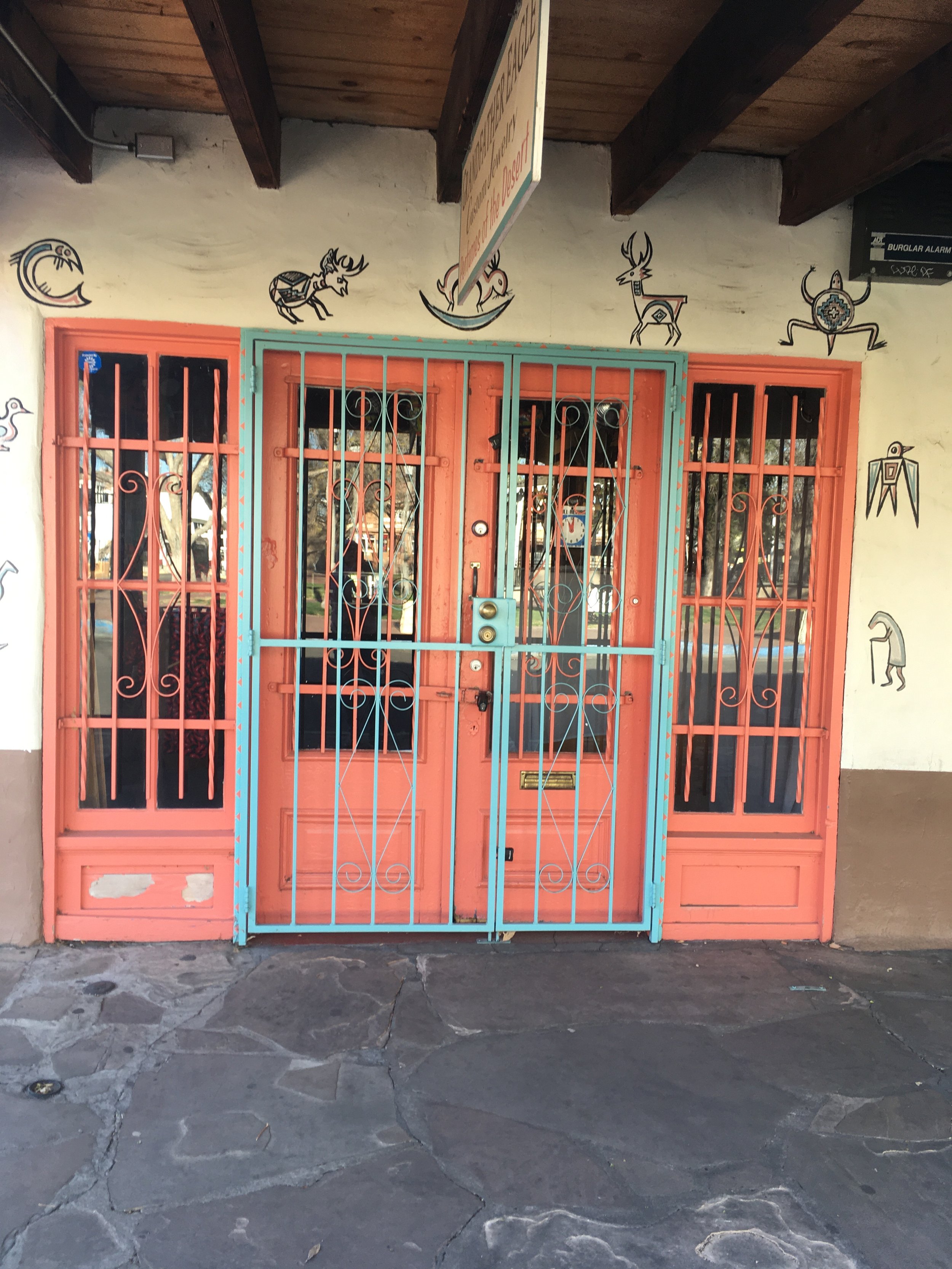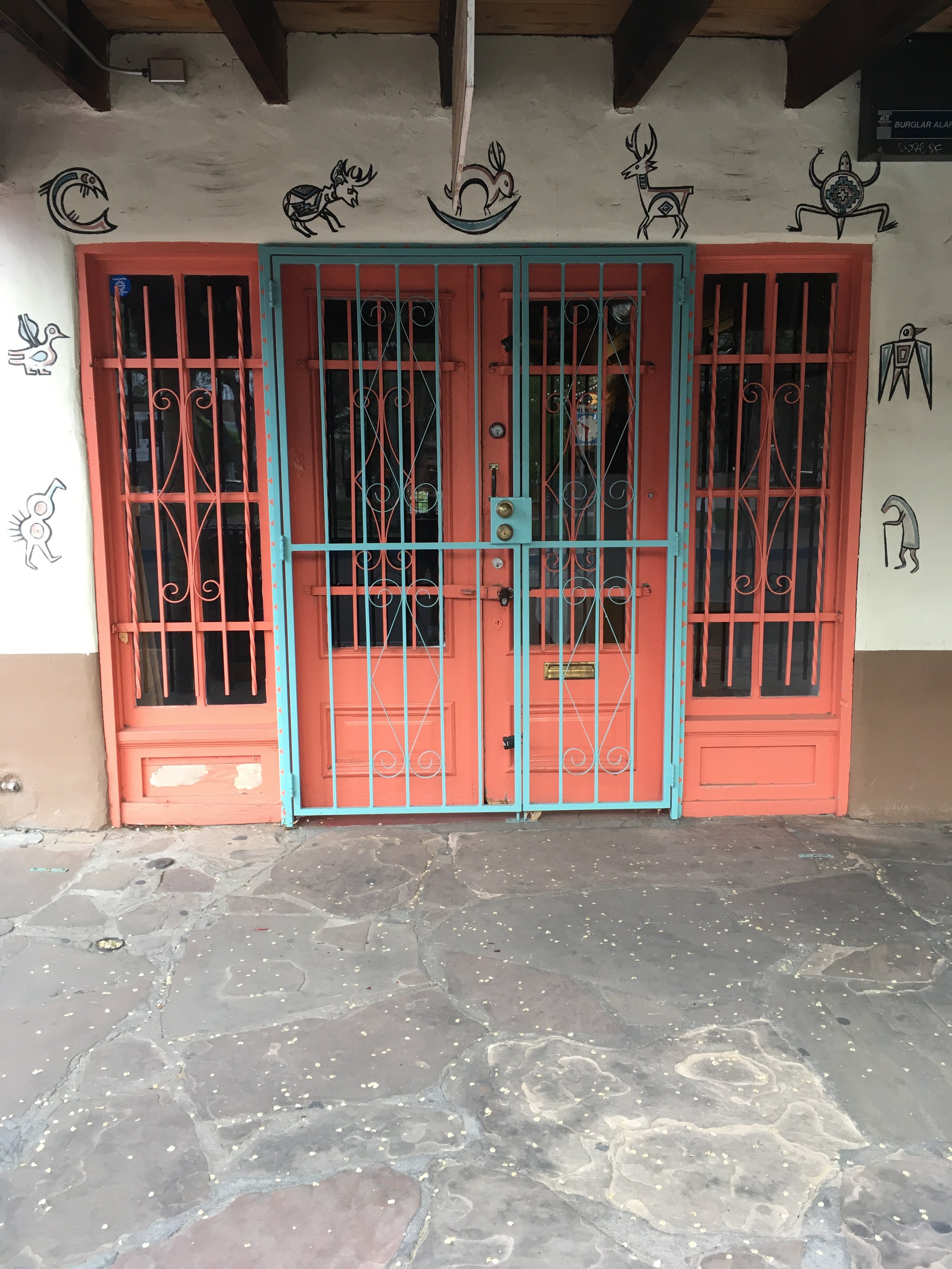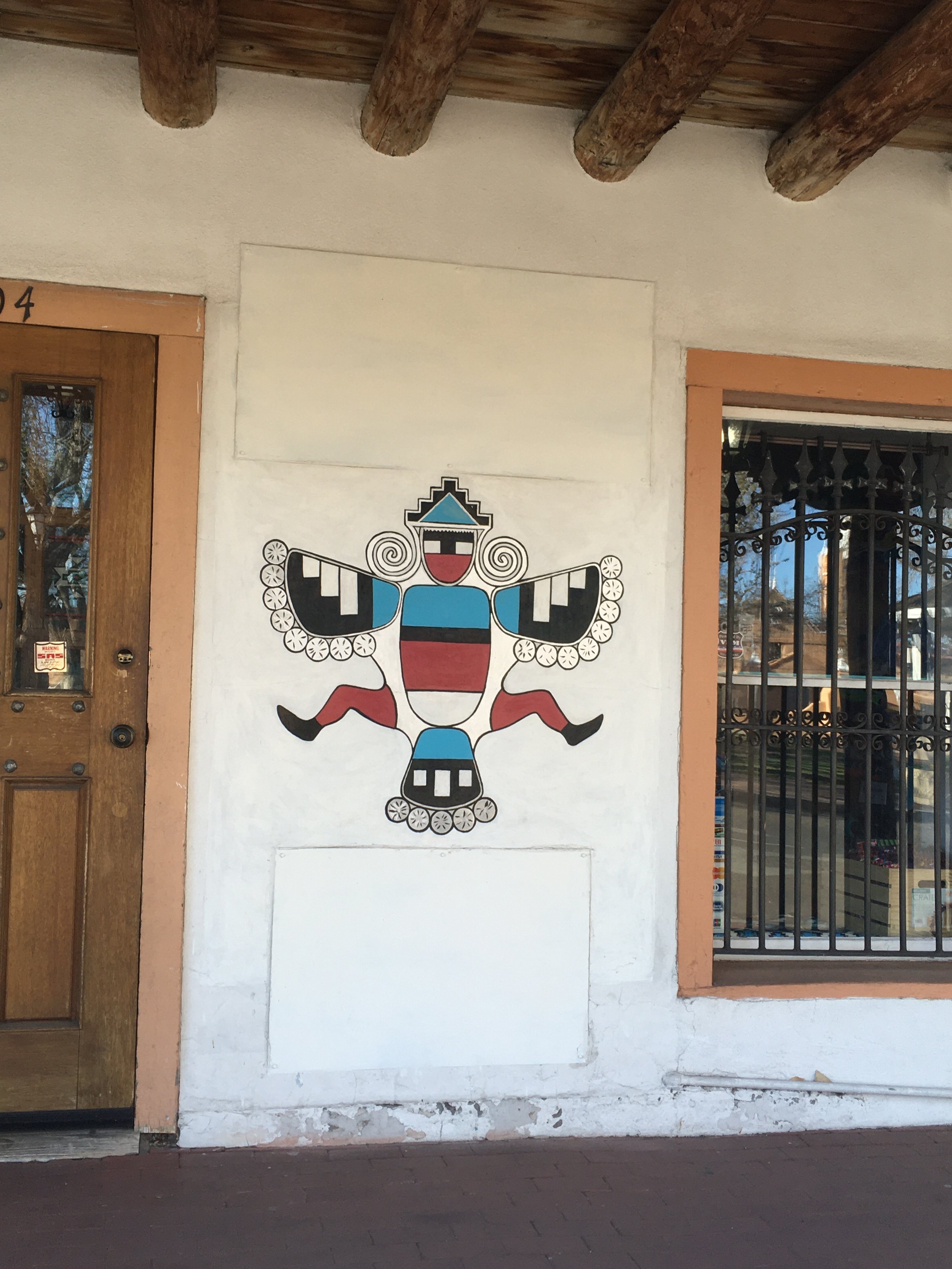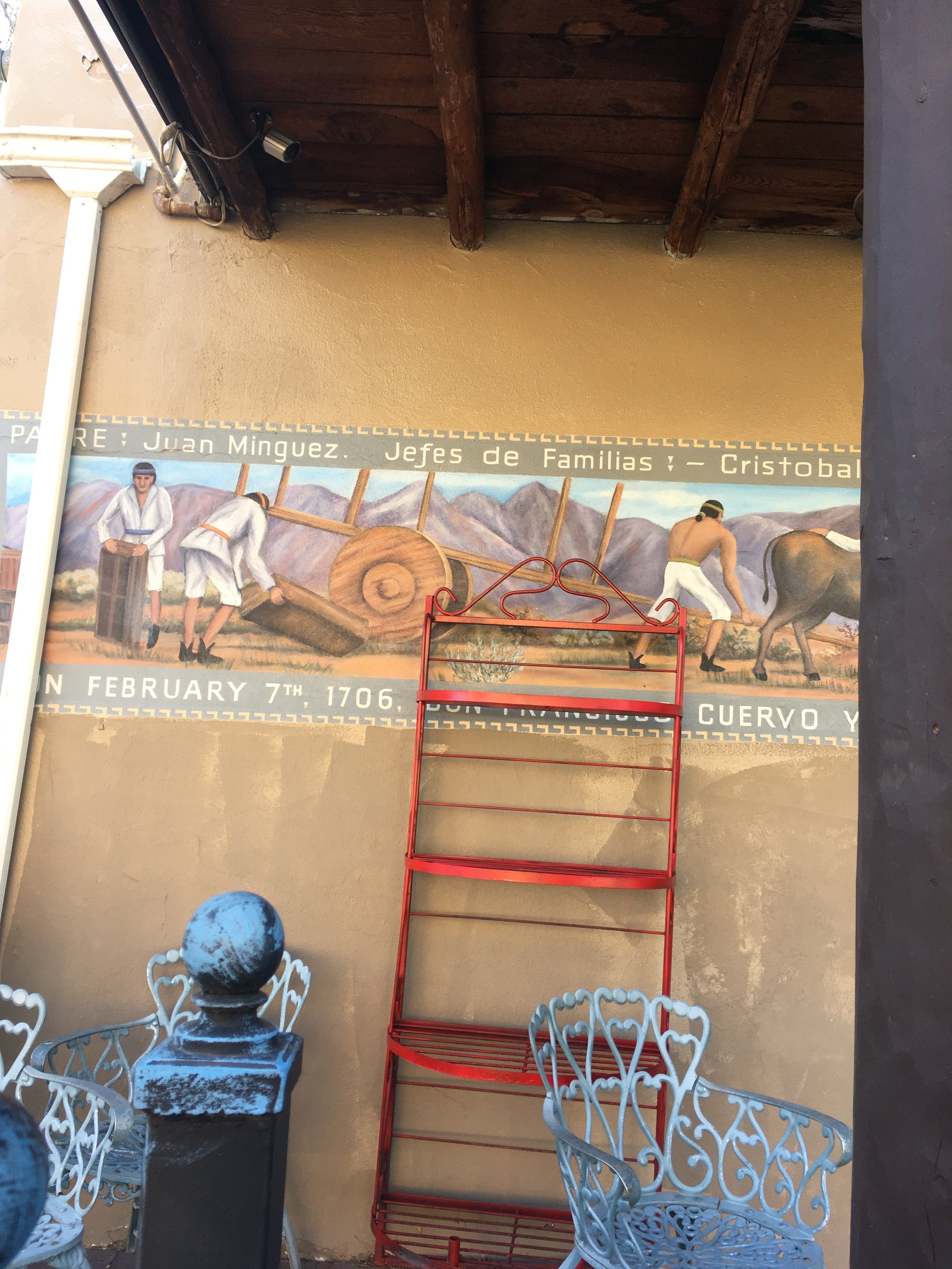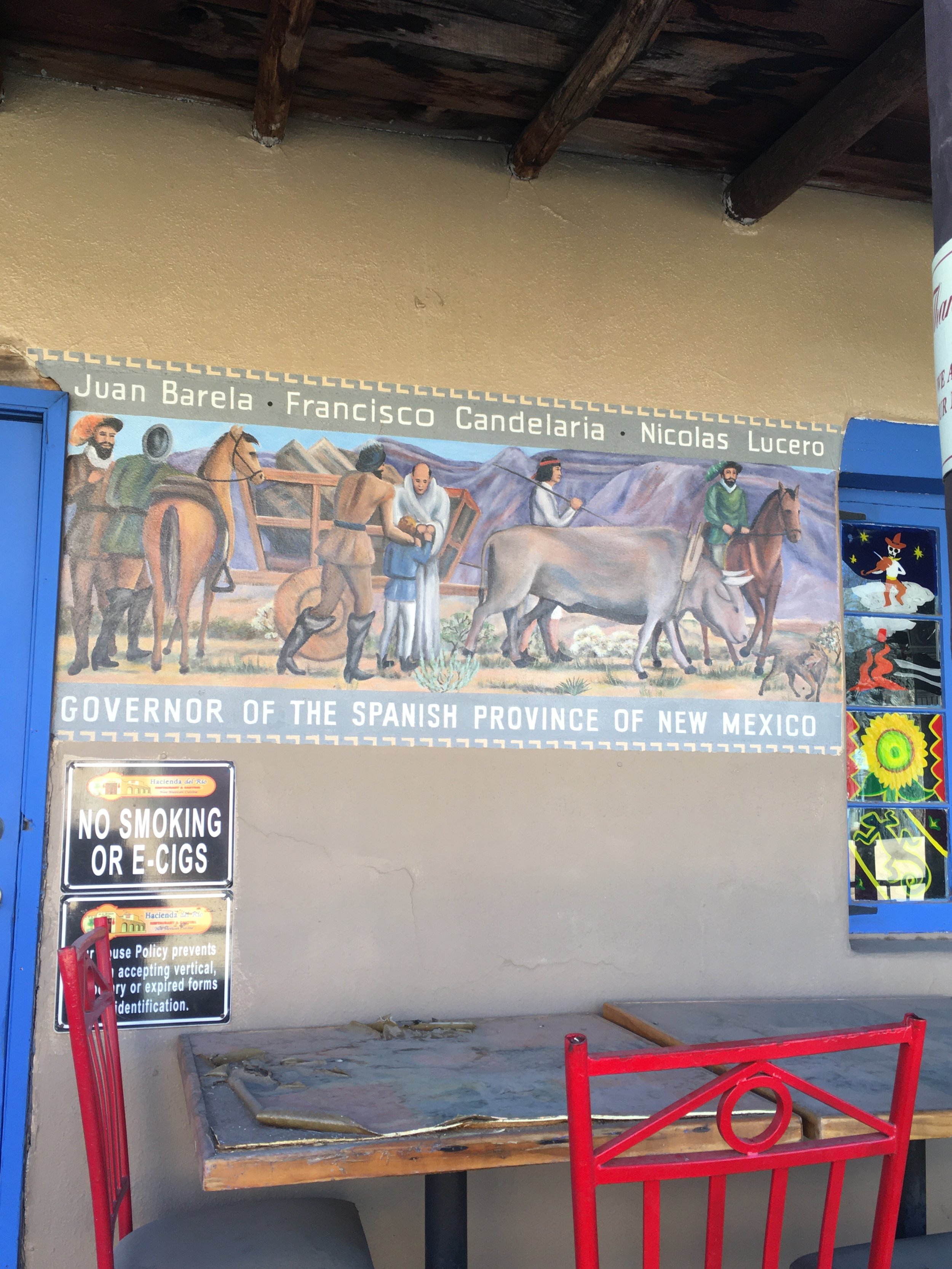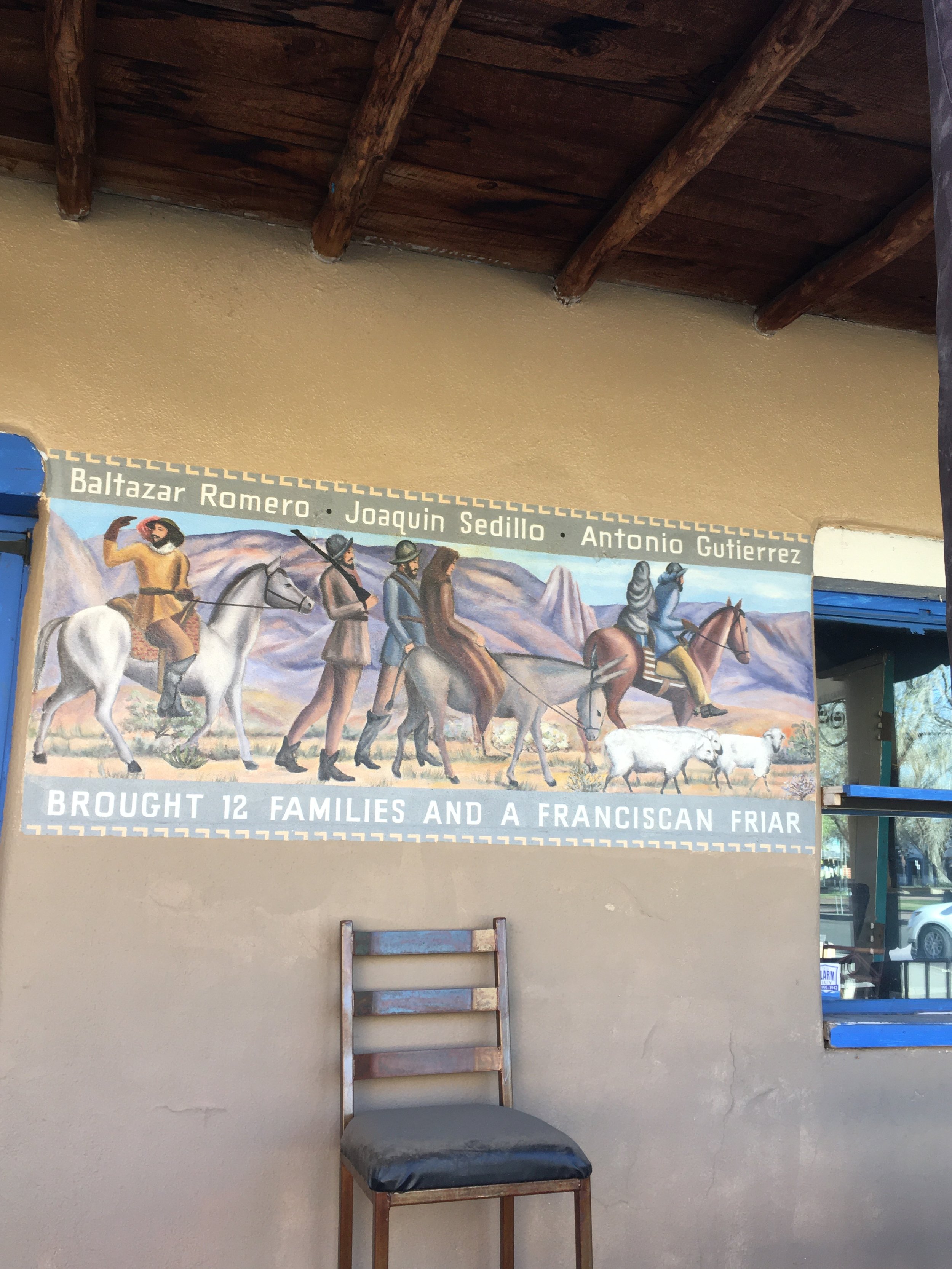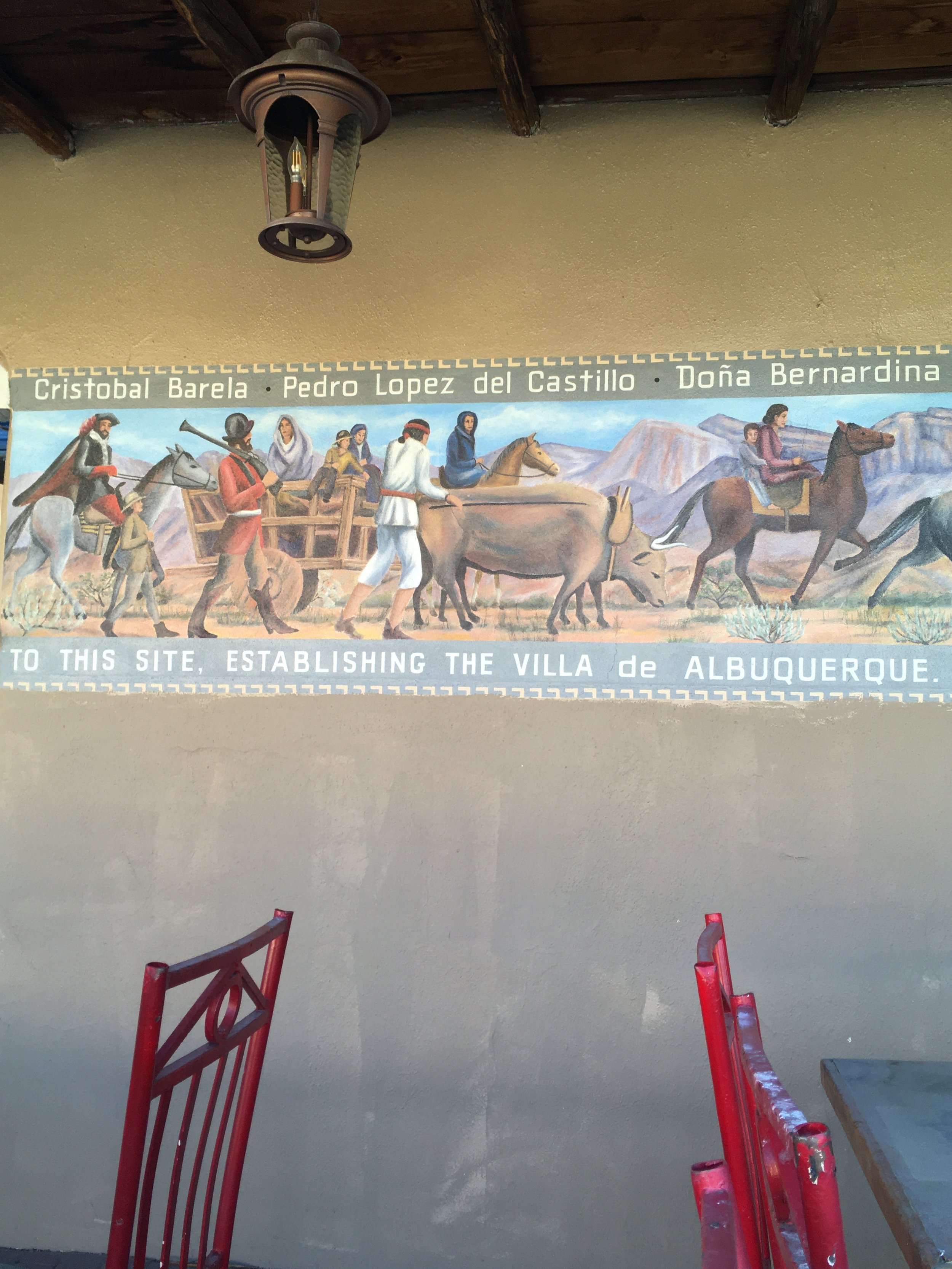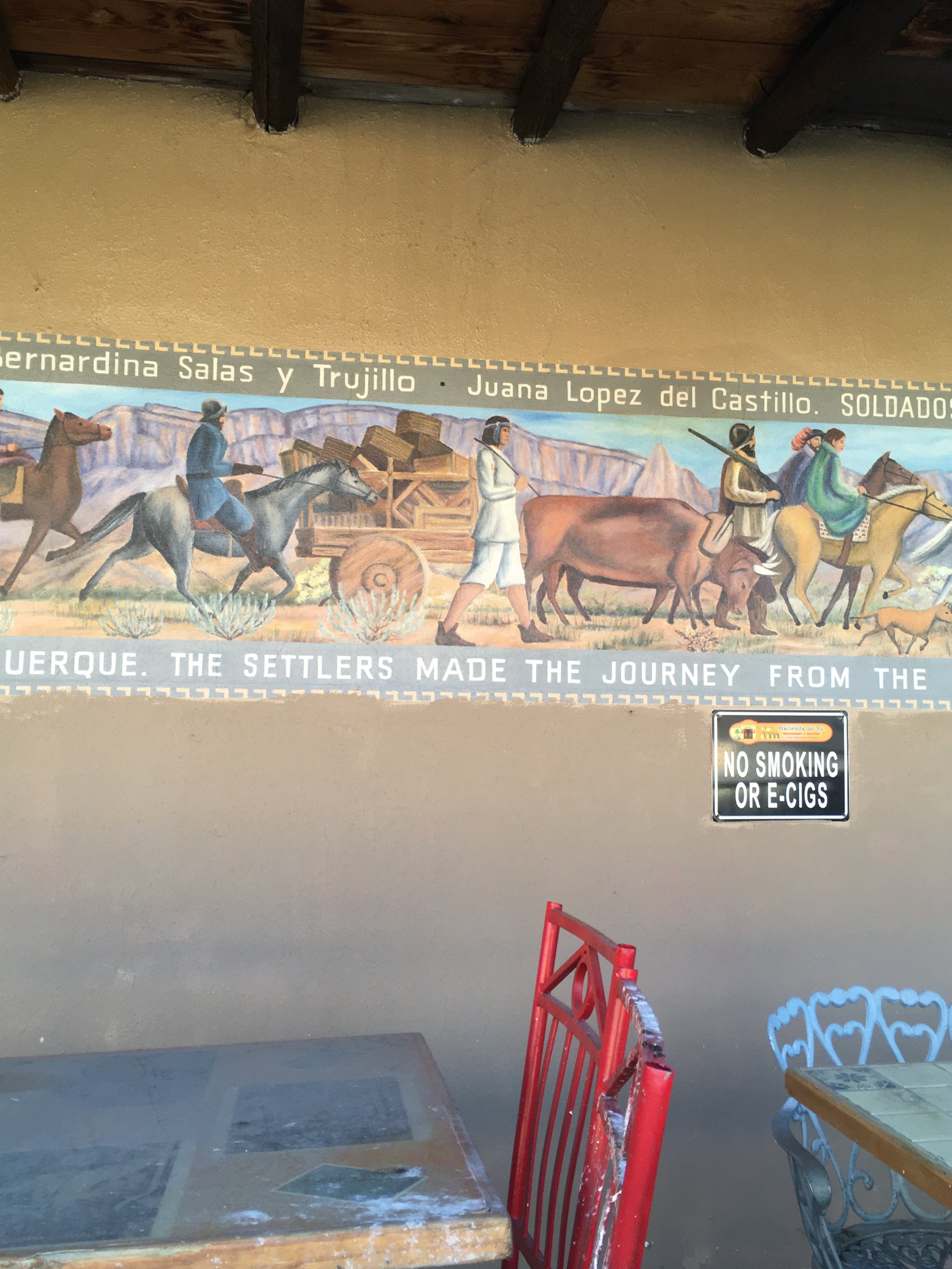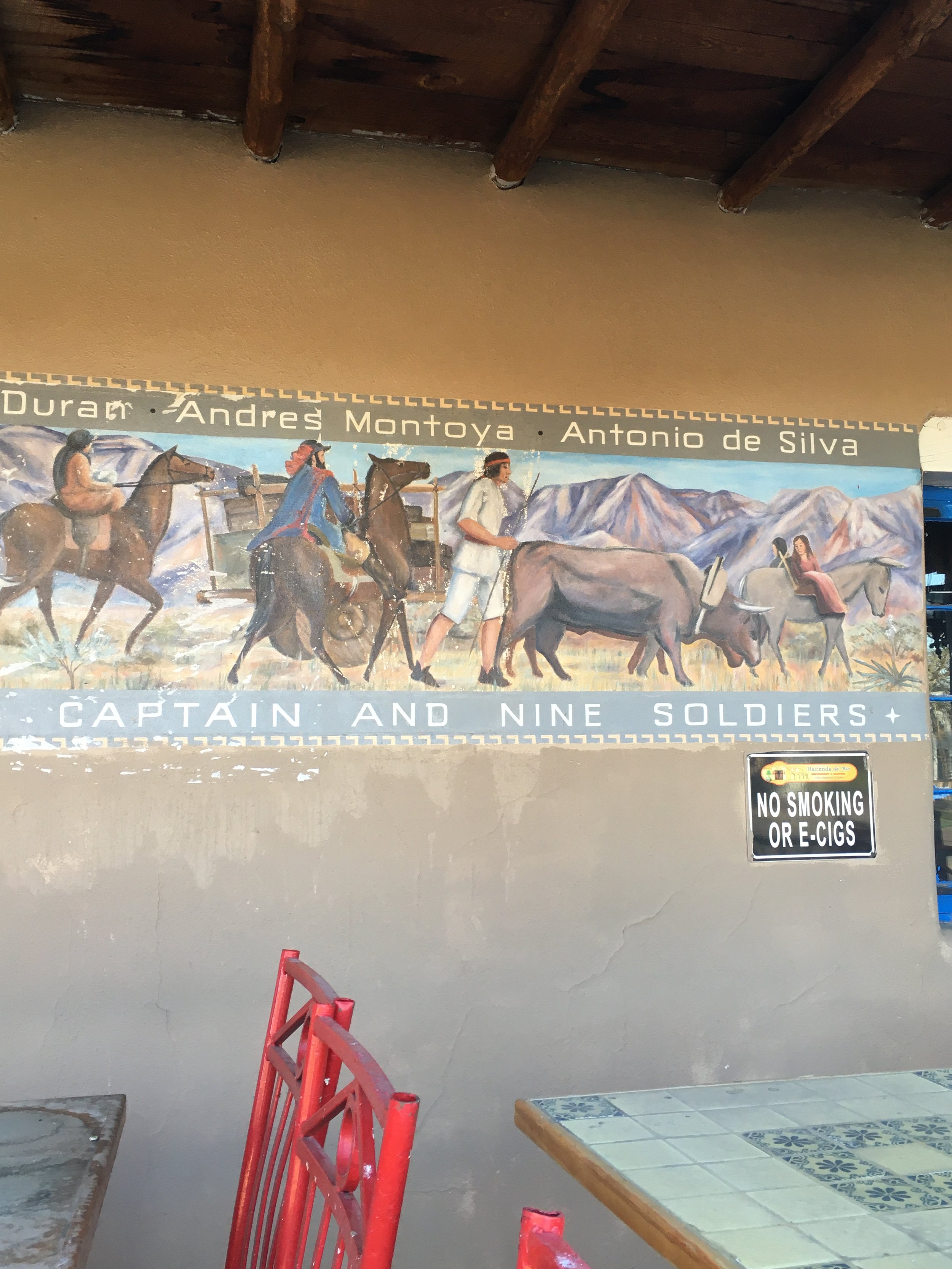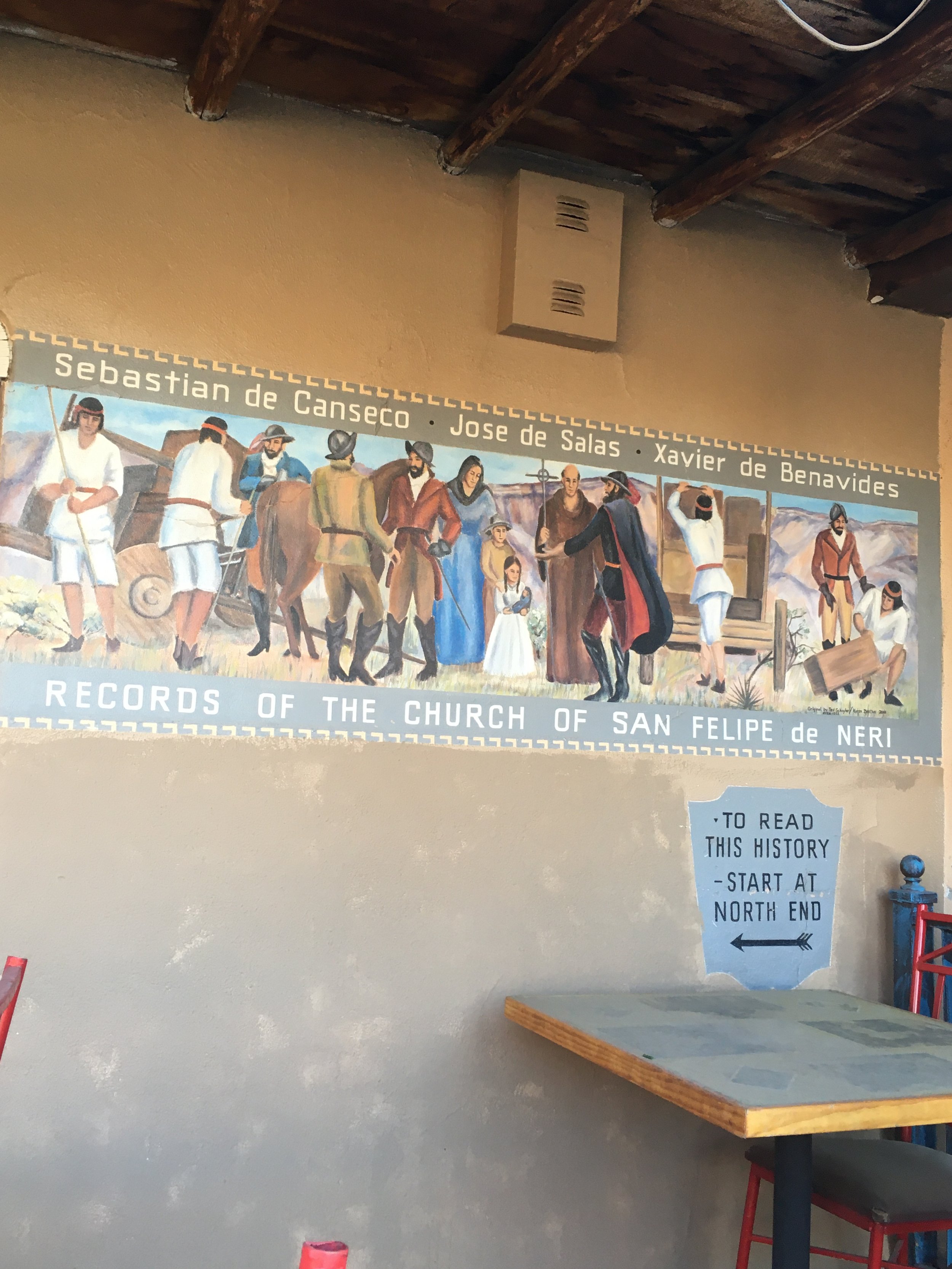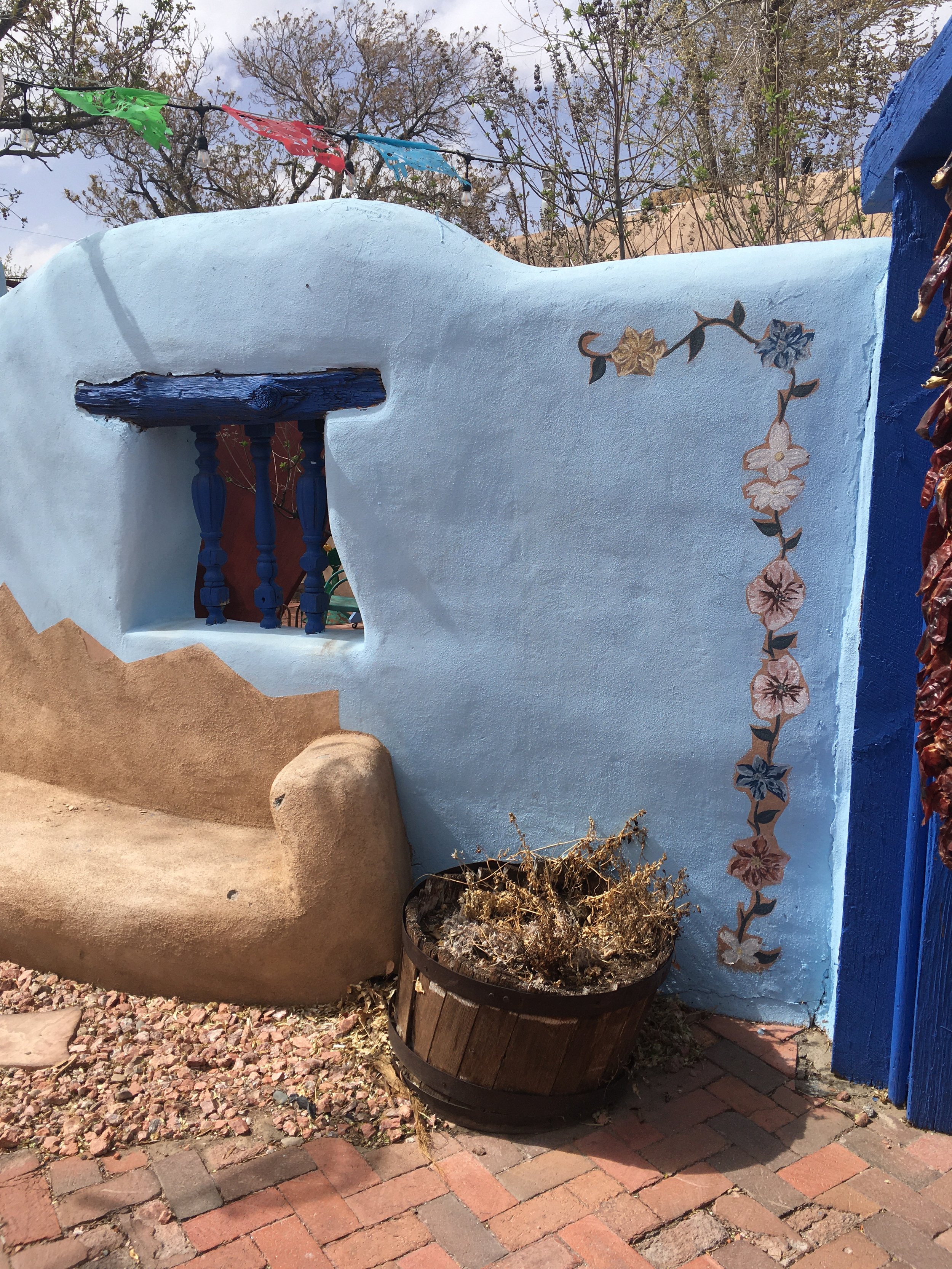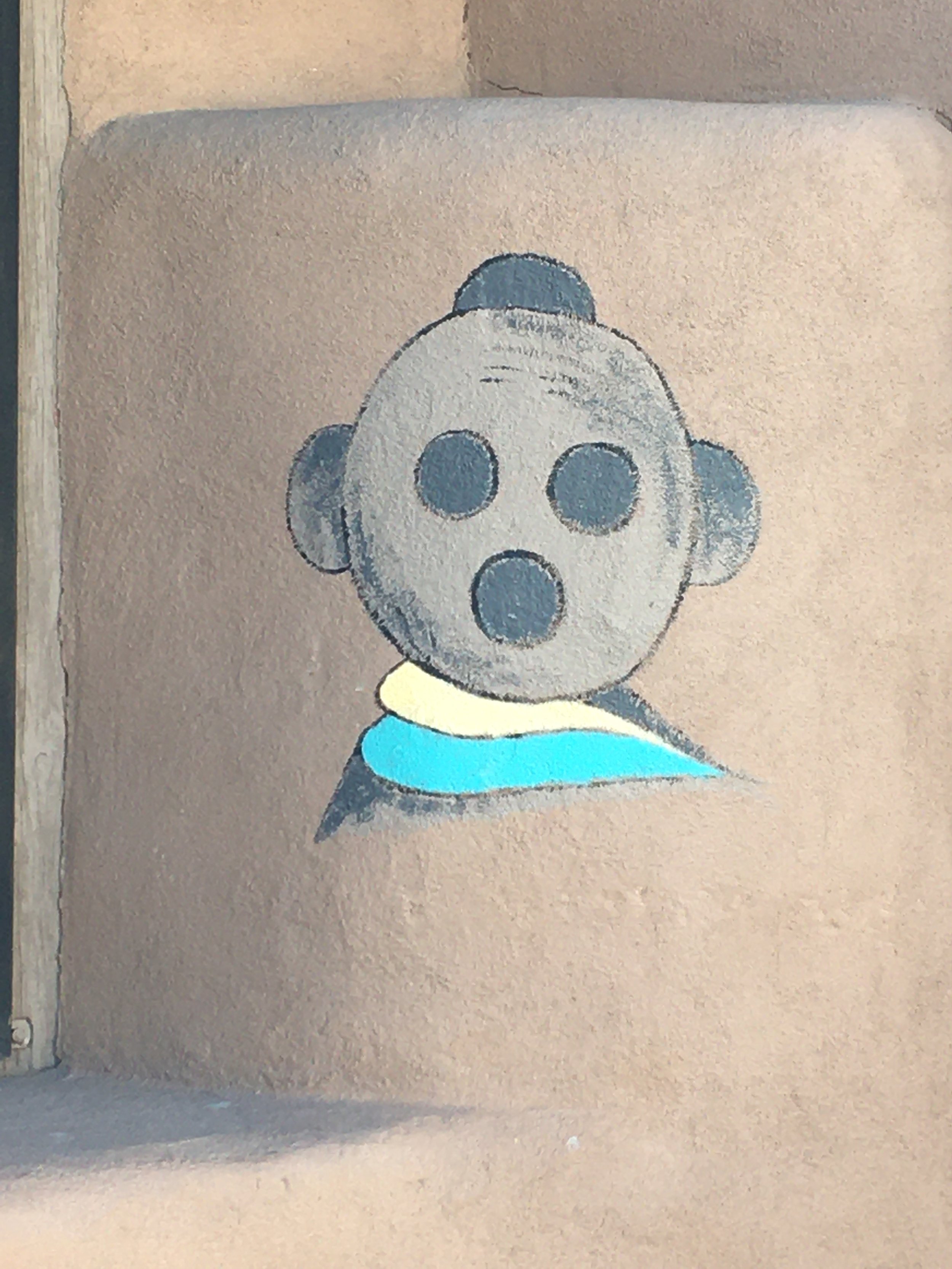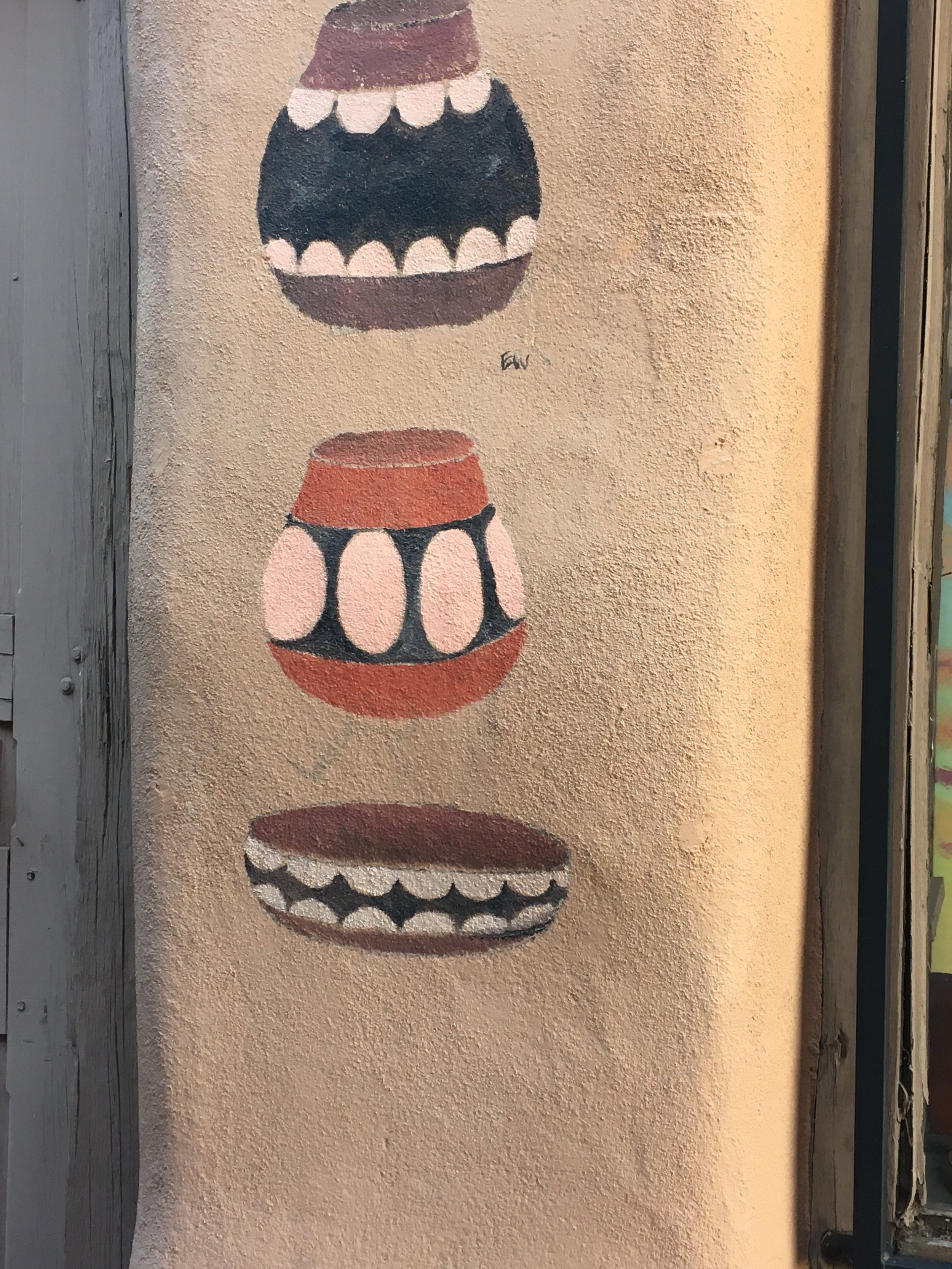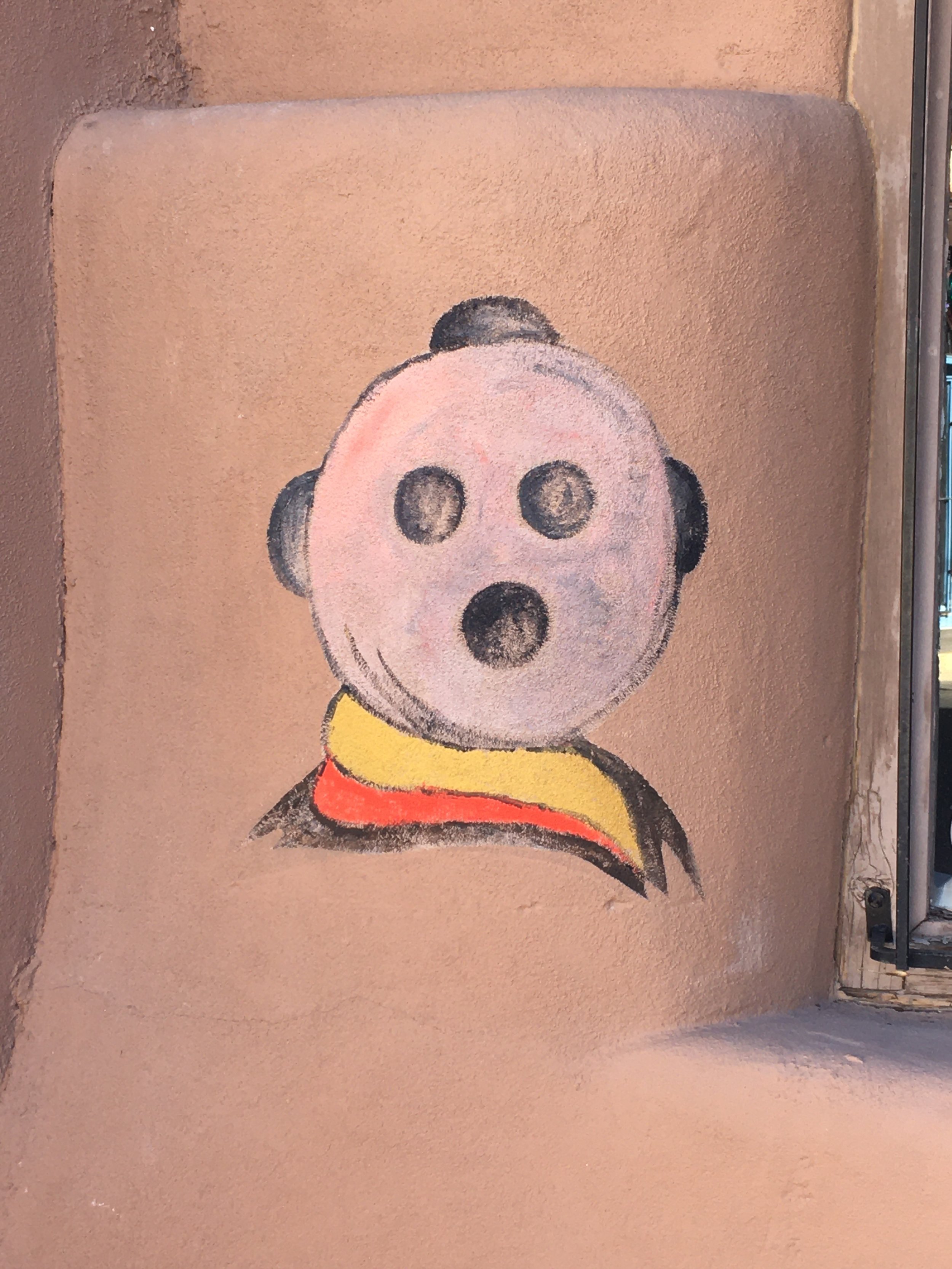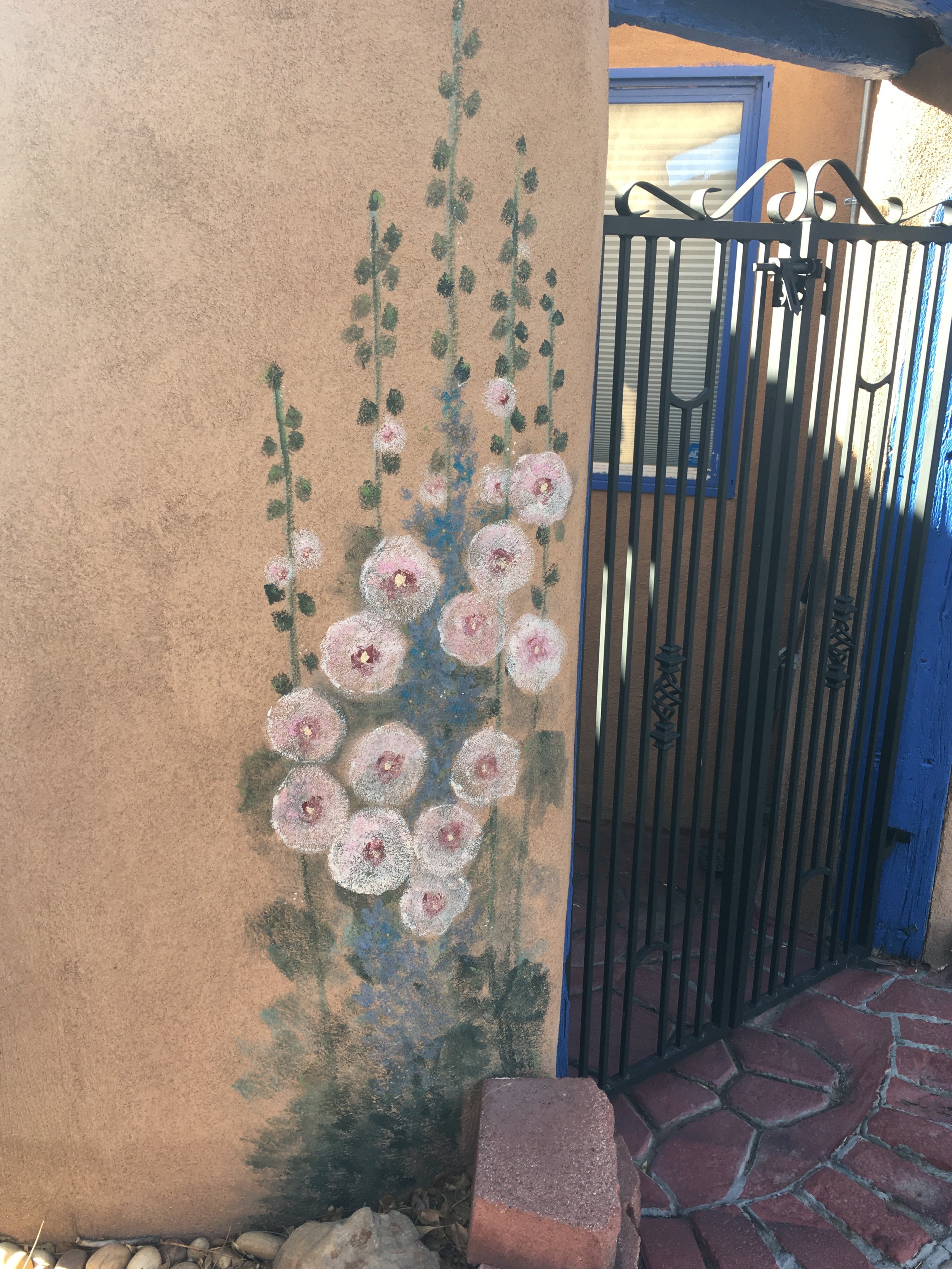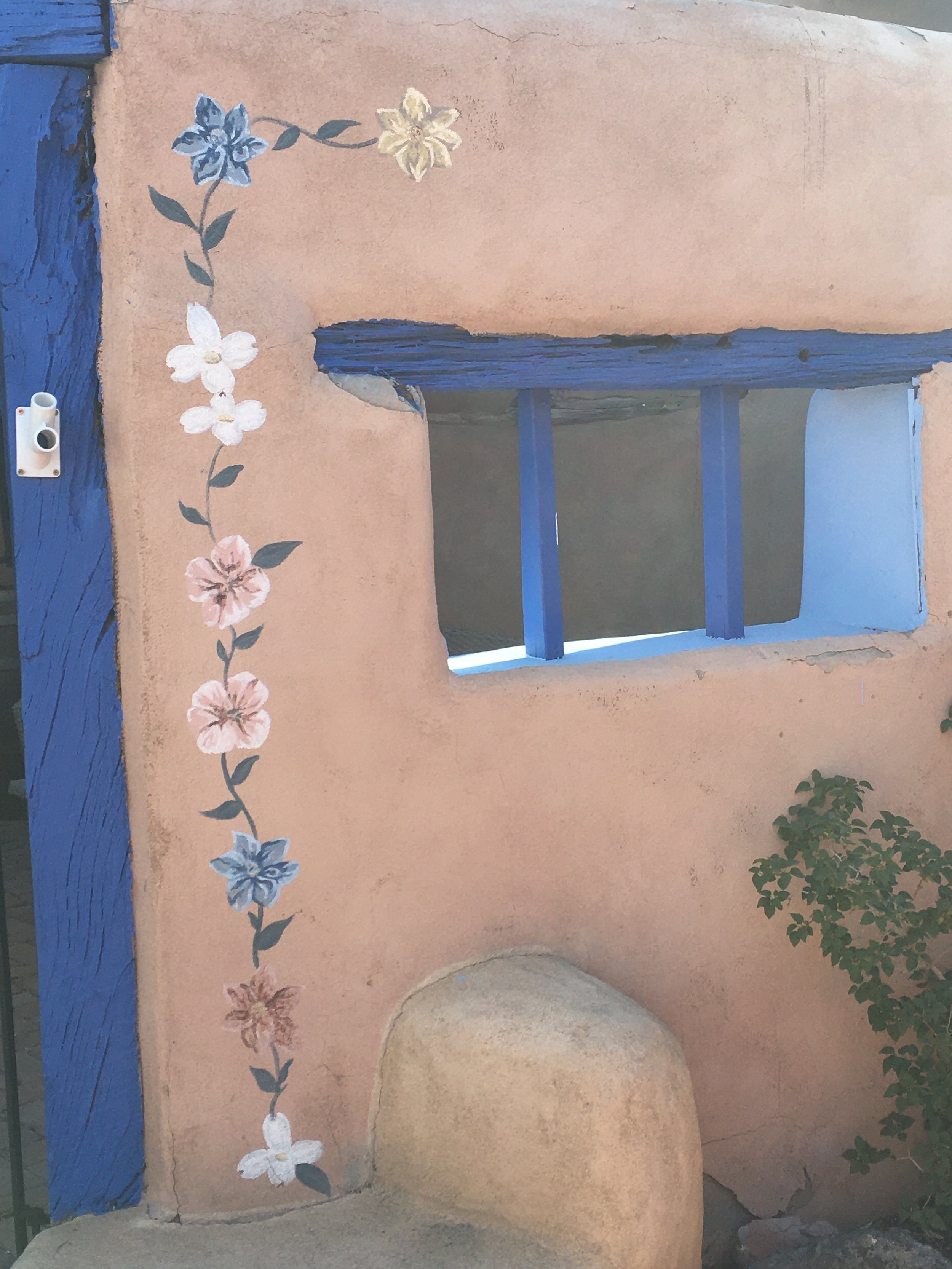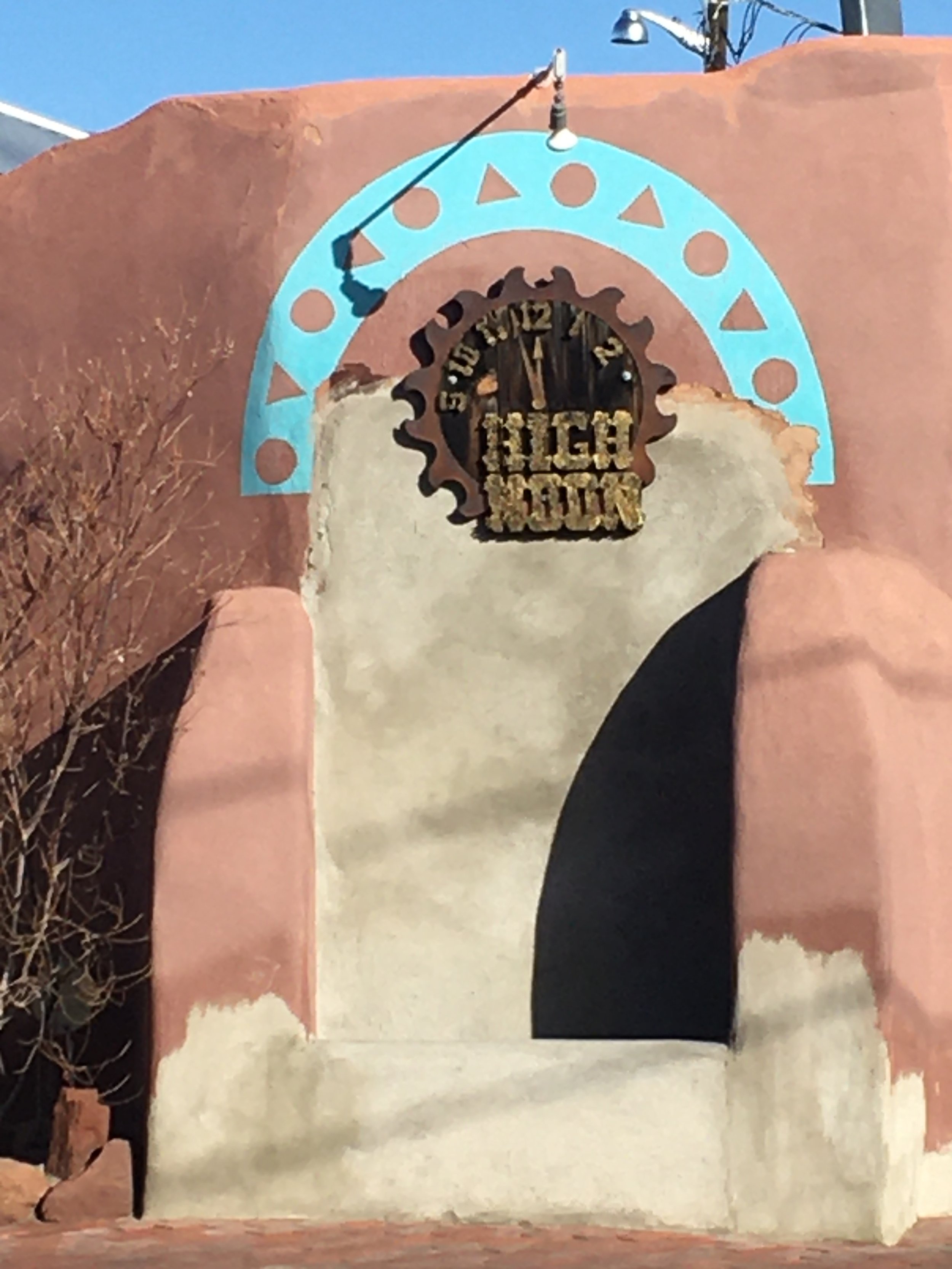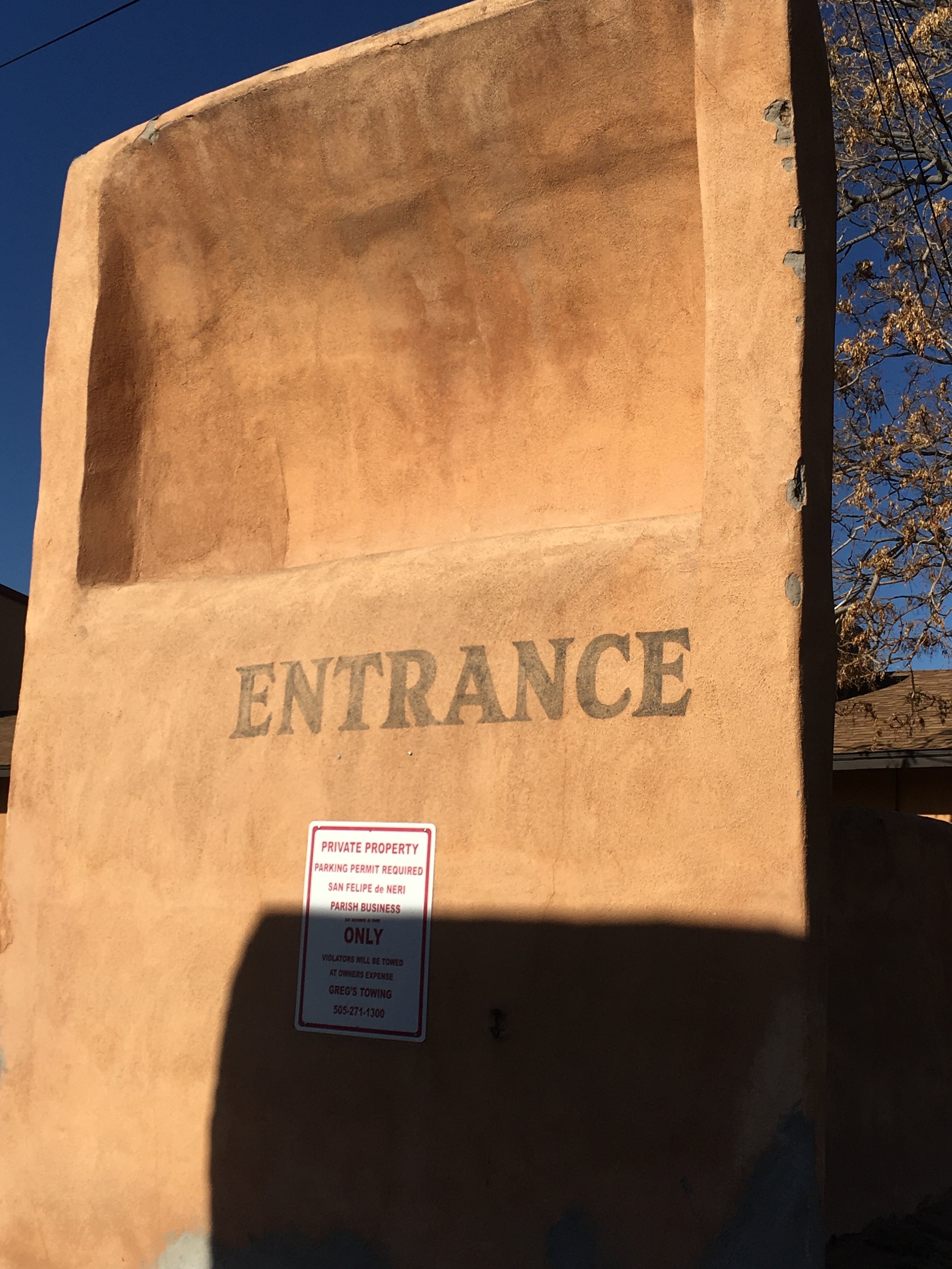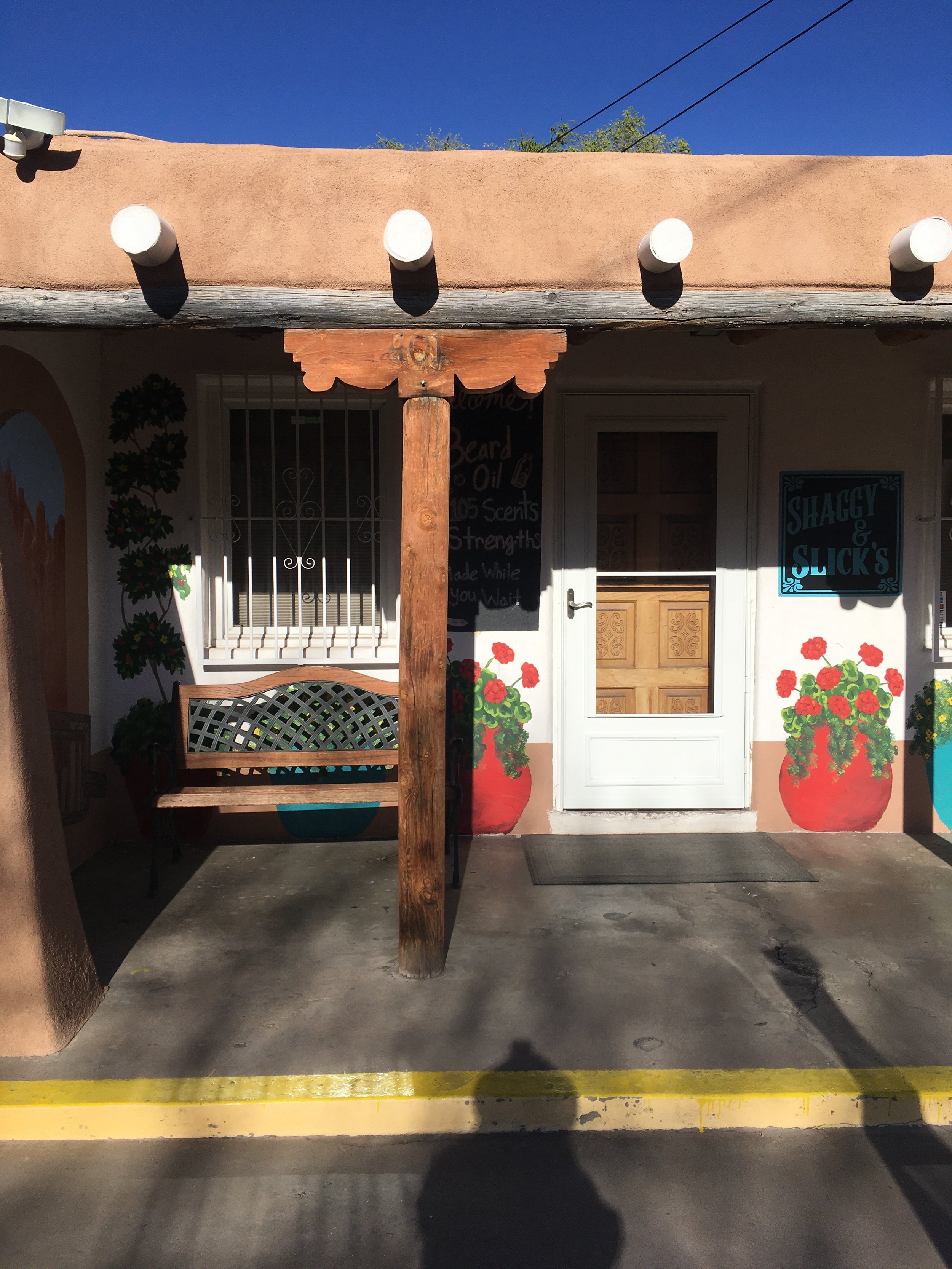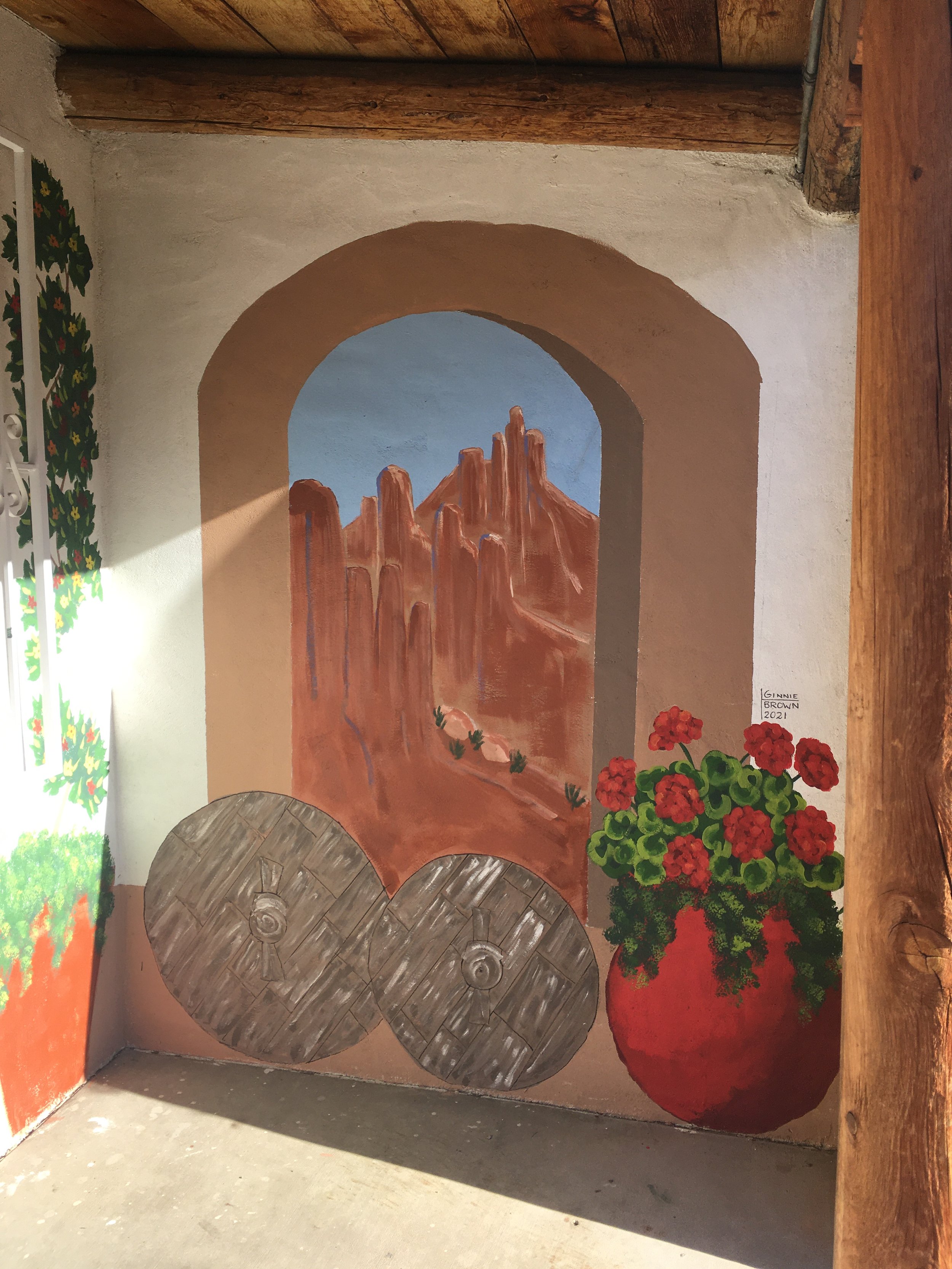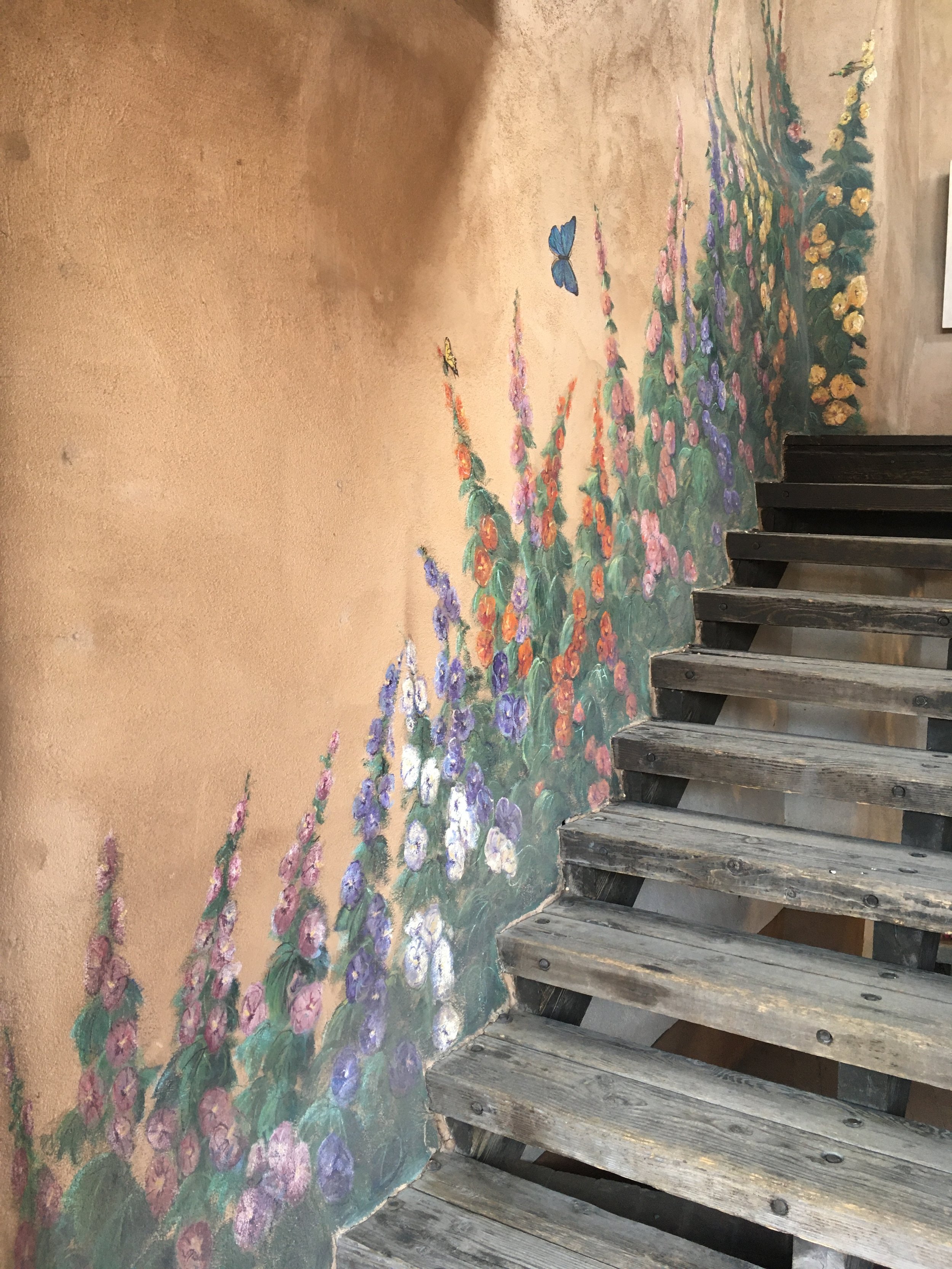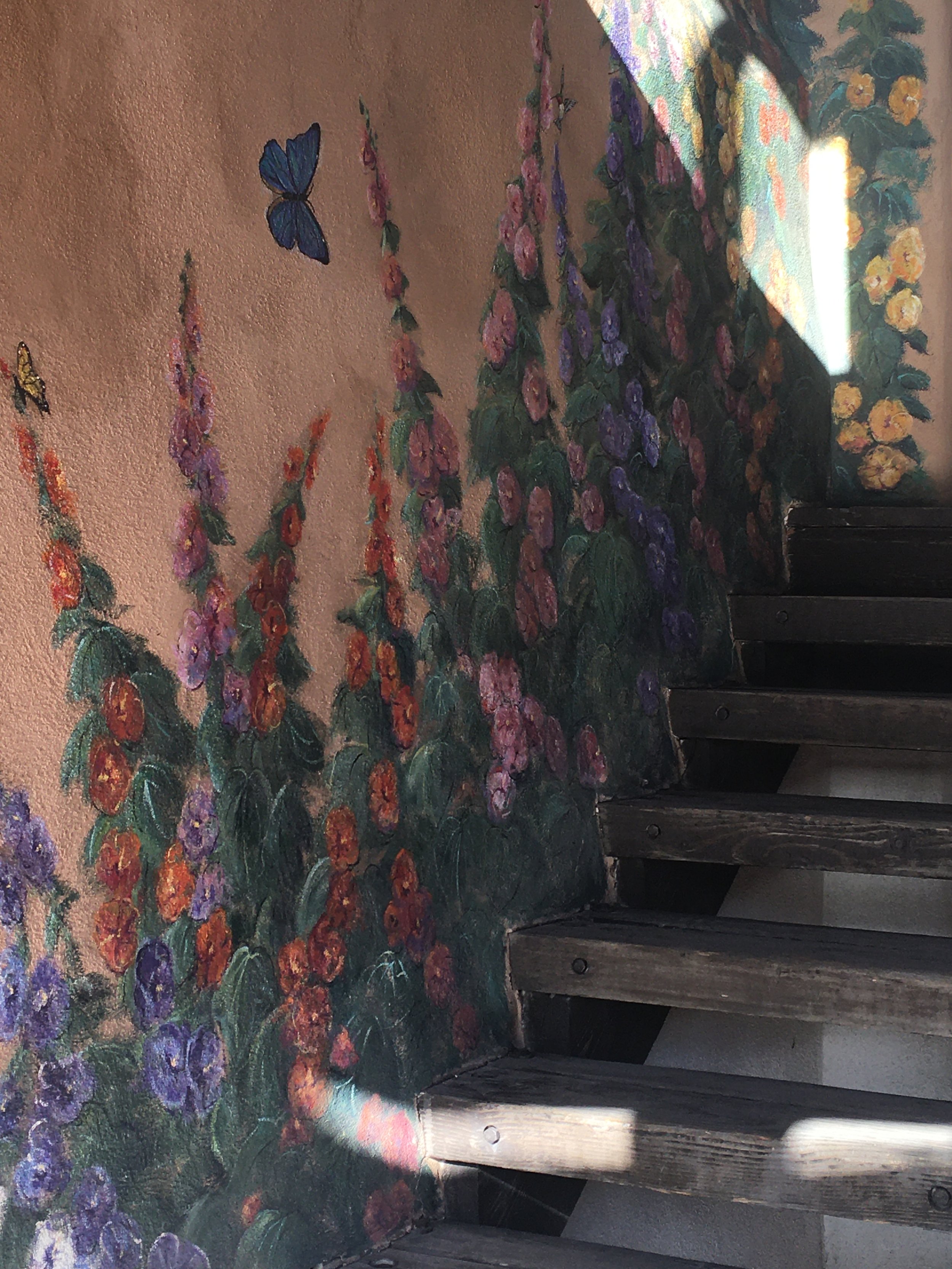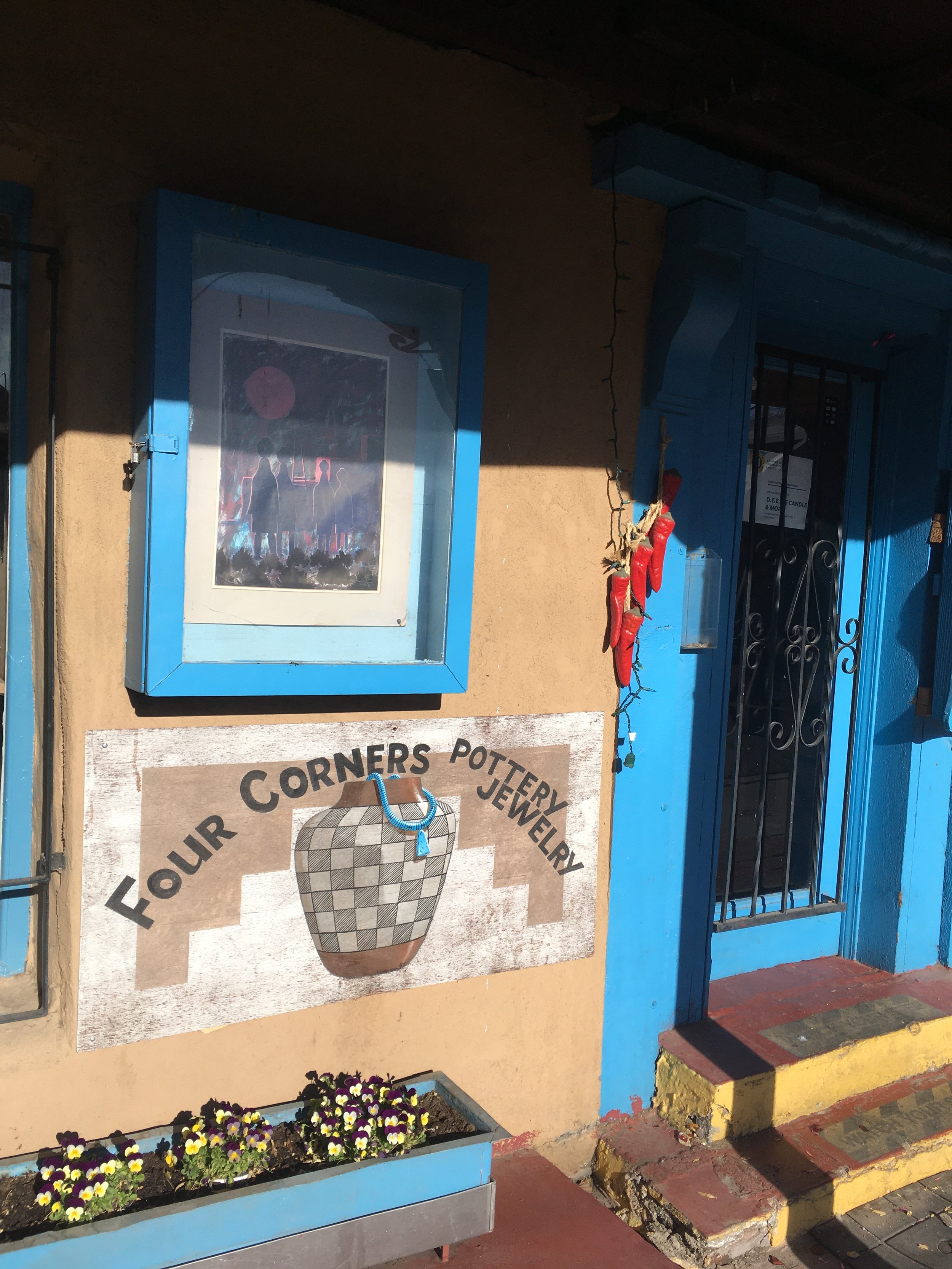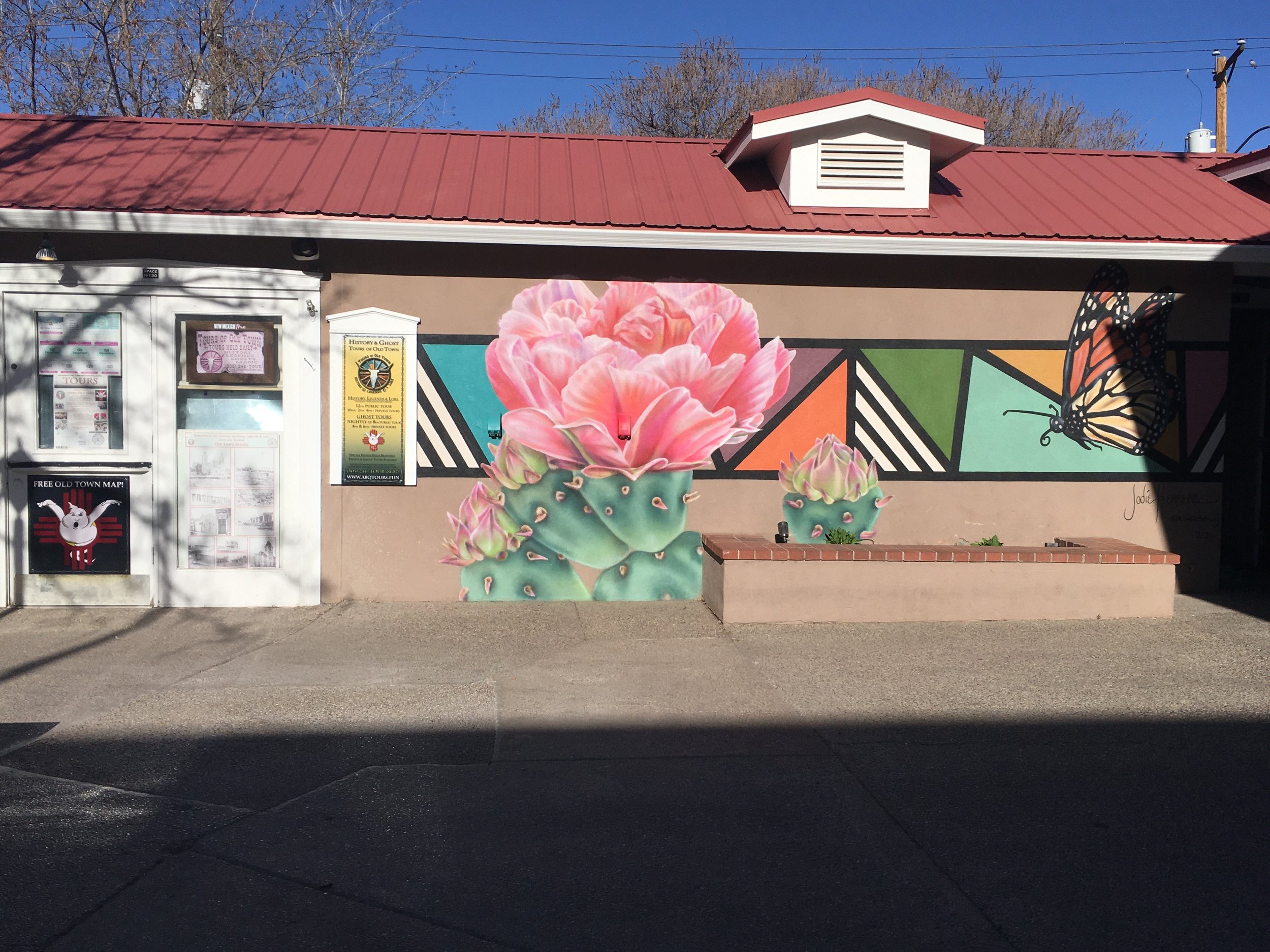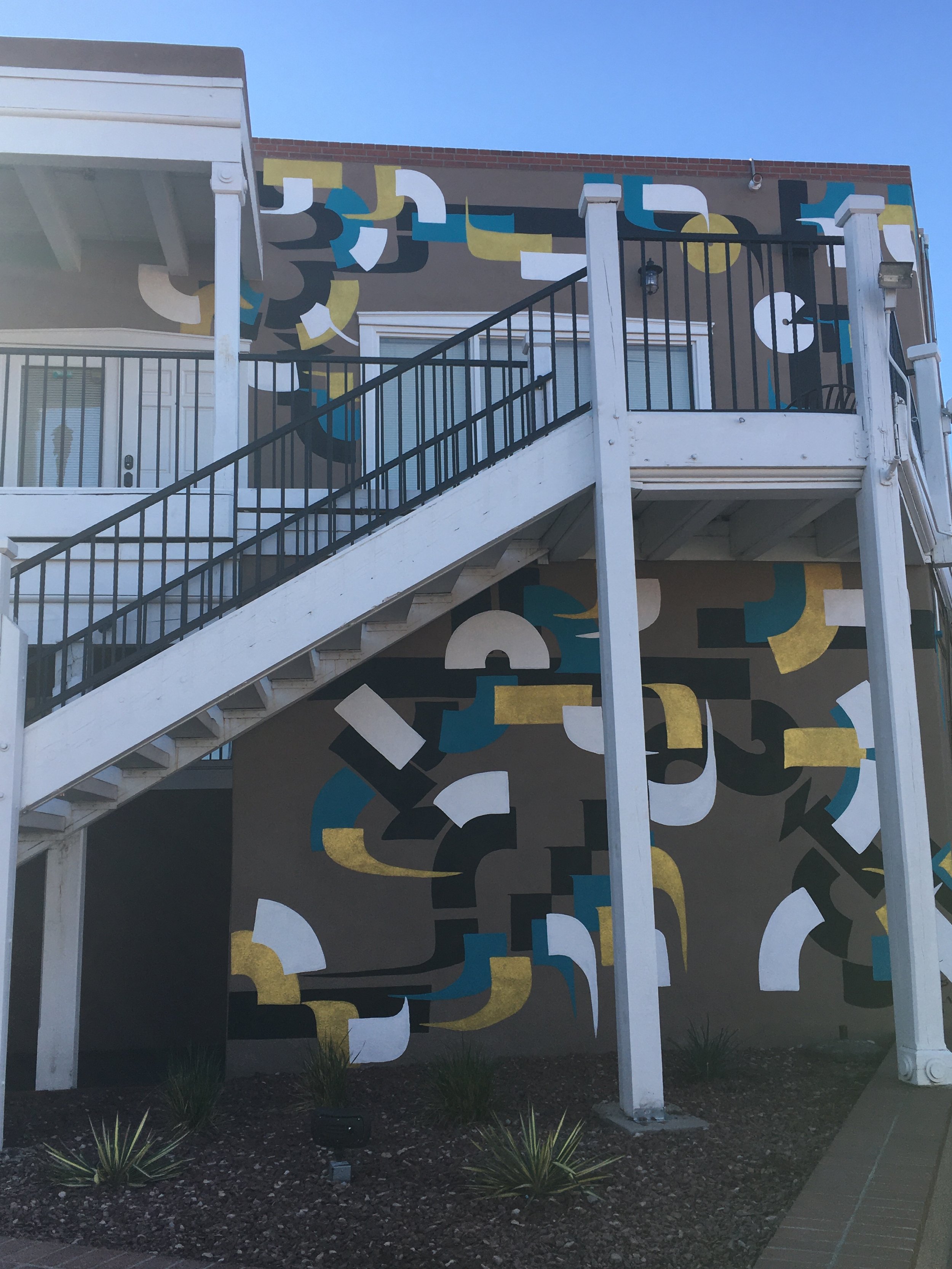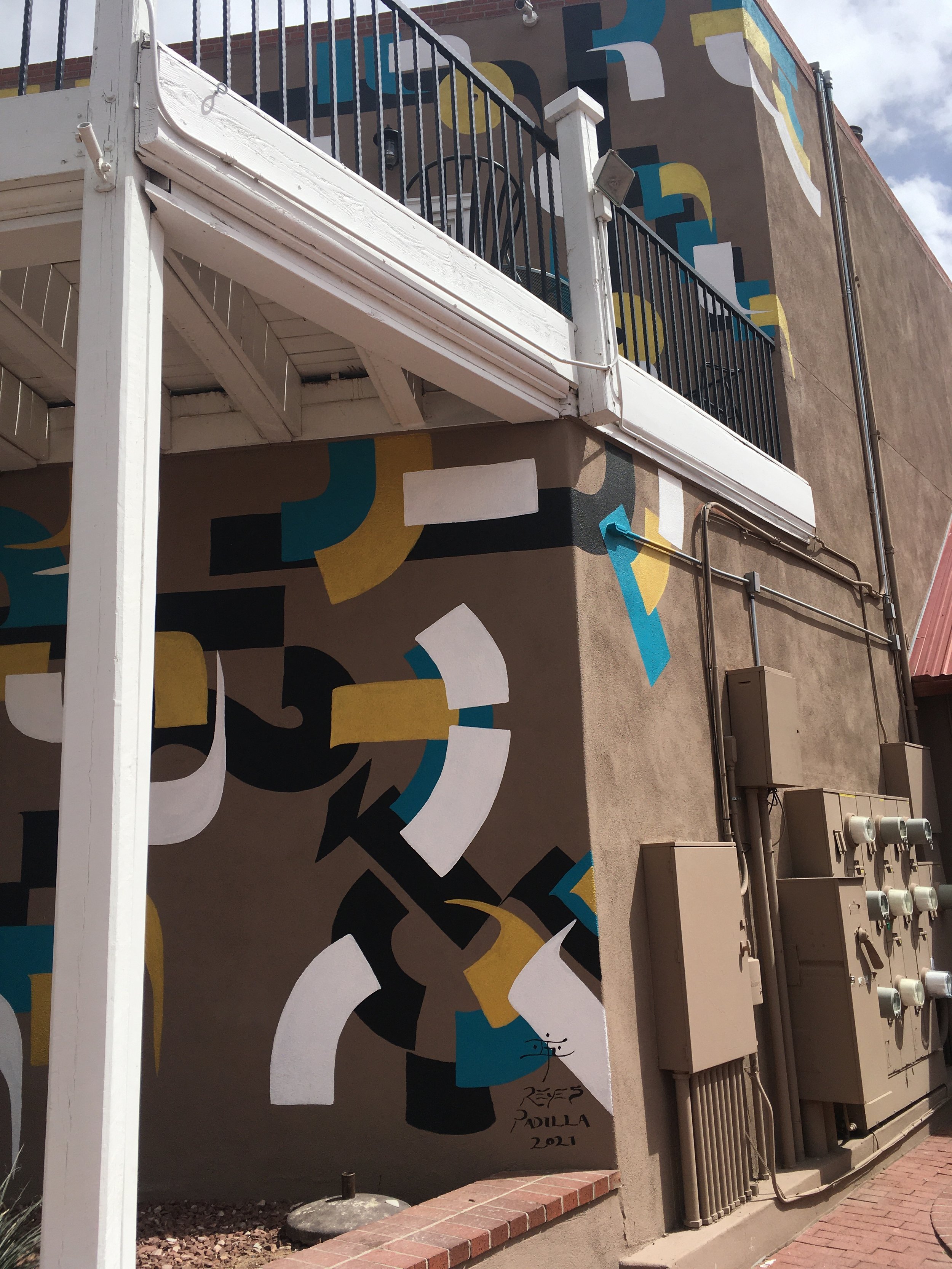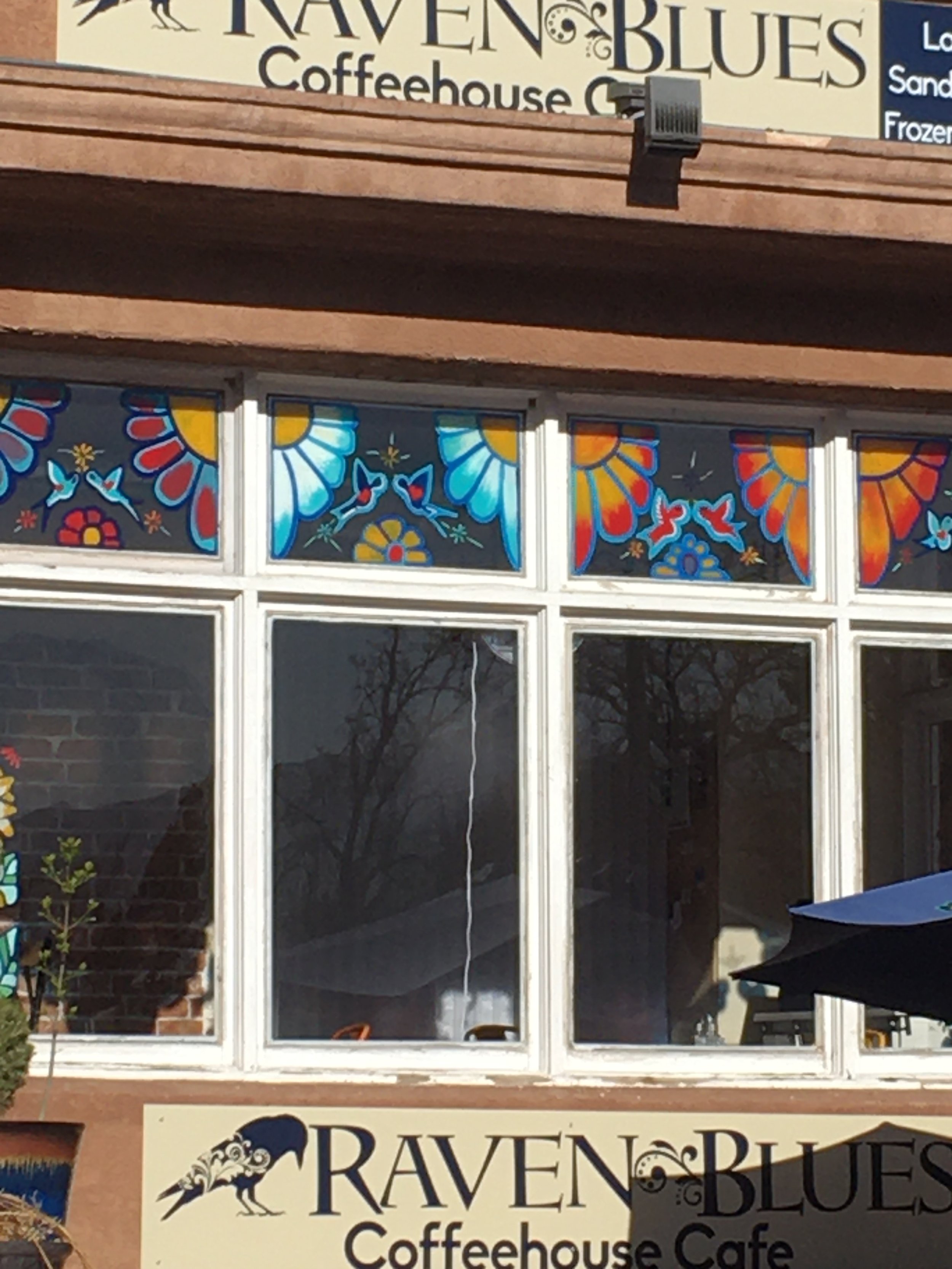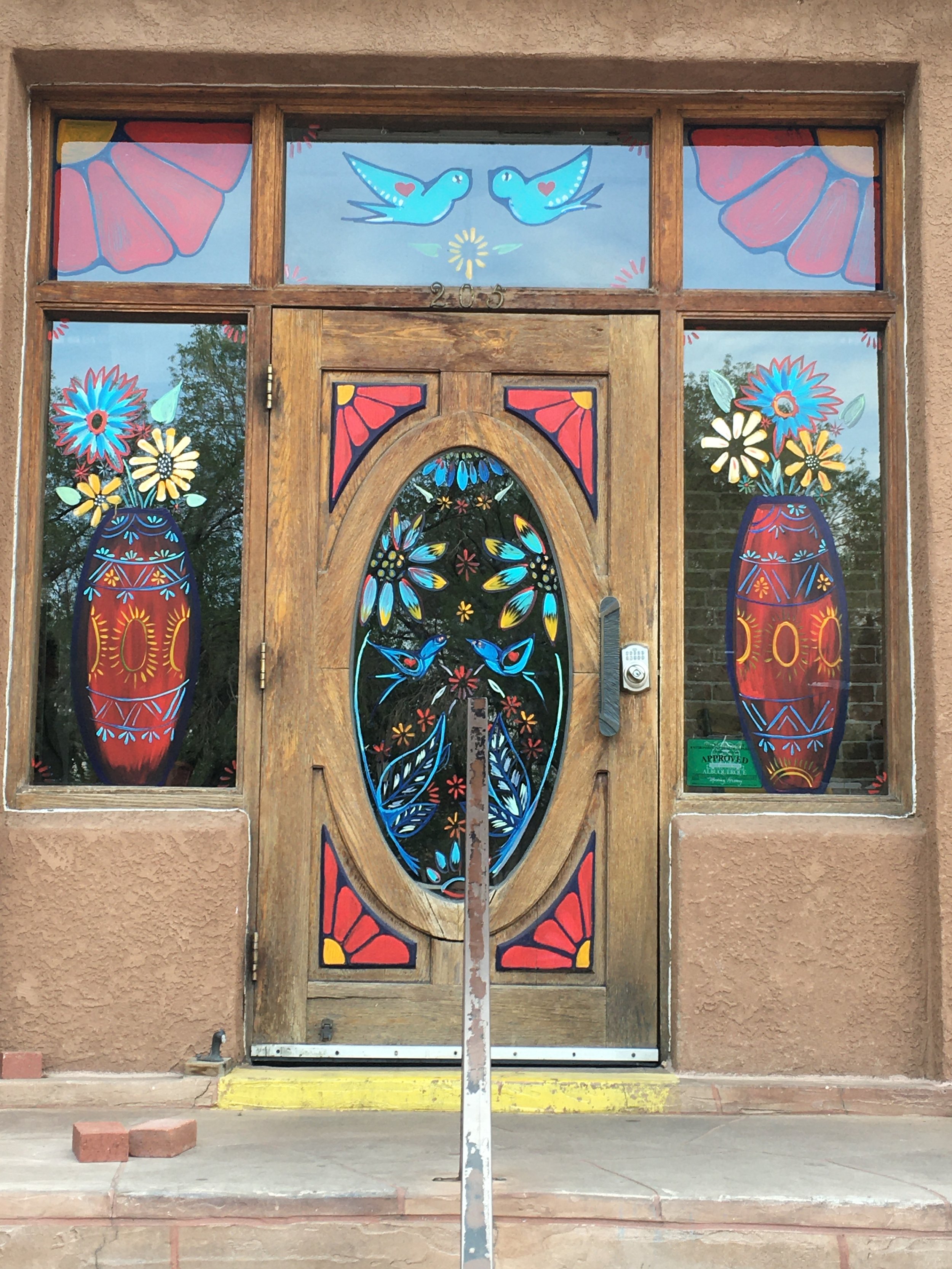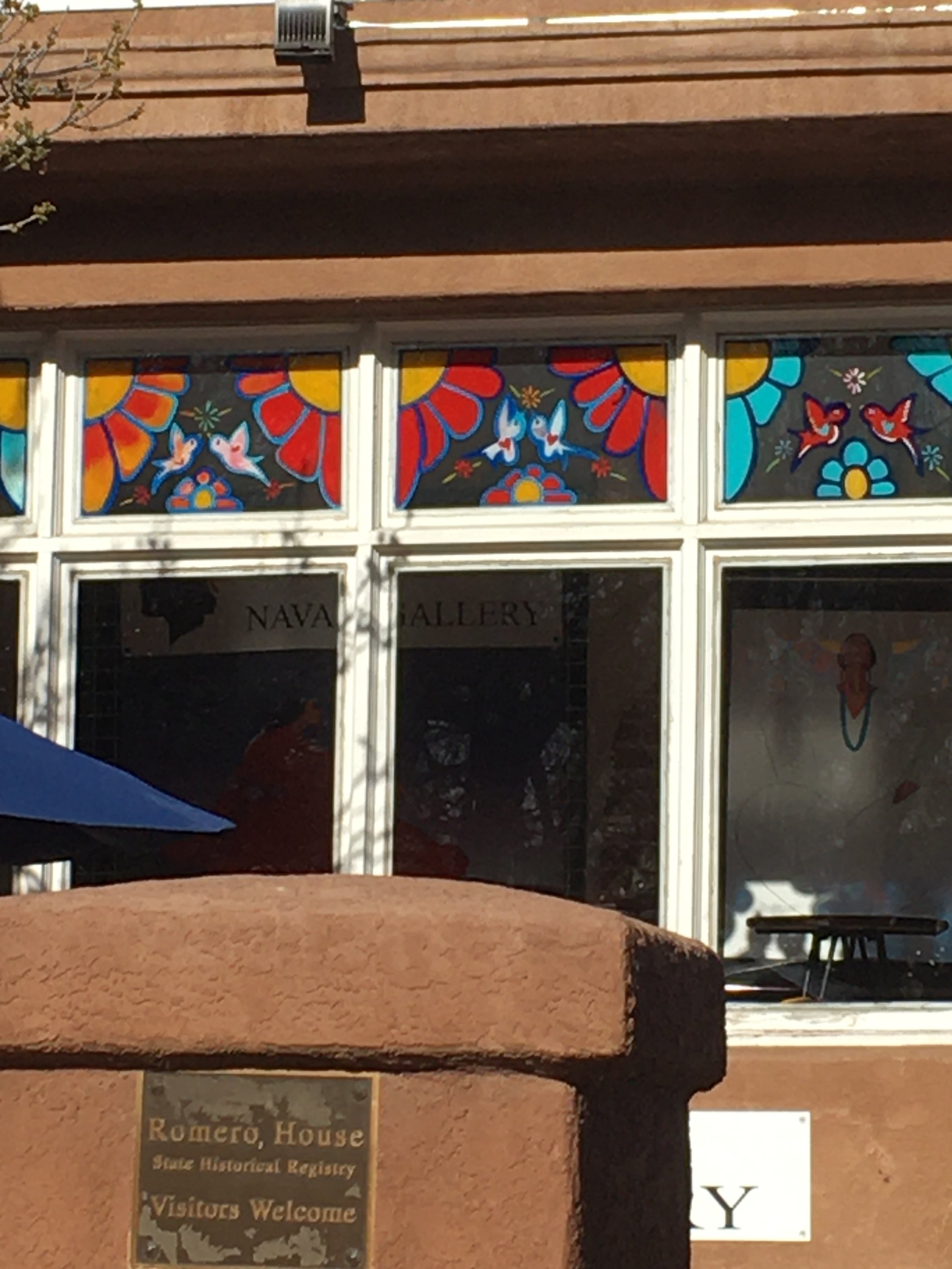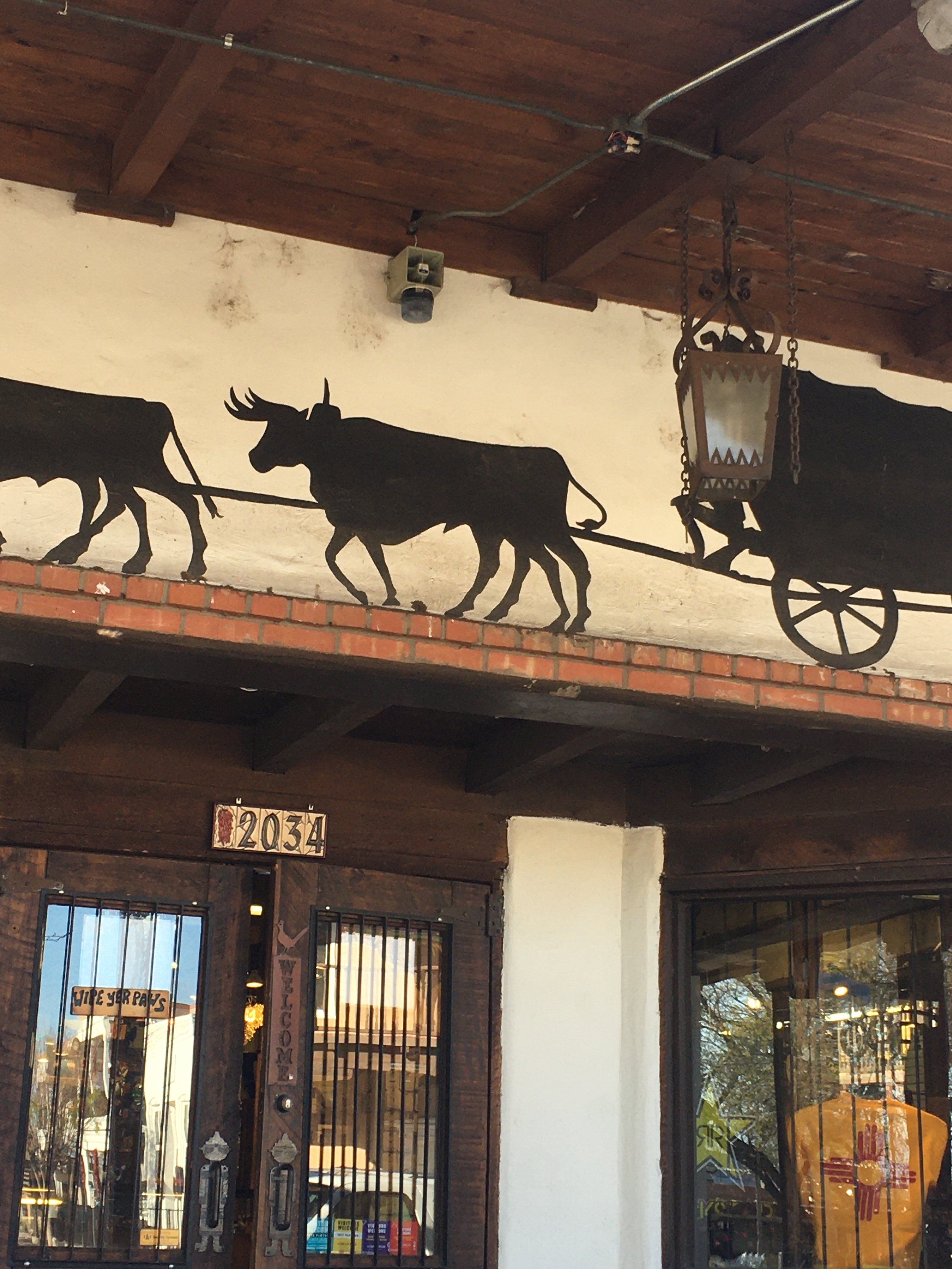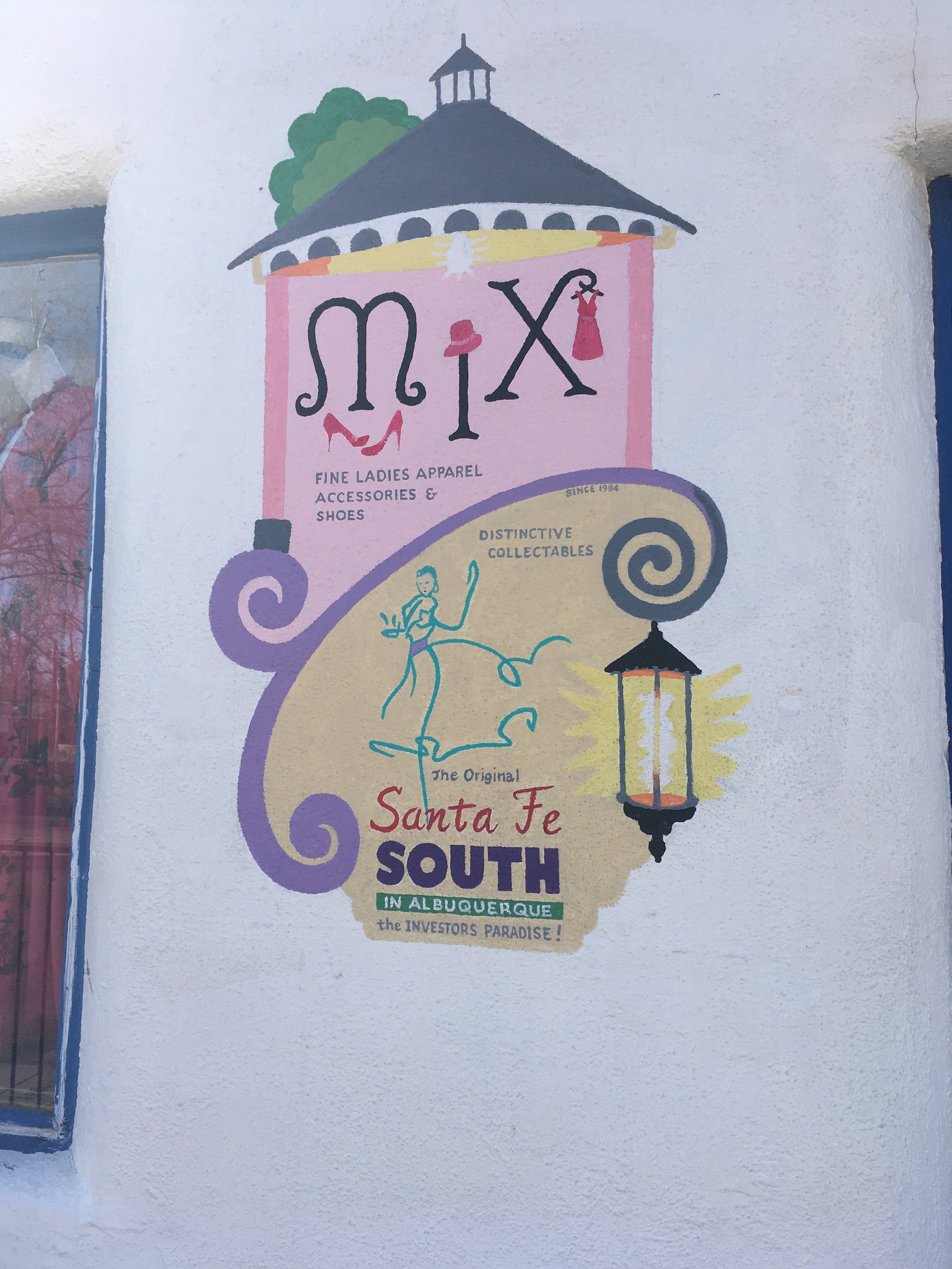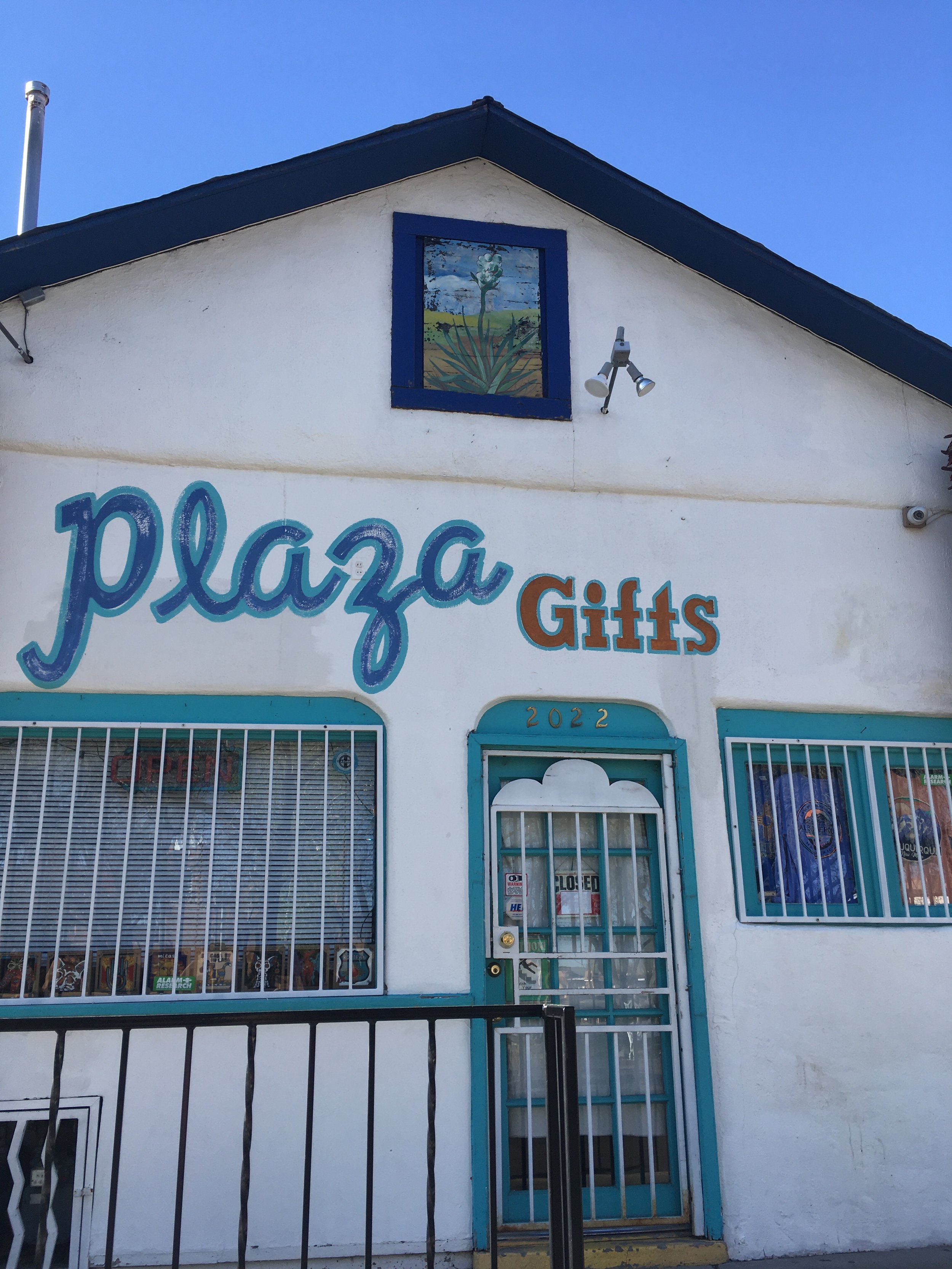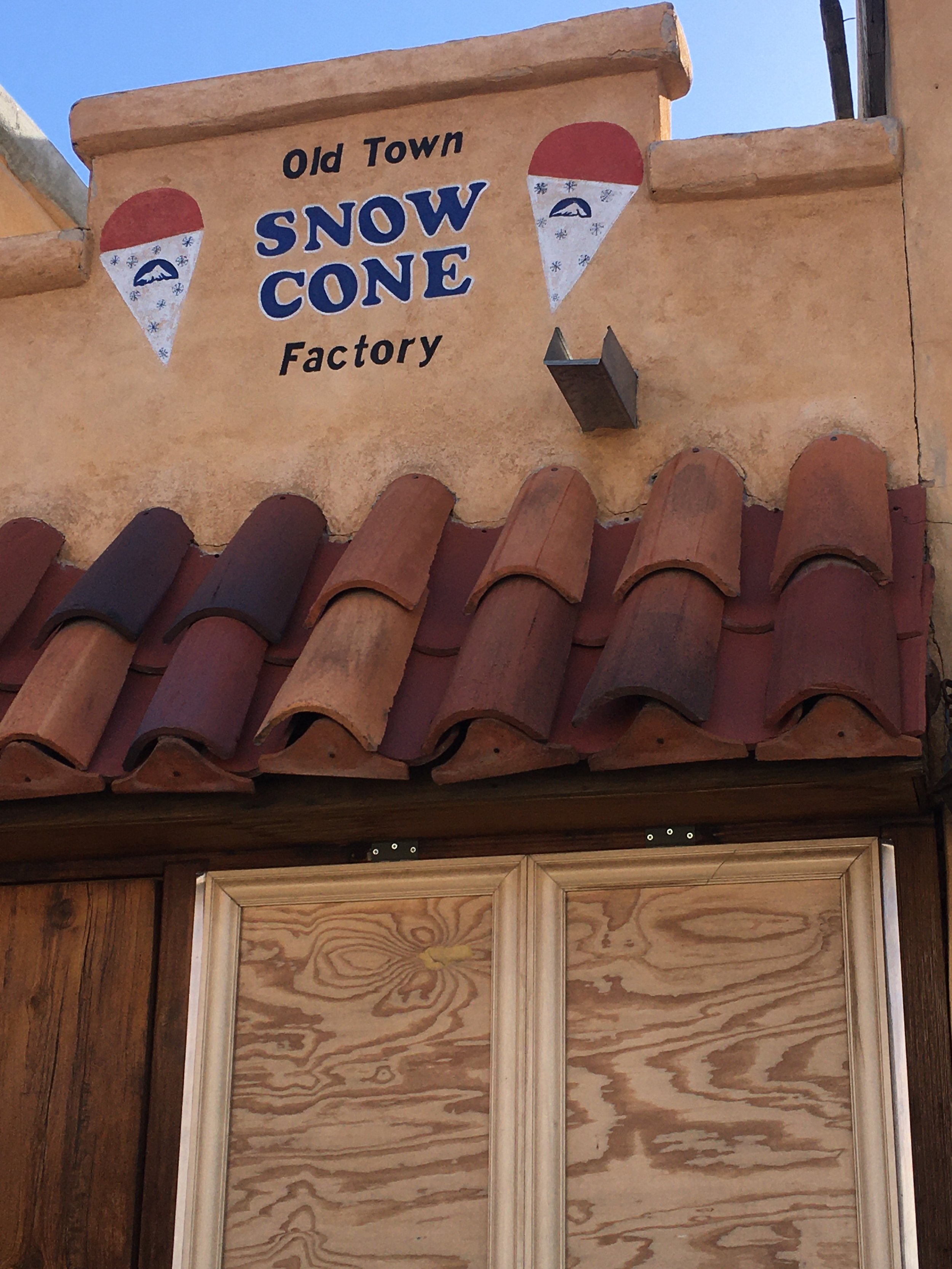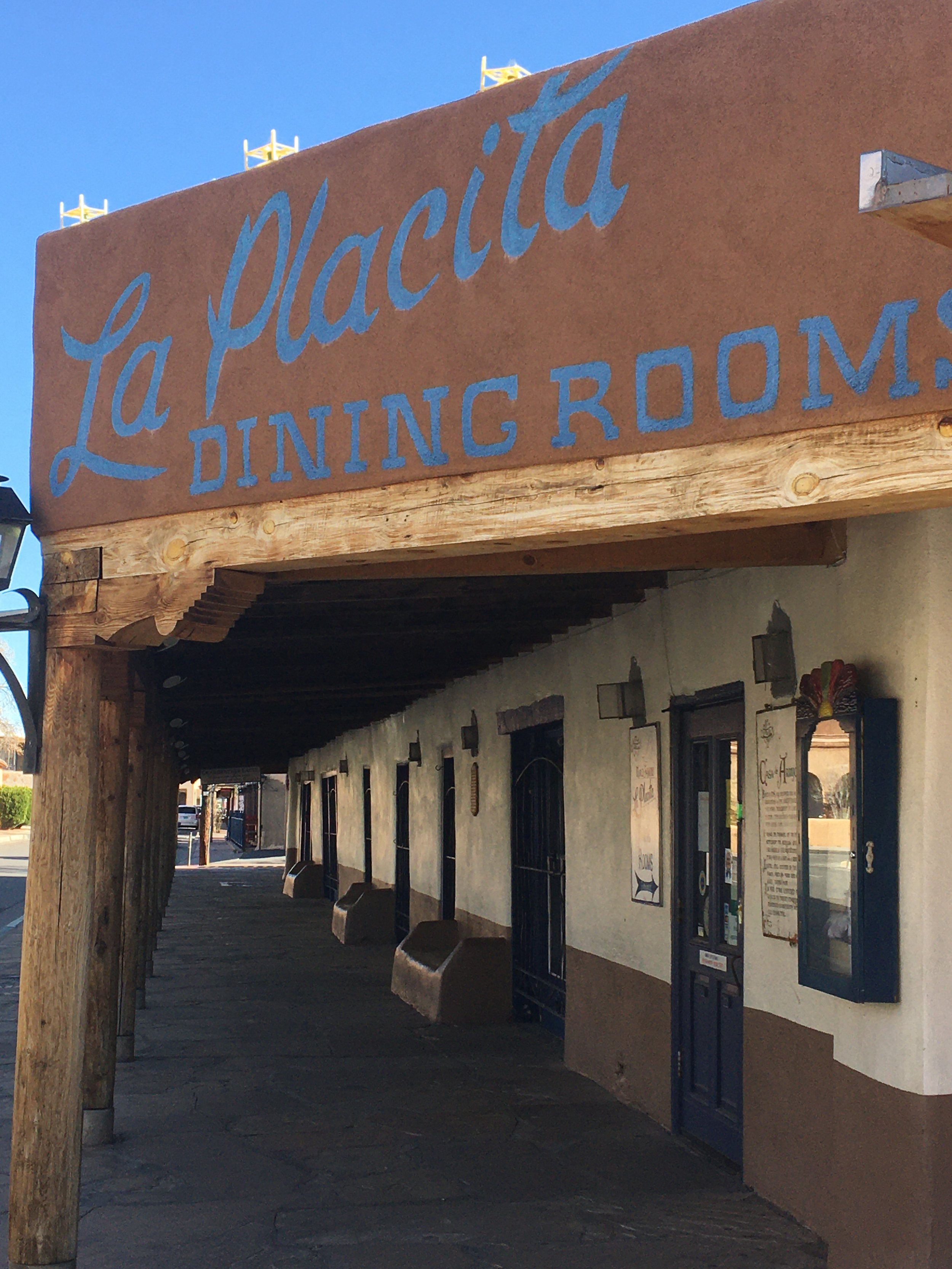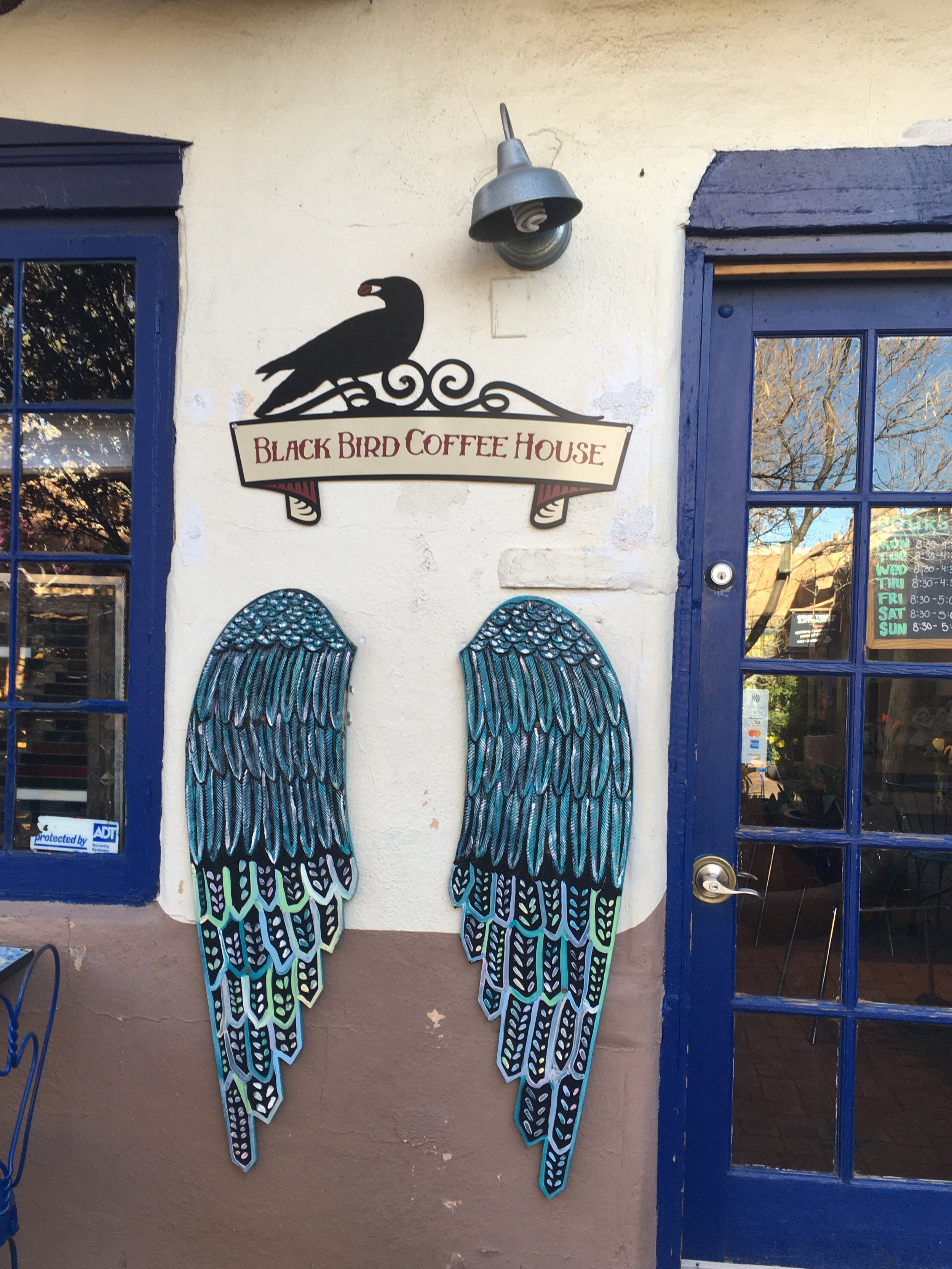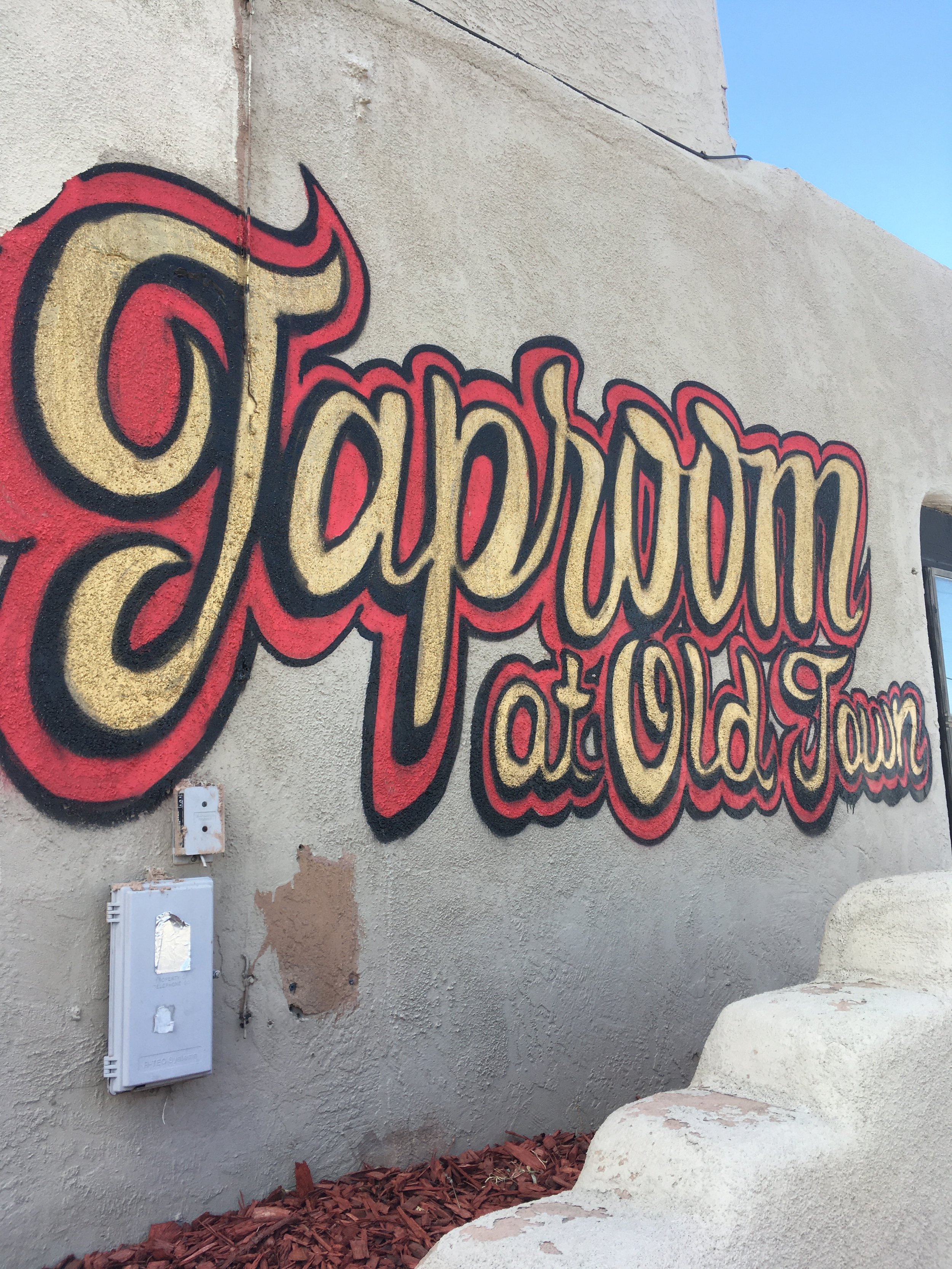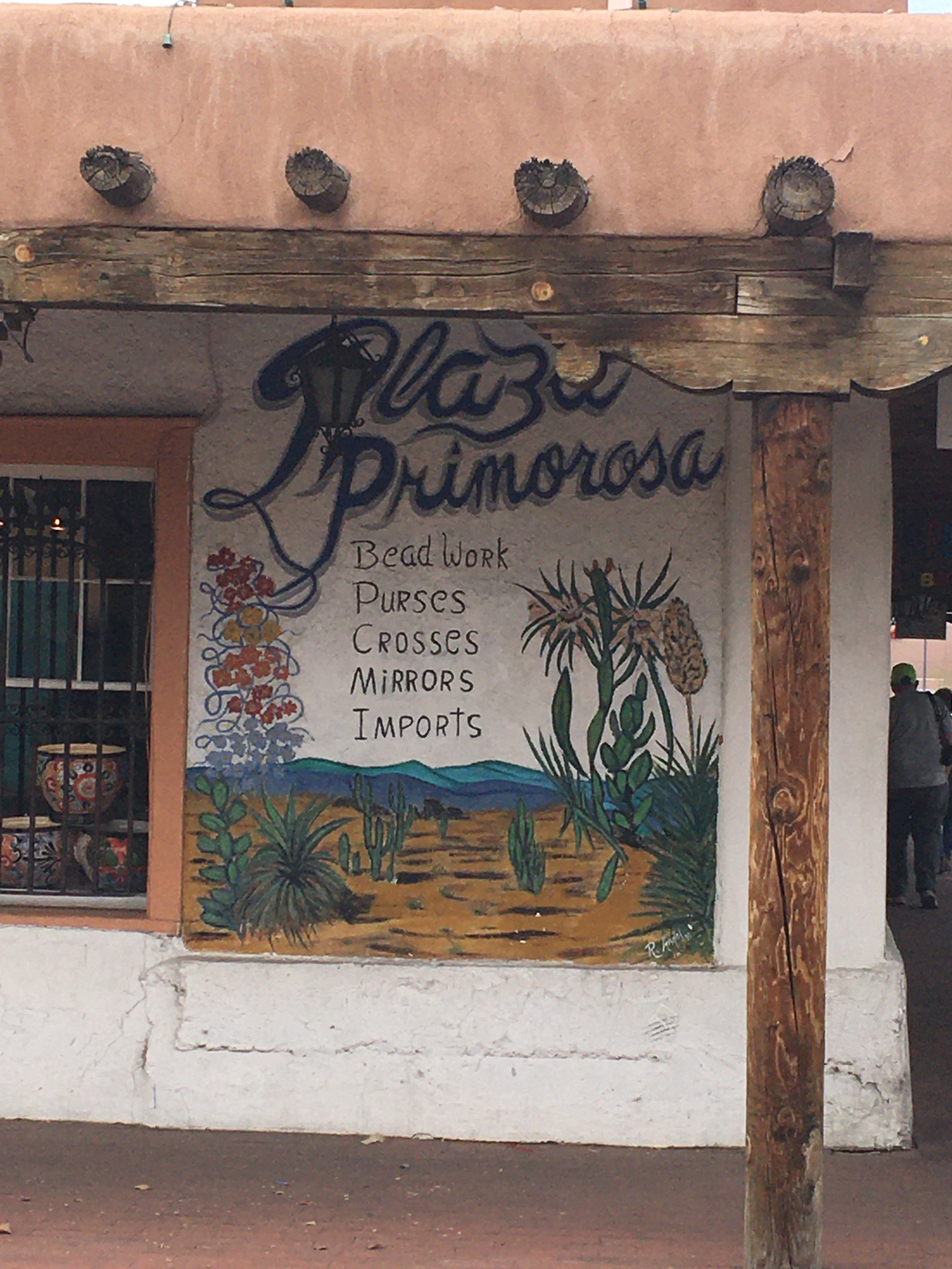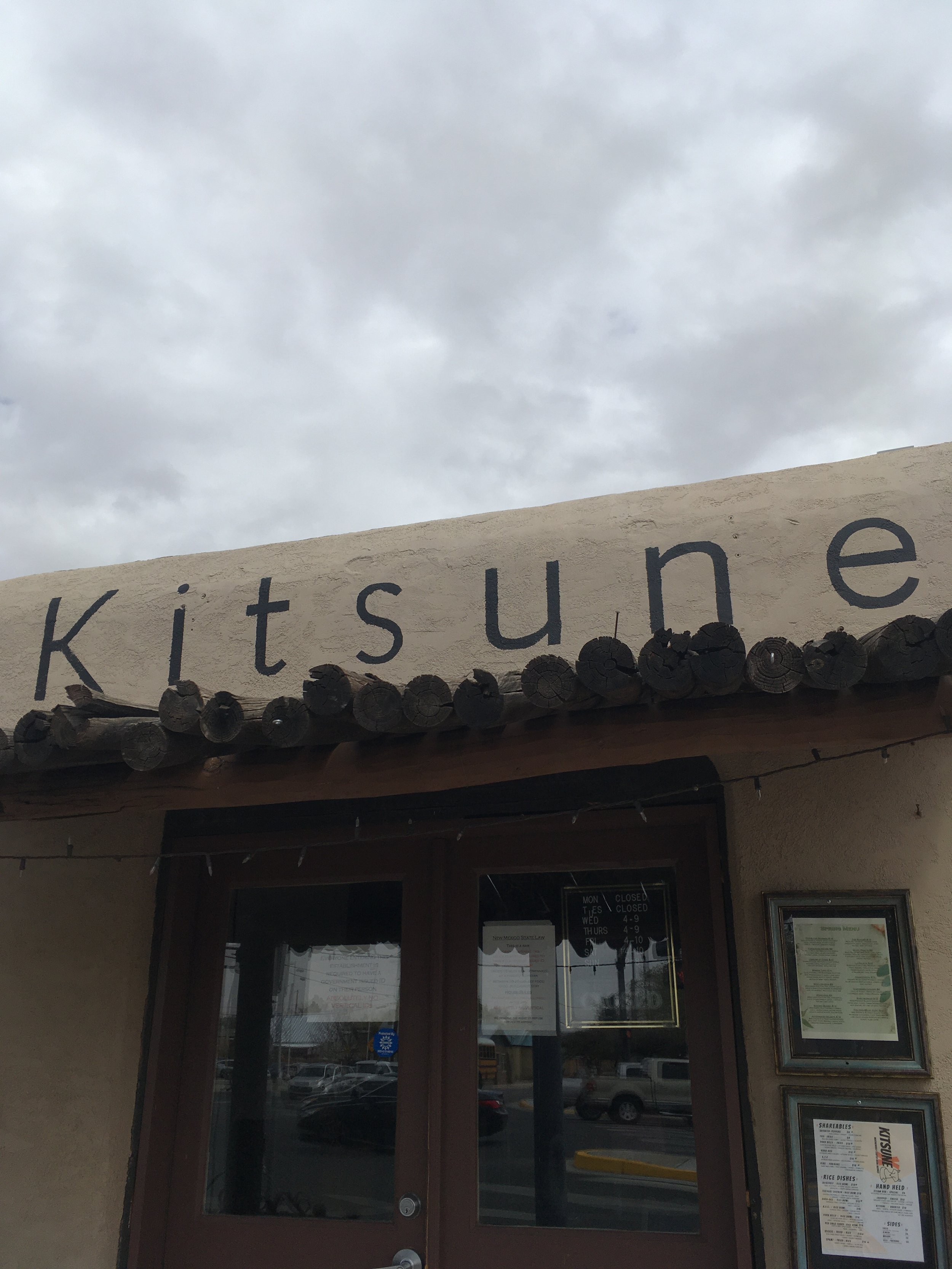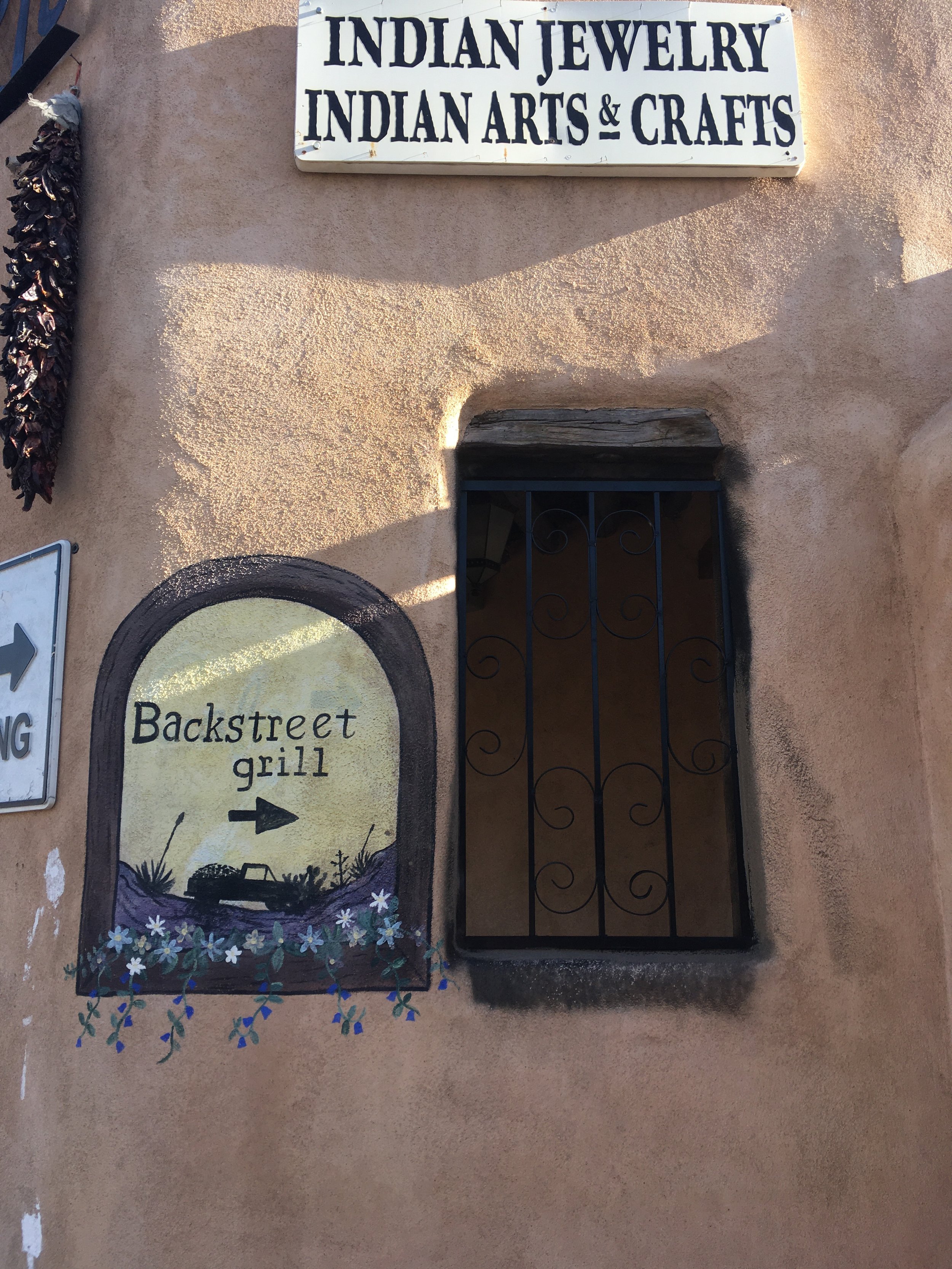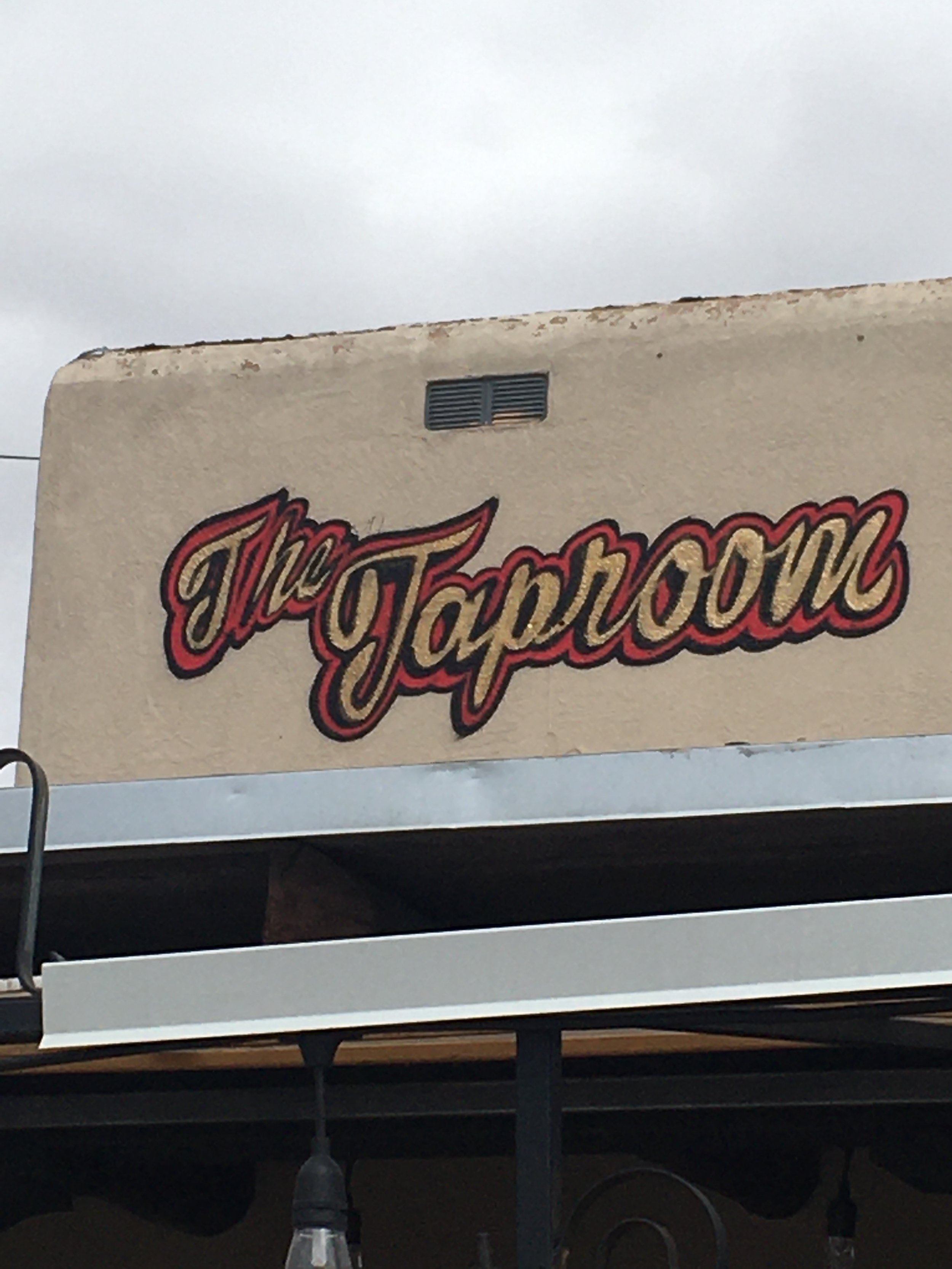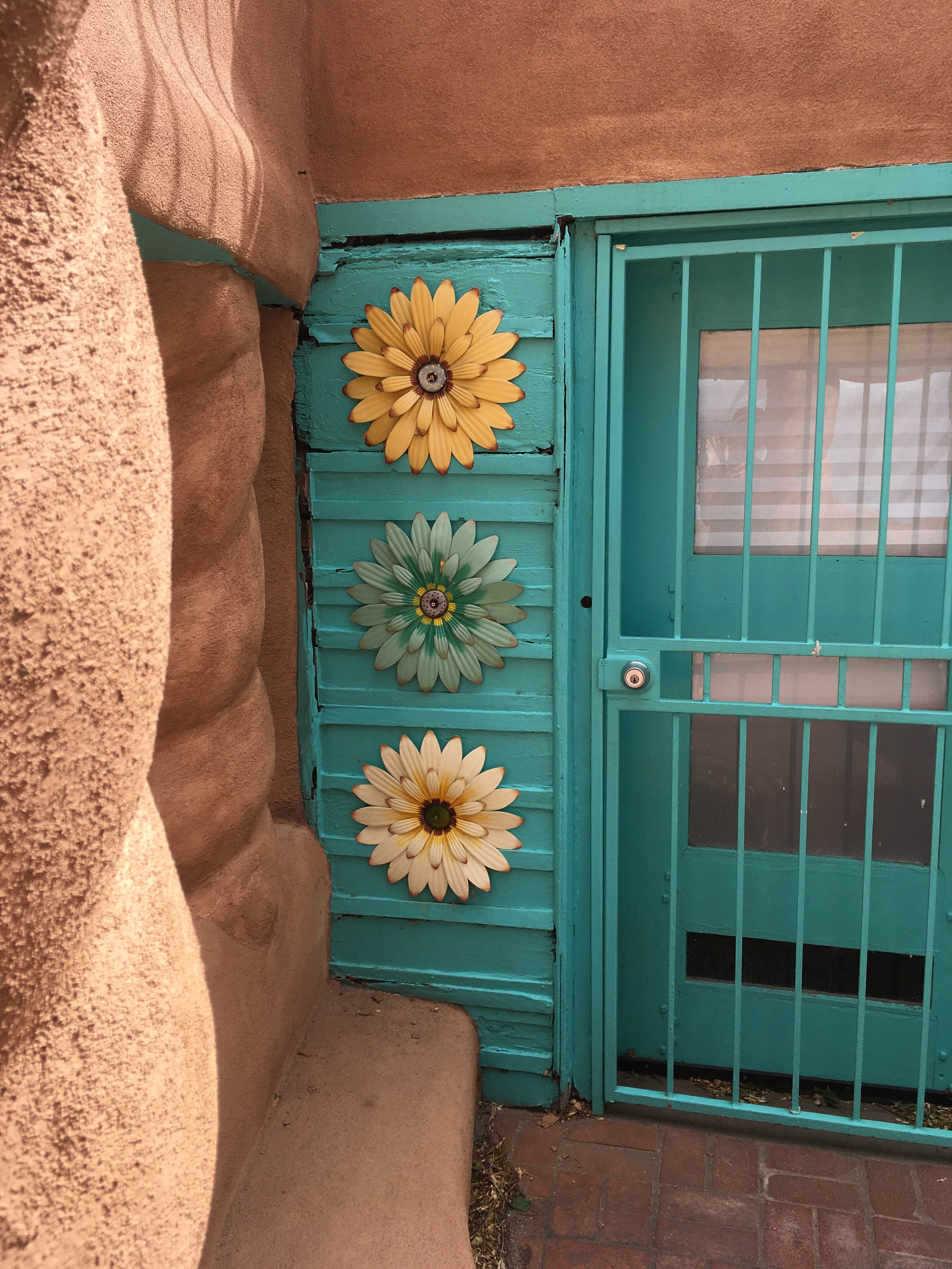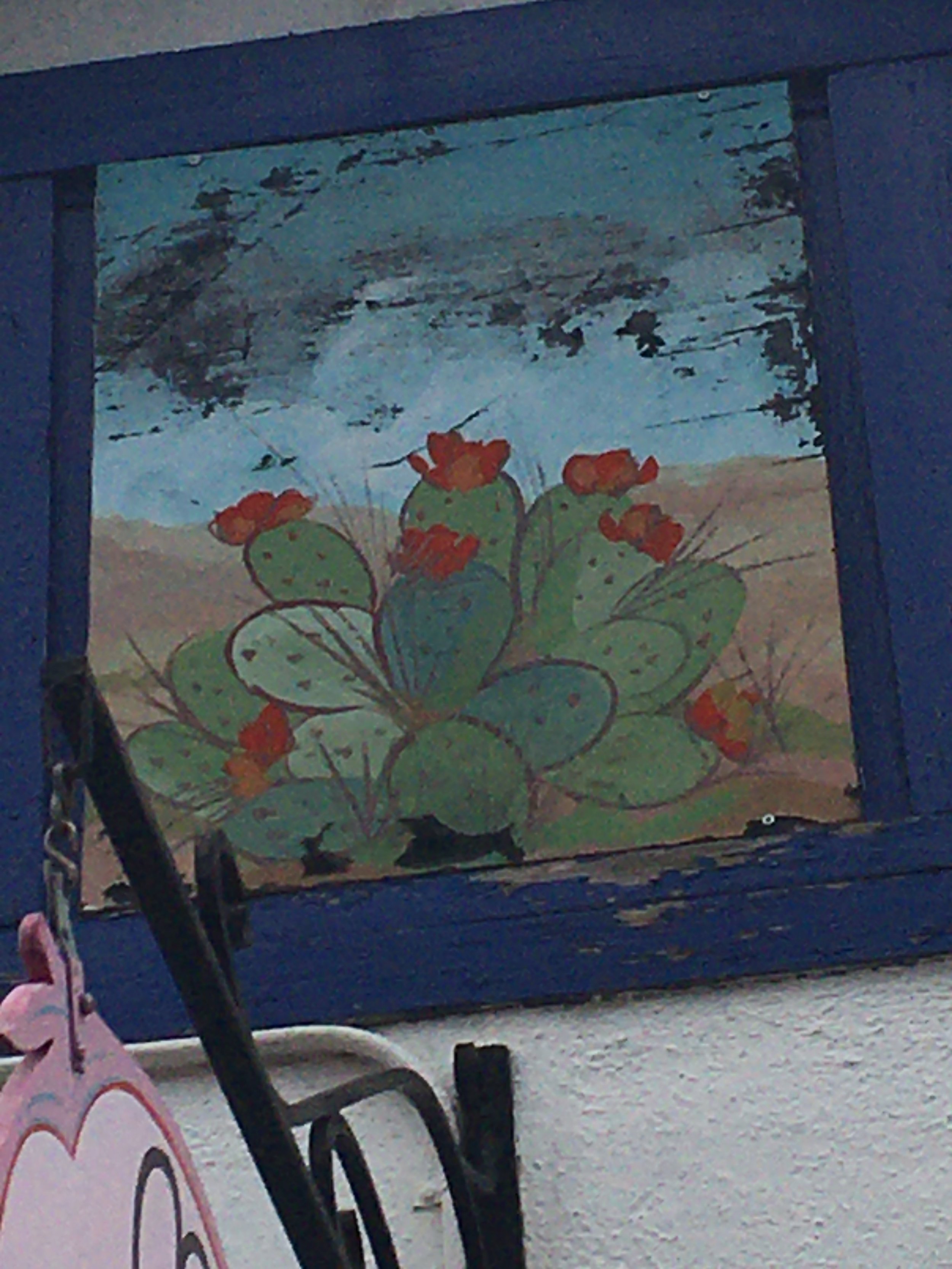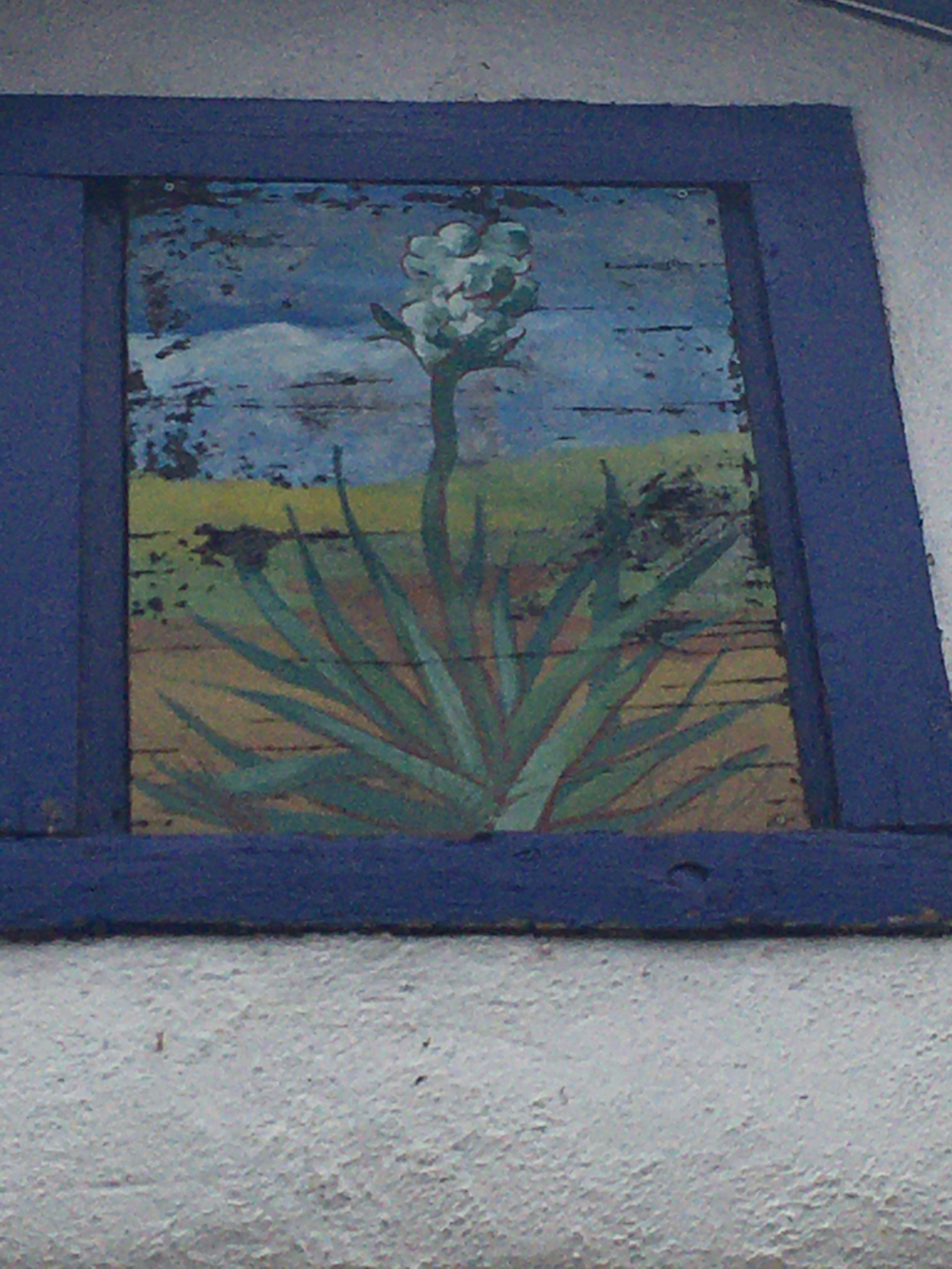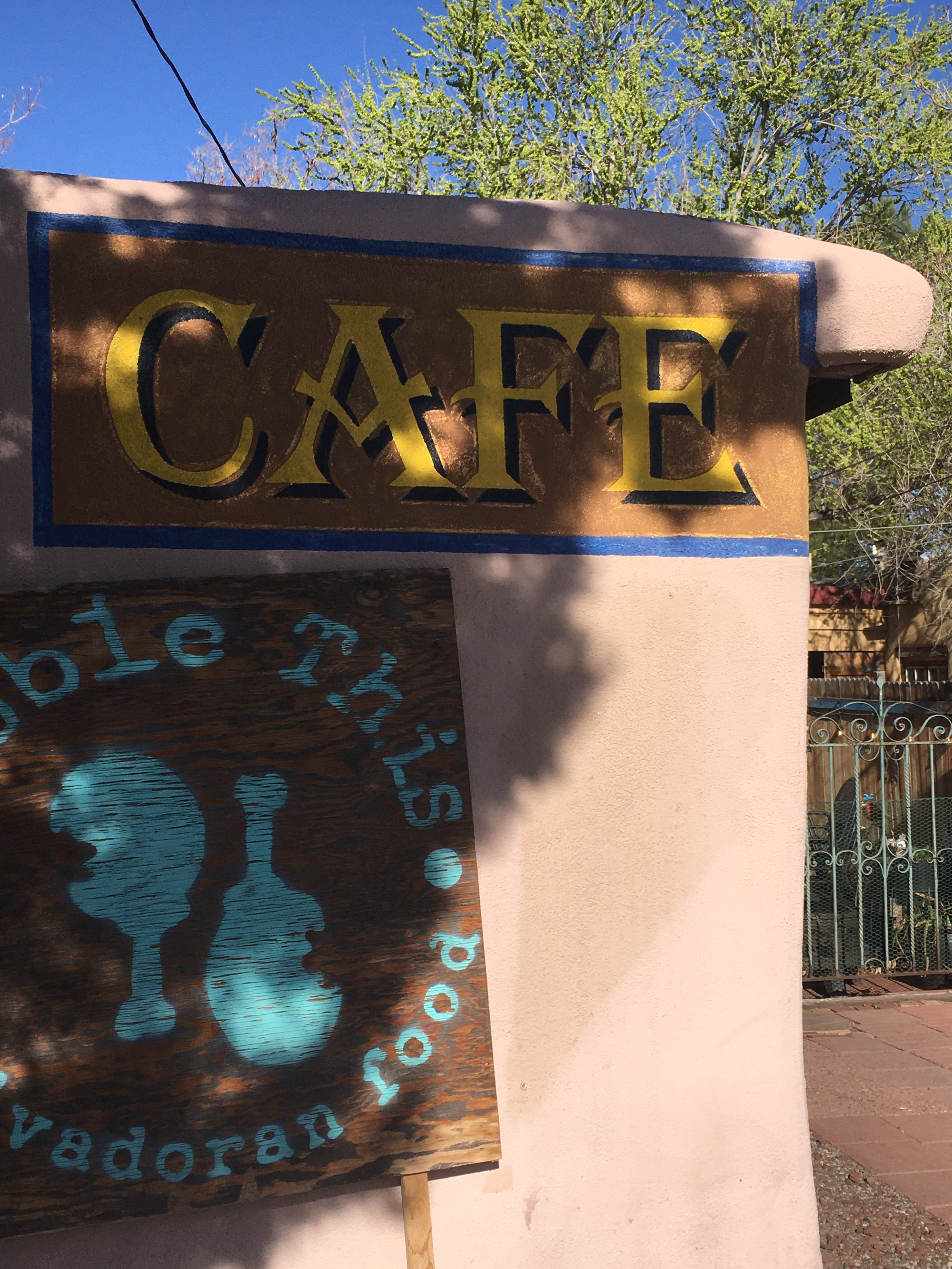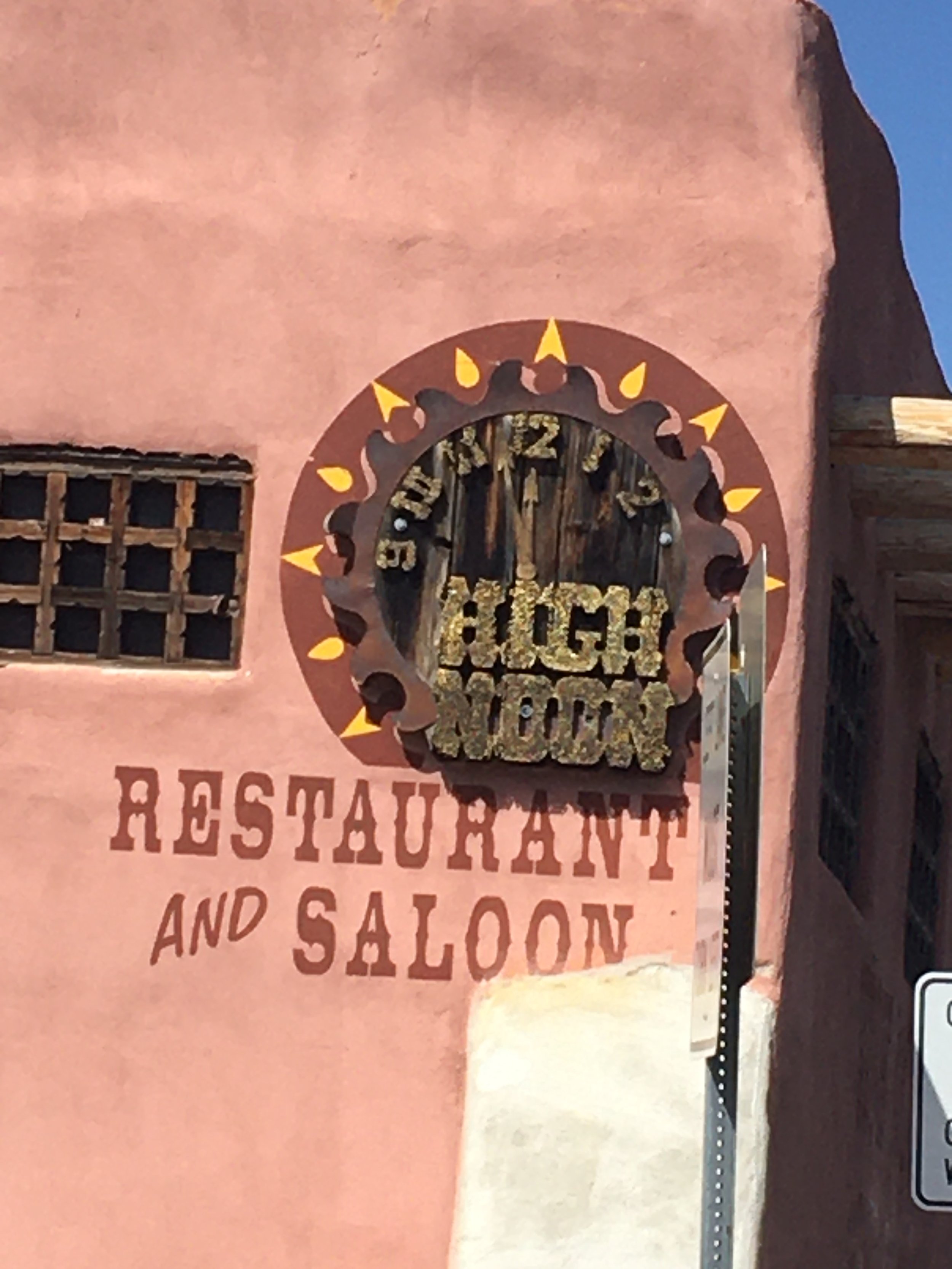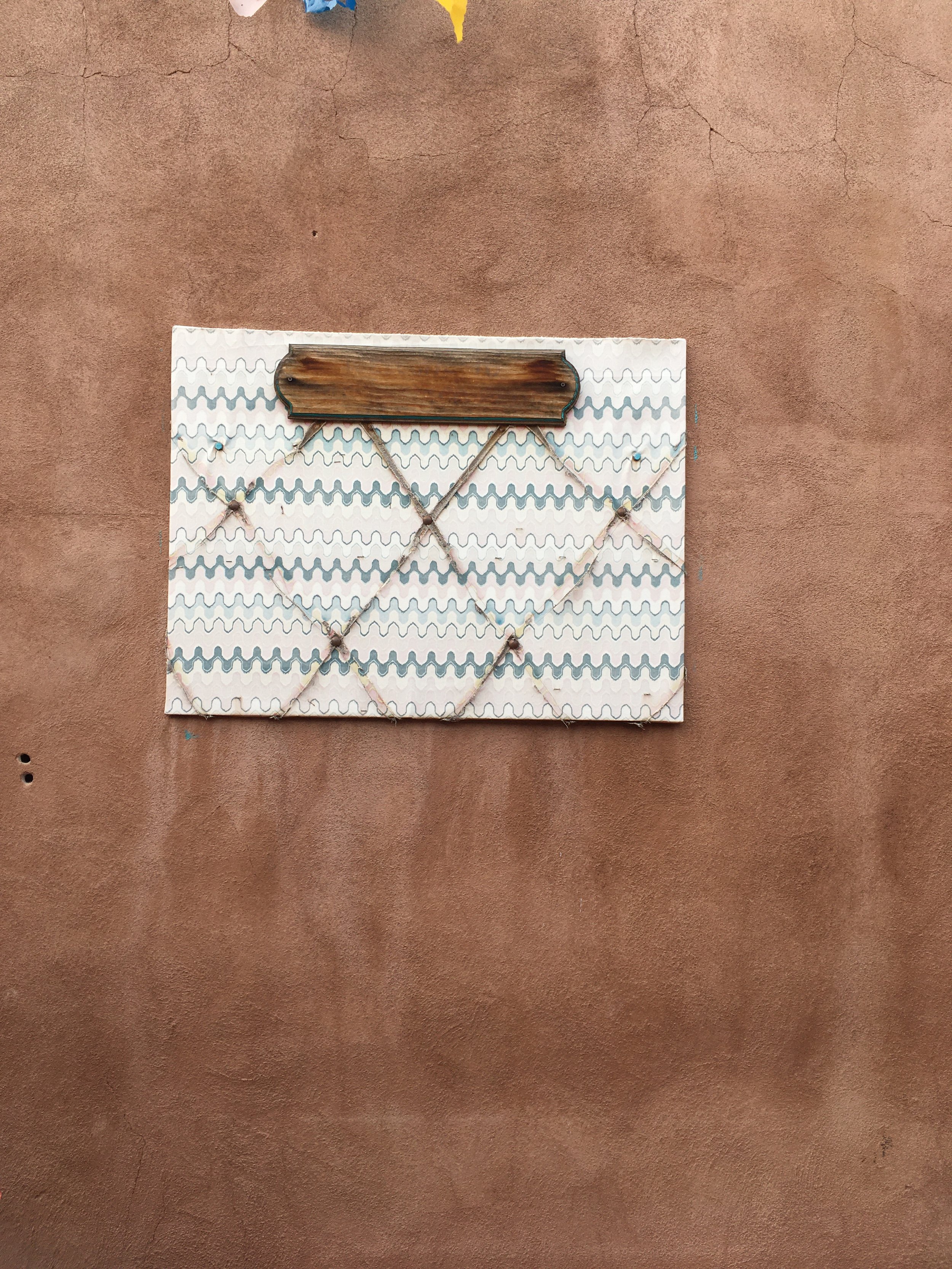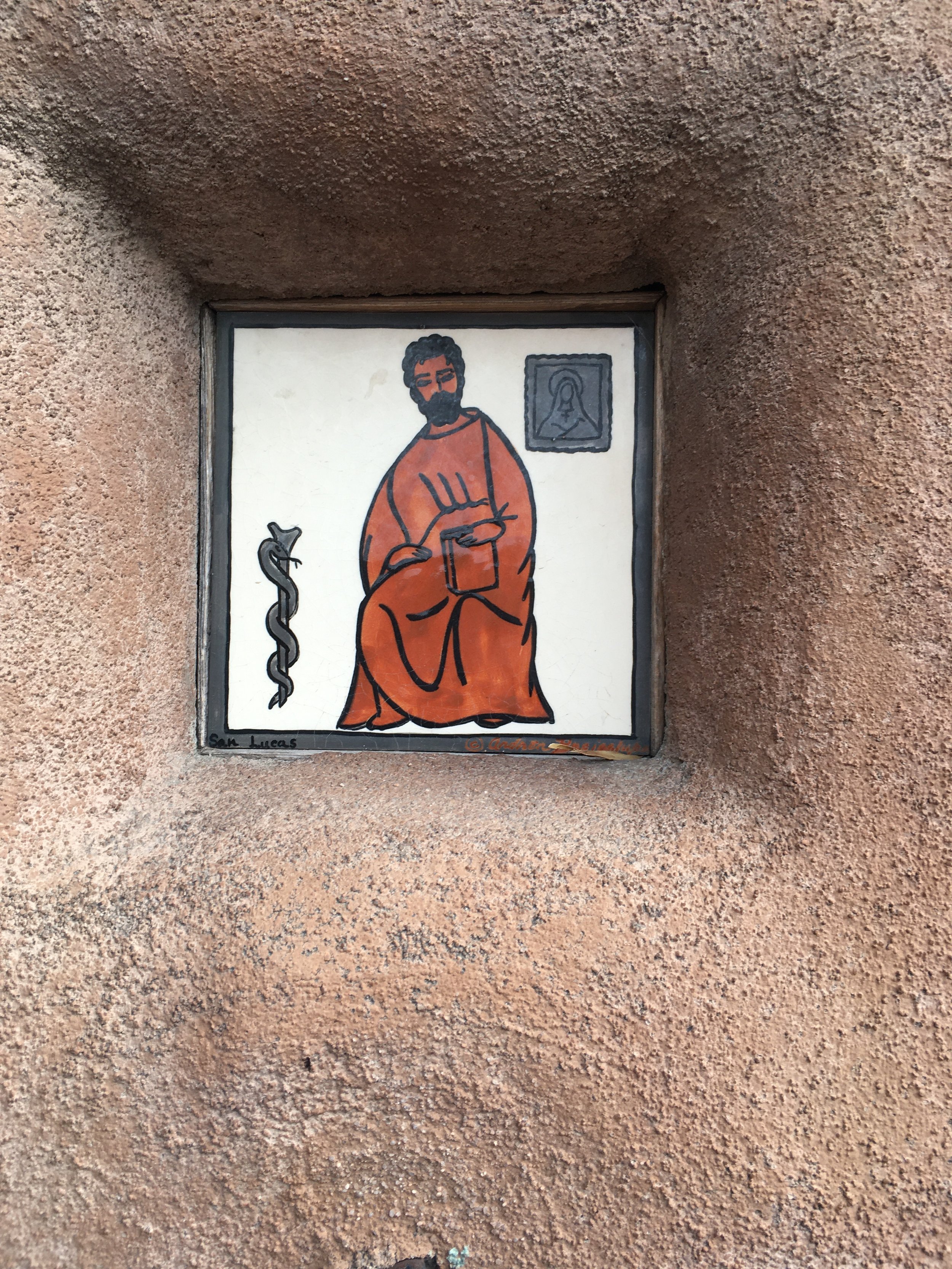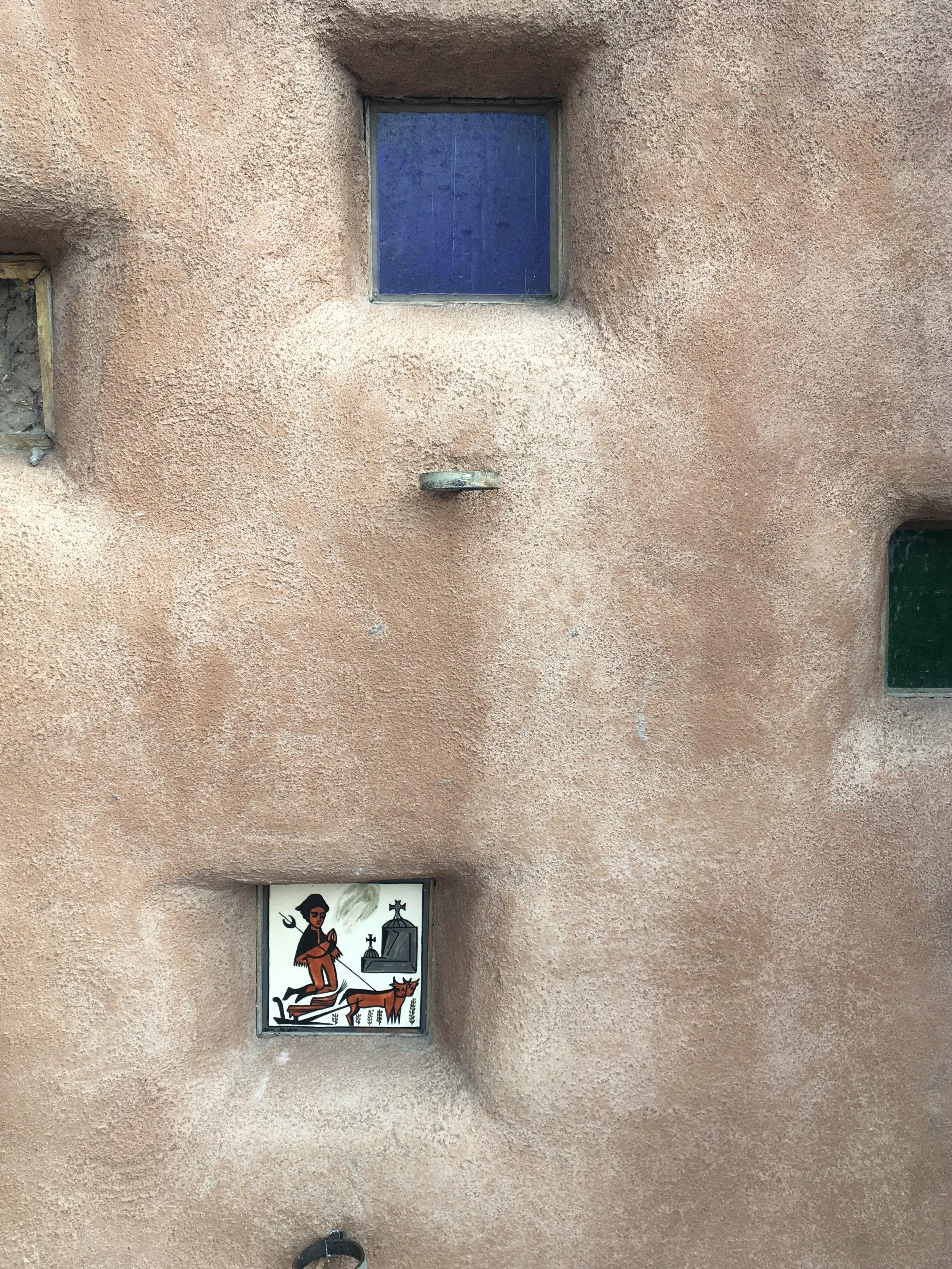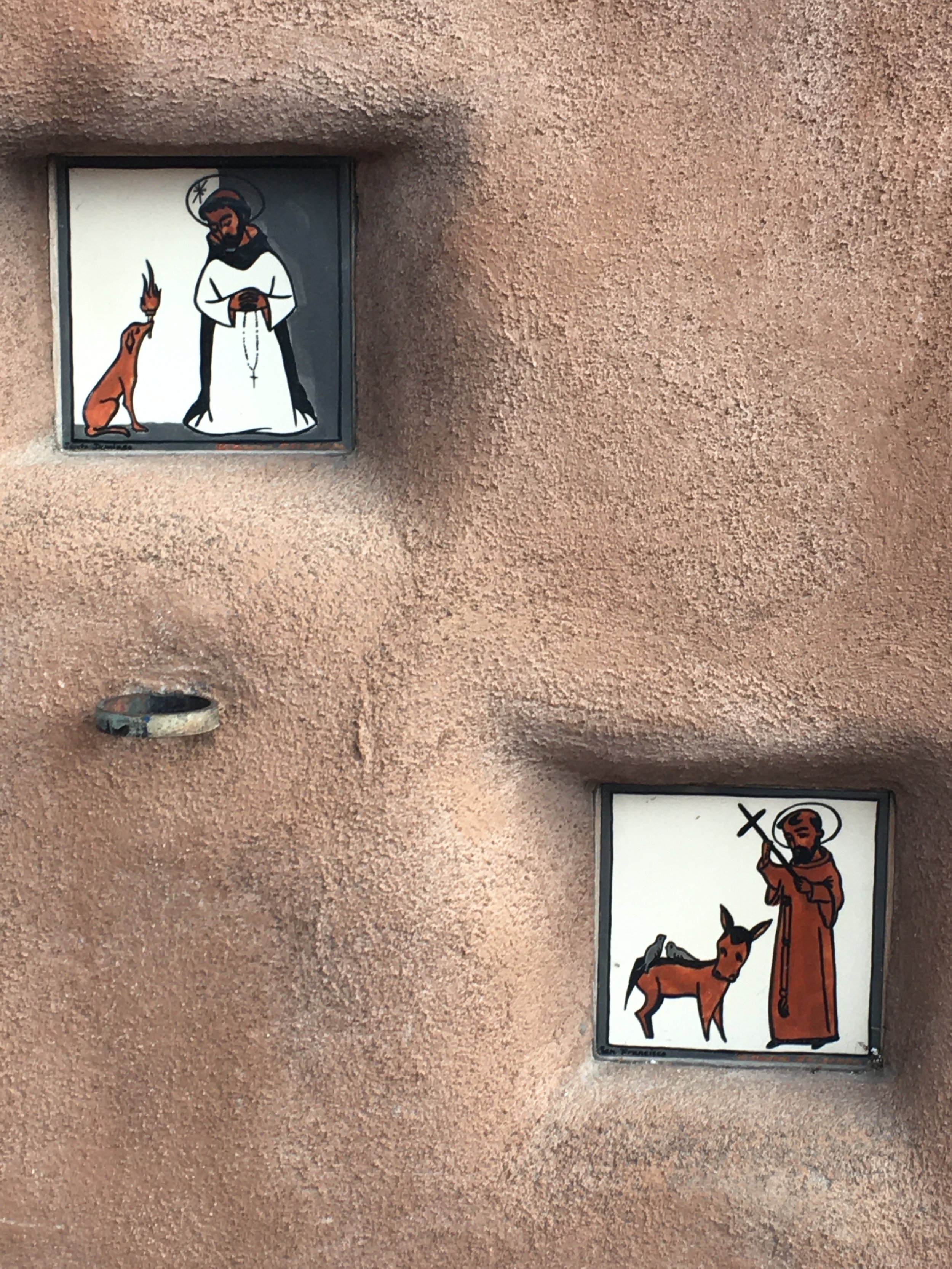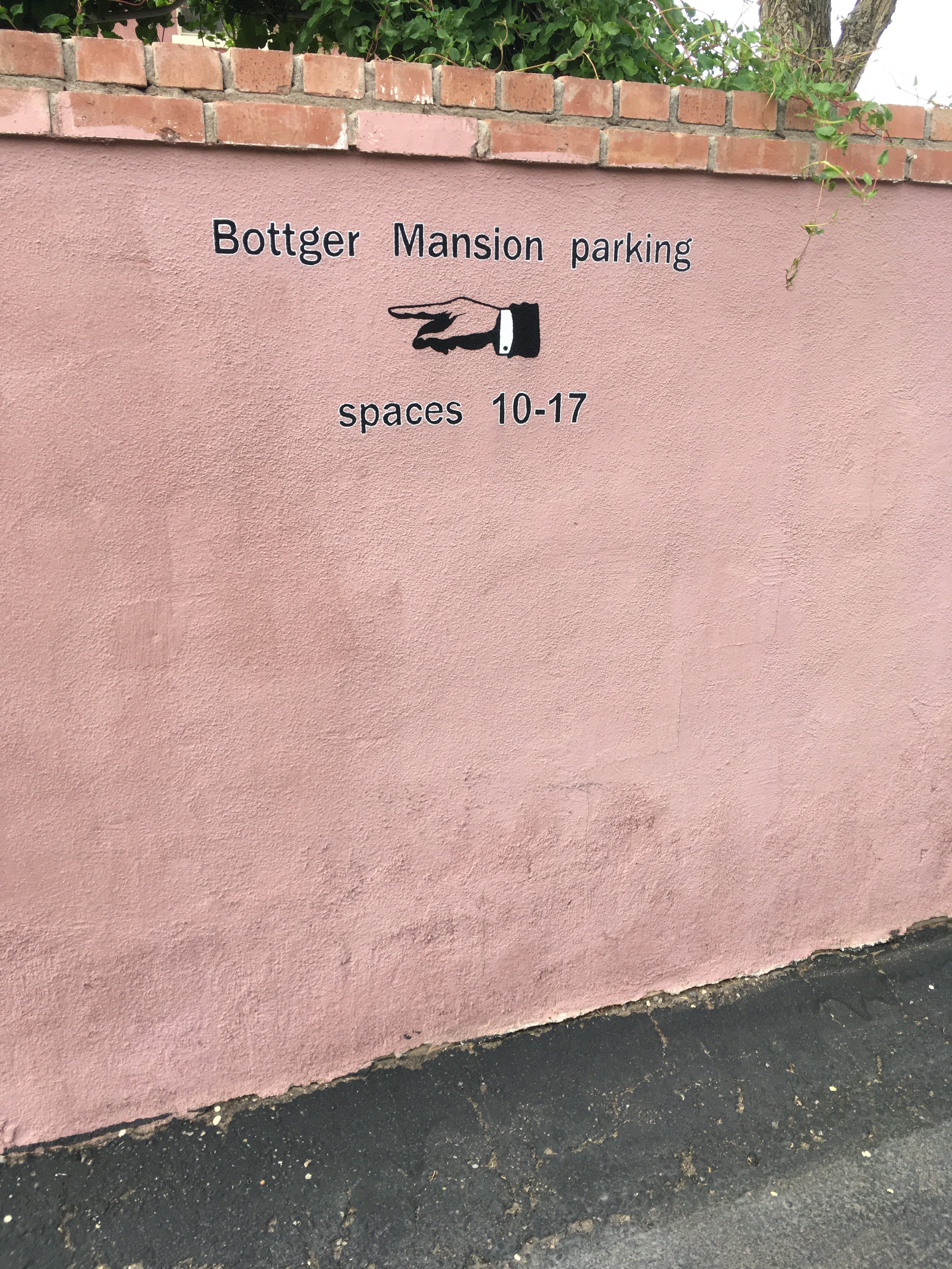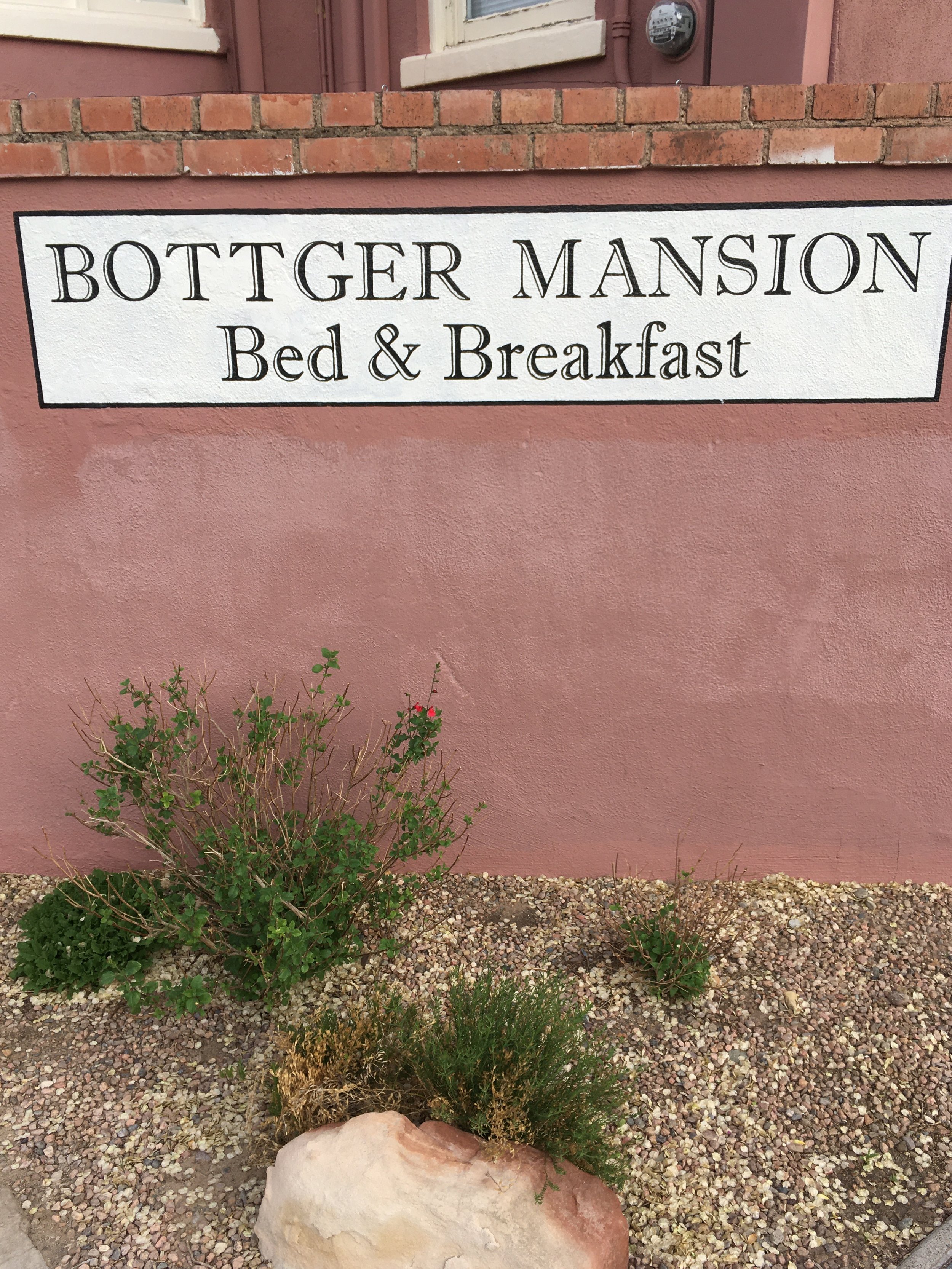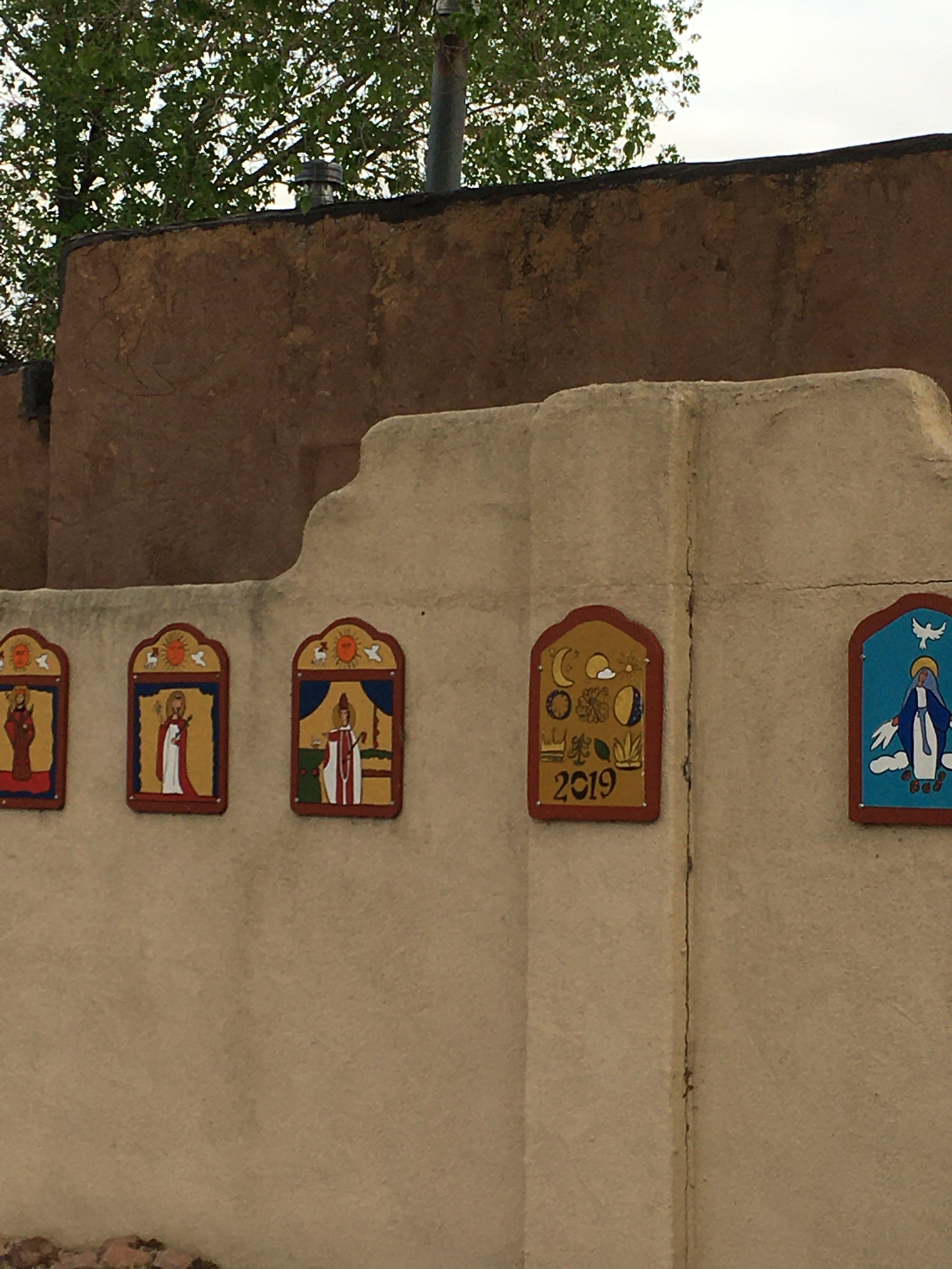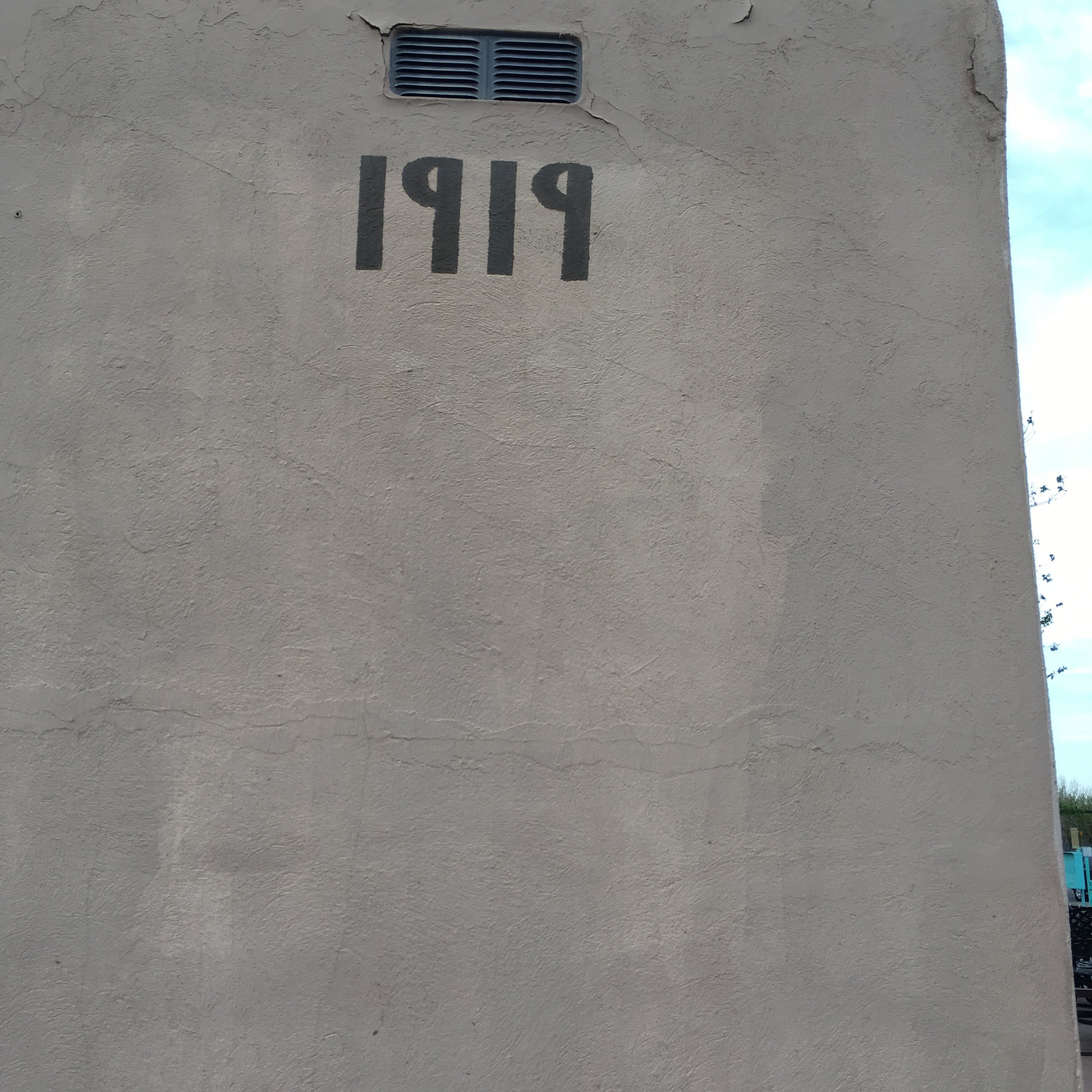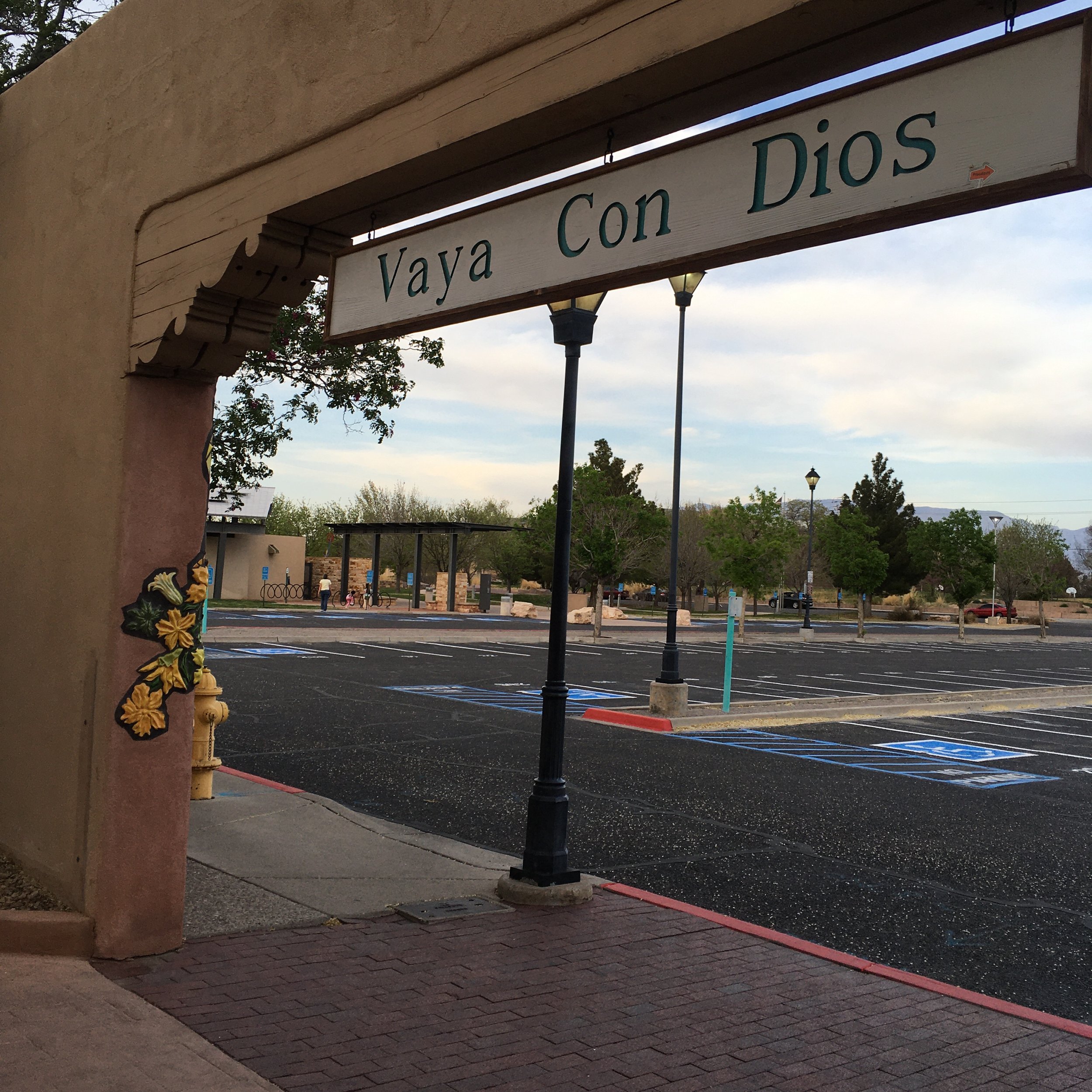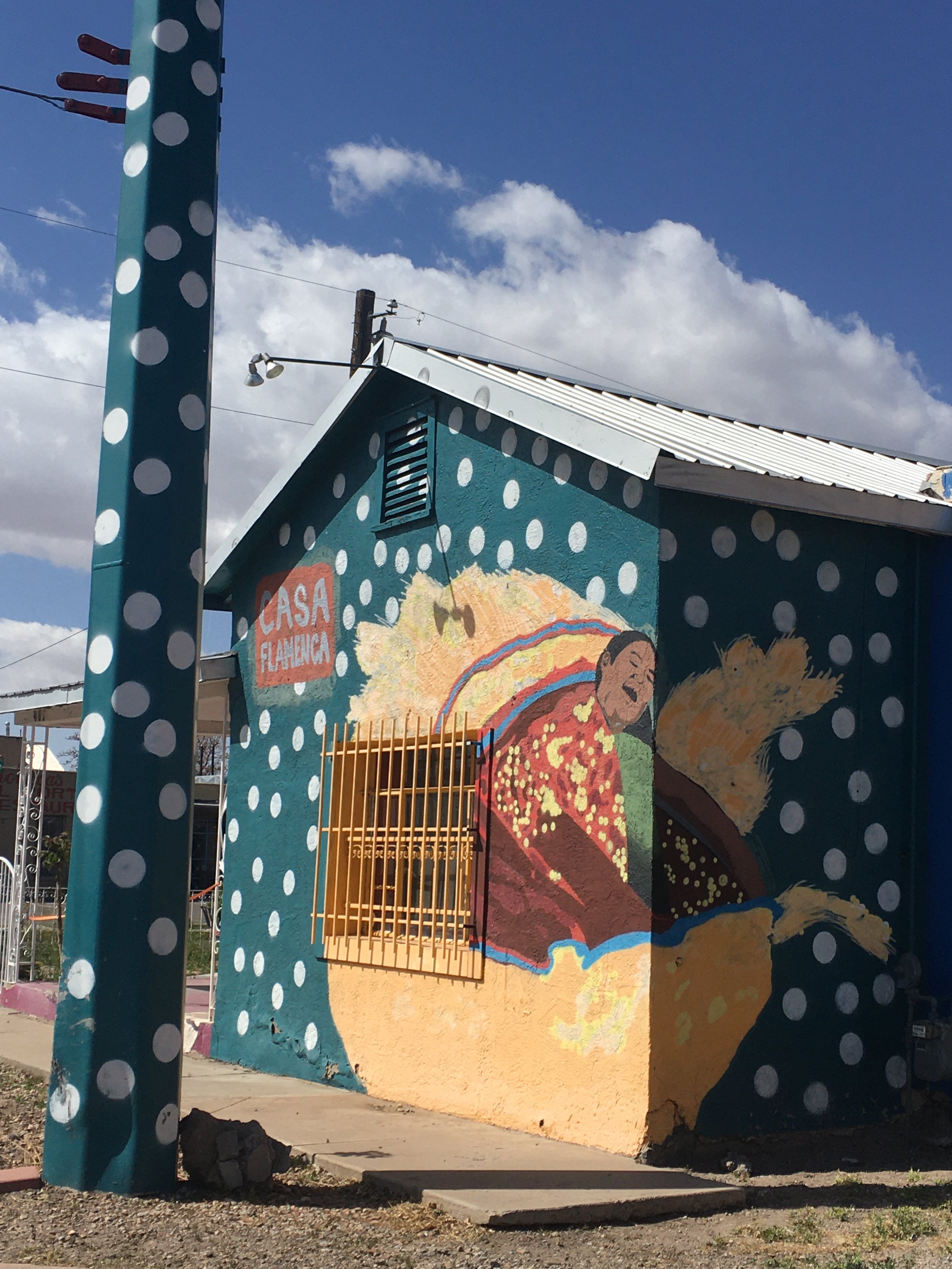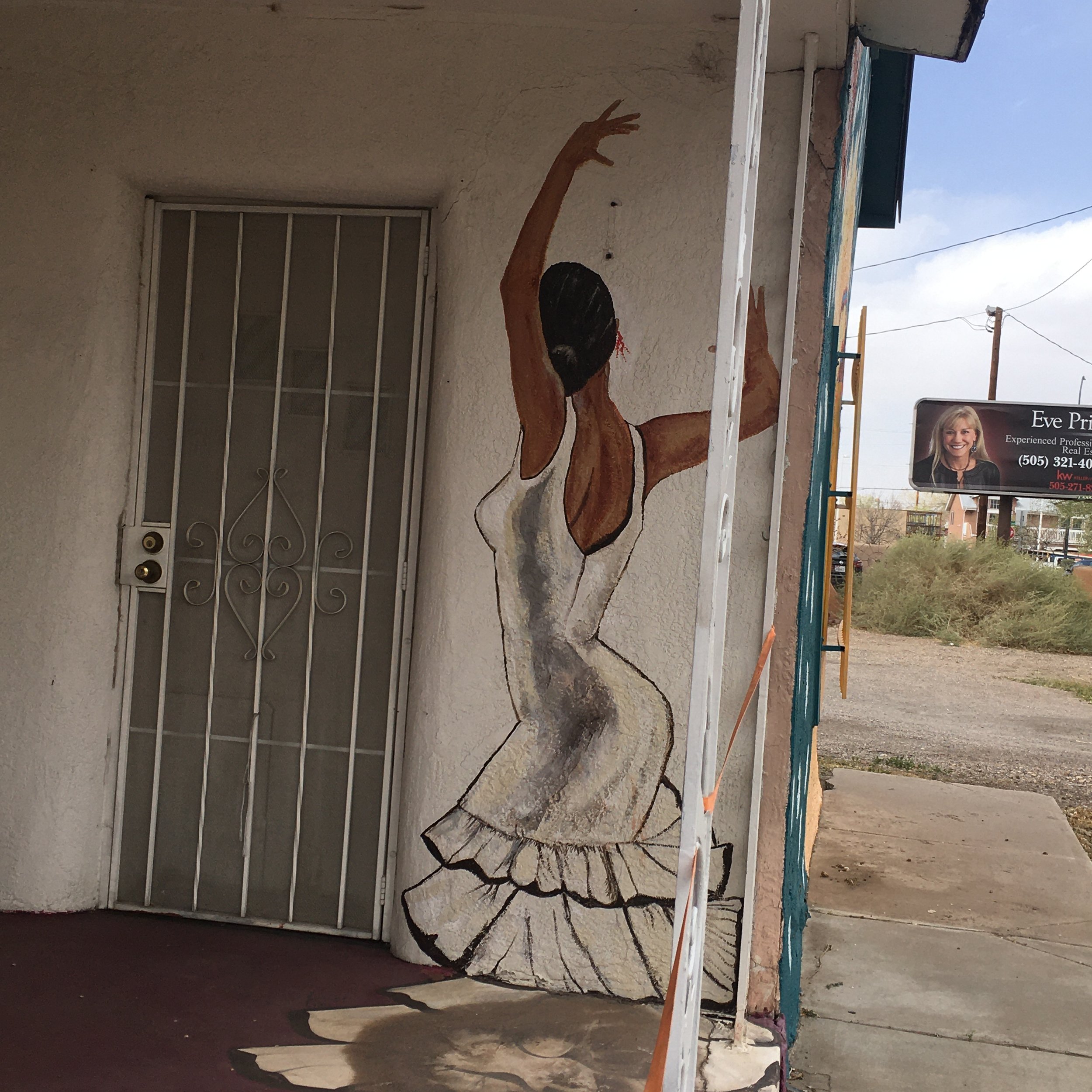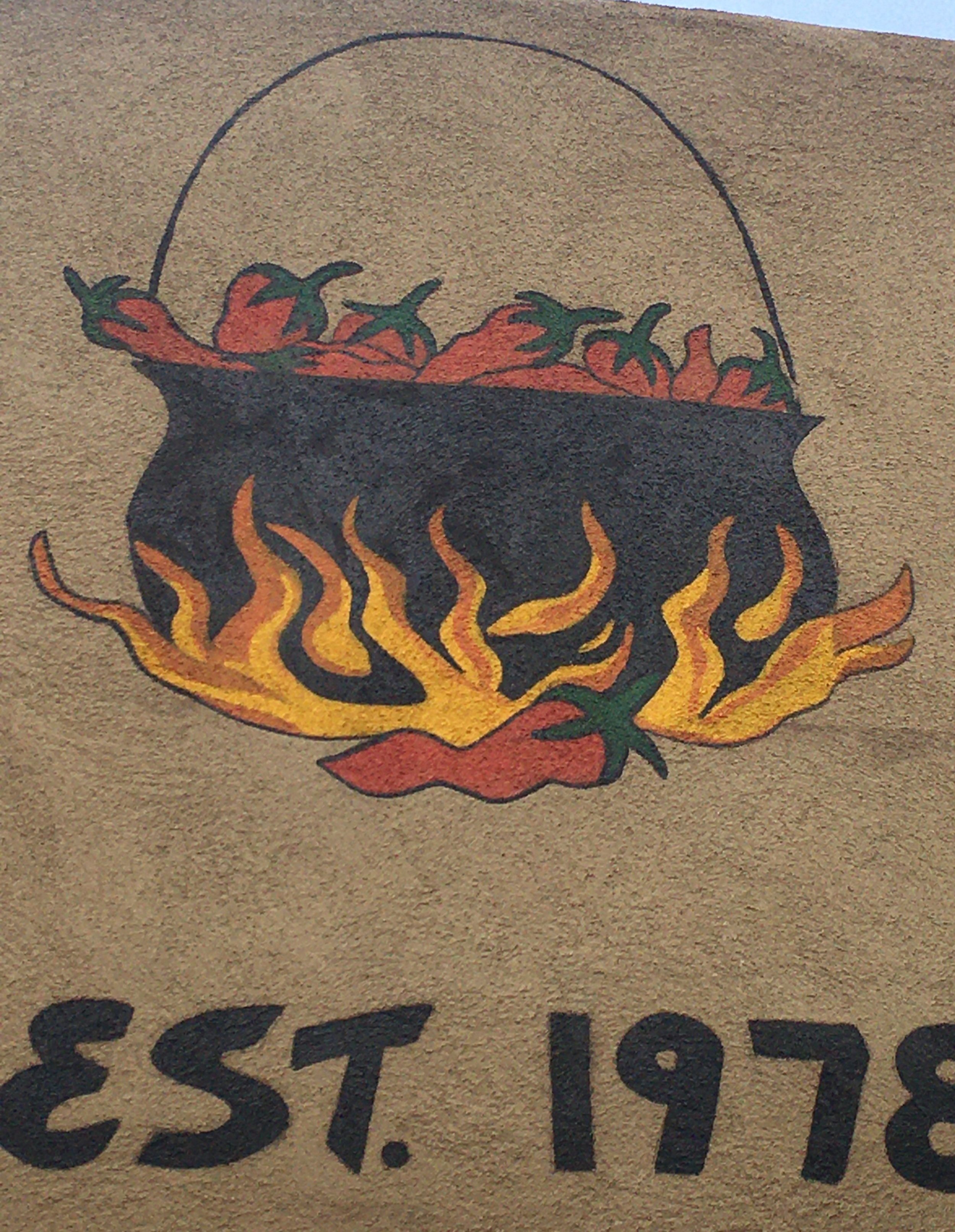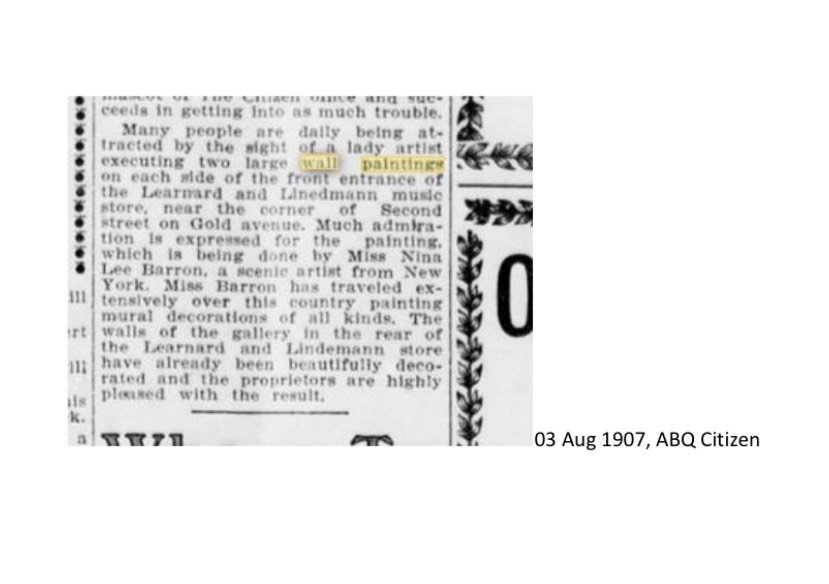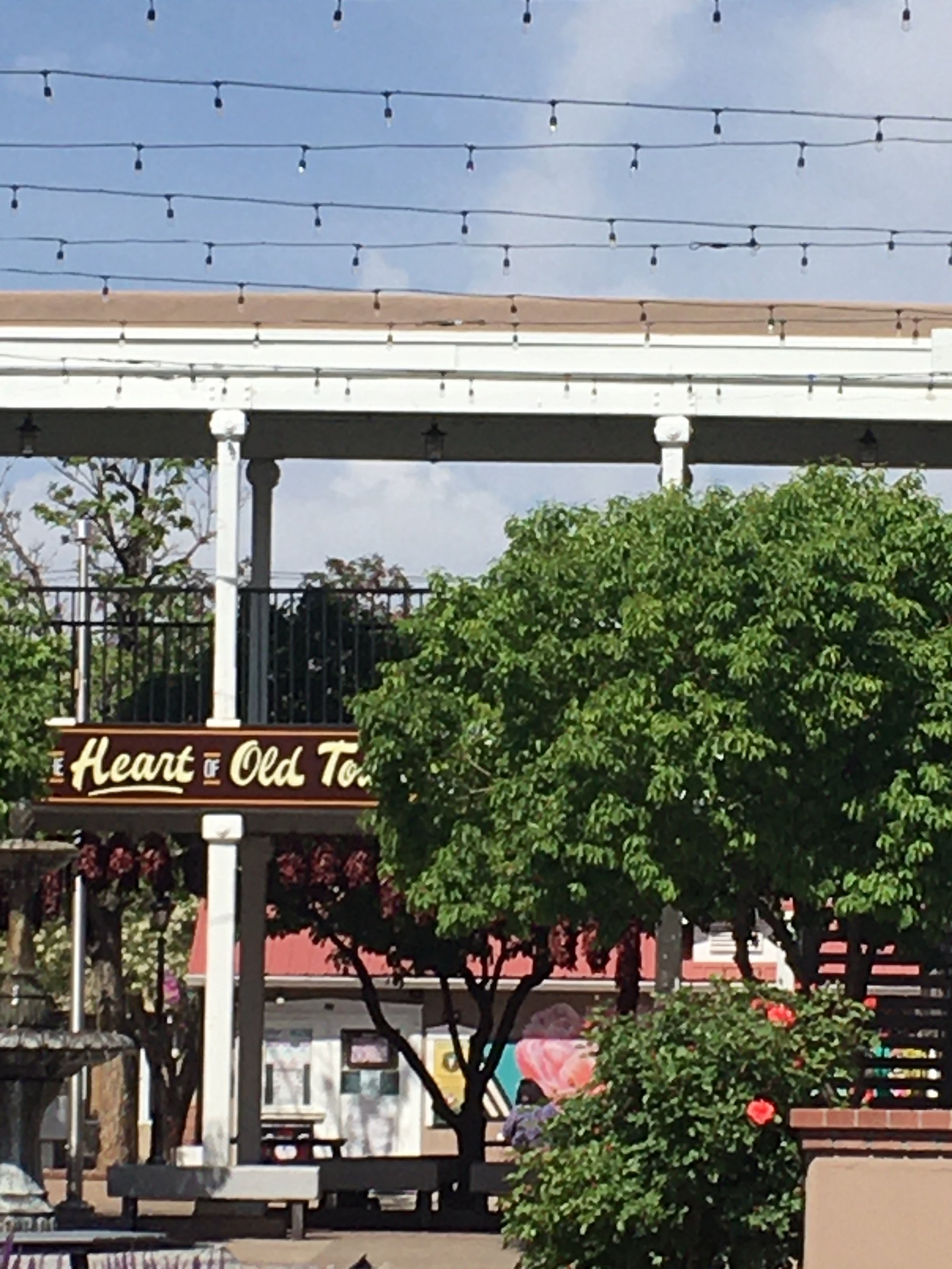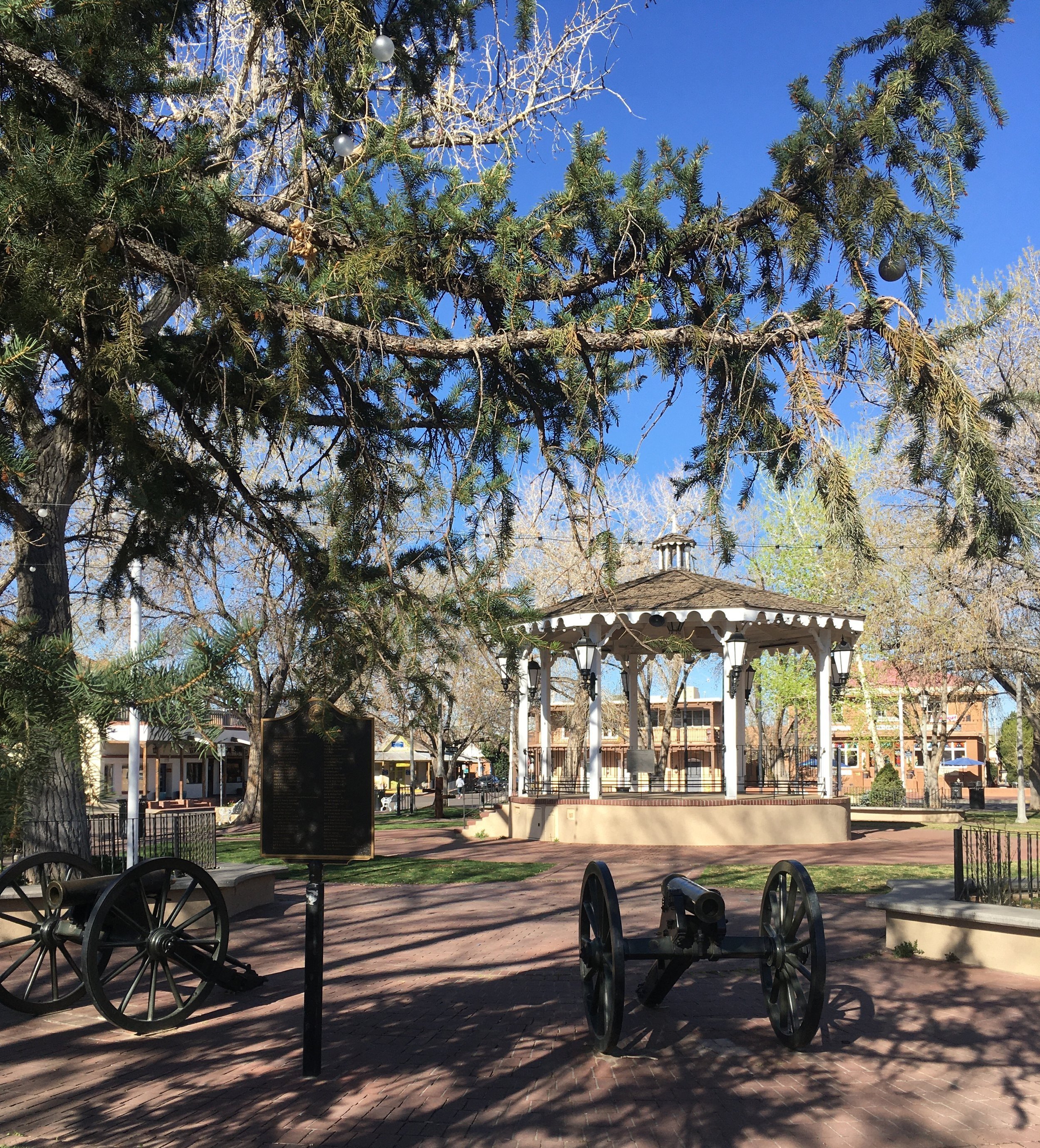Revised, after more research, April 20, 2022
Threatened! The Tradition of Old Town Albuquerque’s Murals
By Mary Dezember, Ph.D.
From Dr. Dezember’s View
Mural welcoming all to Old Town.
Old Town Albuquerque, central to the arts and culture of Albuquerque, has a long tradition of murals.
As an Old Town area resident, an arts scholar and arts and creativity advocate, I was shocked to learn that:
the tradition of Old Town Albuquerque murals is being threatened by the Landmarks Commission,
two murals are being targeted for destruction,
all murals might be destroyed.
Here, I am sharing a comprehensive opinion piece with the following call to action to officially recognize:
Old Town Albuquerque as central to Albuquerque’s art, culture and history;
Murals in Old Town are integral to the strong tradition of murals within Albuquerque and all existing murals must be designated as protected art;
Going forward: After a series of public discussions—with arts and culture professionals added to the Landmarks Commission and with well-documented research—clear guidelines for future murals in Old Town Albuquerque are created and are widely and effectively disseminated.
Additionally, I will make a statement about public art.
The Two Murals Targeted for Destruction—New Mexico Resilience and Lyrical Landscape—Both are Located Within Plaza Don Luis
“The two murals impair the integrity of the building and are not in keeping with the character of the area. The murals shall be removed.” — Official Notification of Decision by the Landmarks Commission of January 13, 2021.
I disagree with the Landmarks Commission. Here are three reasons why:
1. Both murals in Plaza Don Luis are lovely statements to visitors and residents that Albuquerque respects art as essential to culture and as being a link to past and present.
2. Both murals show the beauty of our landscape and highlight rich symbols of harmony.
3. The “character of the area” is defined by at least 55 exterior murals, including these two.
Artist Jodie Herrera and her mural, New Mexico Resilience, in Plaza Don Luis, Old Town Albuquerque, painted on a non-historical building, one only a few decades old.
The Landmarks Commission is targeting New Mexico Resilience and a mural by Reyes Padilla for destruction.
Jodie Herrera writes in her Instagram post of February 16, 2022, the following:
“I created this mural this past year in August for Plaza Don Luis located in old town Albuquerque. It was a true honor to represent our community and culture through this piece of work. The mural represents the resilience and beauty of the new Mexican people, like Cacti we Thrive despite difficult circumstances and we do it beautifully. The flower in full bloom also Represents the knowledge of the ancestors and the buds are Future generations to come. It honors the past and the present, a fitting sentiment for Old Town. The triangle pattern honors the masculine and the feminine or duality in general. Thank you @lapisroom and @pdlabq for the opportunity and lovely experience!
THIS MURAL IS IN DANGER OF BEING REMOVED!!!”
Photo credit: Cameron Crow. Photo provided by Jodie Herrera.
Artist Reyes Padilla painting his mural, Lyrical Landscape, in Plaza Don Luis, Old Town Albuquerque, on a non-historical building, one only a few decades old.
The Landmarks Commission is targeting Lyrical Landscape and the mural New Mexico Resilience by Jodie Herrera for destruction.
Reyes Padilla writes about the murals on an Instagram post of February 16, 2022, the following:
“It means the world to see the community rally behind these works and fight to keep them. This generation IS part of history - a living history that continually moves forward if it is to survive!!”
Photo Credit: Laura Houghton. Photo provided by Reyes Padilla
Look at All the Lovely Exterior Mural Art in Old Town “Proper”! — At Least 55 Murals!
ALL Existing Murals Must Be Protected Art and Not Targeted for Destruction.
Two—as of now—Must Be Saved from the Landmarks Commission’s Chopping Block:
Note about my photos above of murals in Old Town Albuquerque “Proper”: Some murals are small, some are large. There might be two or more photos for one mural to give more views of it. For example, eight photos show one long mural.
All of the murals currently in Old Town Albuquerque are lovely, are the character of Old Town and must be protected art!
Within just a specific area bordered by the streets of Mountain, Rio Grande, Central/Lomas, 19th and by the Albuquerque Museum parking lot—historic Old Town “proper” I suppose it can be called—I walked, took photos, and counted about 55 exterior murals.
From what I can tell from the Landmarks Commission map, the area I walked is the area for the Commission’s Historic Old Town Albuquerque Development Standards & Guidelines of May 17, 2018.
However, it is not clear where the border with the Albuquerque Museum is on the map.
There Are Murals in Nearly All of the Plazas. But Only the Two Murals in One Plaza—Plaza Don Luis—Are Being Targeted.
As you can see from the map, Old Town has several plazas: the main Old Town Plaza and several smaller plazas.
Many of the murals are within the separate plaza areas in Old Town; many are on the main Old Town Plaza.
There are murals in nearly all of the plazas—again, as many as 55 murals throughout the area on exterior spaces.
However, as I understand from the limited press coverage, at this time the only plaza that is being threatened with destruction of its mural art is Plaza Don Luis.
Yet, if the Landmarks Commission wants the murals in Plaza Don Luis destroyed, couldn’t the next move by the Landmarks Commission be to destroy the murals in all of the plazas and on the streets around the main plaza?
Thus, the tradition of mural art in Old Town Albuquerque is being threatened.
Old Town Albuquerque is Central to Albuquerque’s Art, Culture and History.
Further into this opinion piece I will share what I know about the call by the Landmarks Commission to destroy murals in Old Town.
However, first, let’s look at the significance of Old Town Albuquerque to the city’s art and culture.
As stated on the Visit Albuquerque website:
“Historic Old Town has been the heart of Albuquerque since the city was founded here in 1706. Today, Old Town is the city's cultural center, with numerous museums and more than 100 shops, galleries and restaurants.”
https://www.visitalbuquerque.org/about-abq/neighborhoods/historic-old-town/
Destroying art is not a way for Old Town Albuquerque to continue to be “the heart” of Albuquerque’s culture and art.
The beauty and symbolism of mural art revitalizes community while maintaining cultural links to past and present.
Mural Art in Albuquerque is an Honored Tradition.
Mural art throughout Albuquerque is an honored tradition. Murals in Old Town connect their focus of art and culture with that of the mural tradition of the entire city.
Of utmost significance is that the two amazing murals in Plaza Don Luis created by our local artists connect Old Town to Albuquerque’s overall stellar commitment to mural art—and to Albuquerque’s dedication to highlighting art and culture—but they are being targeted for destruction by the Landmarks Commission.
Both murals in Plaza Don Luis are lovely statements to visitors and residents that Albuquerque respects art as essential to culture and as being a link to past and present.
Muros de Burque website compiles images of murals throughout Albuquerque. The website states:
“Muros translates from Spanish as ‘walls’. In Albuquerque, our walls bring people together. Throughout our vibrant city you'll see our diverse culture expressed not just through the color of our skin, but through the color on our walls. Take a journey into the heart of who we are and discover the murals of Albuquerque.”
You can click here to see the murals documented by Muros de Burque:
Additionally, Muro de Burque provides this map of murals, some of which are found in Old Town:
The City of Albuquerque “Murals Resource Center” webpage states:
“Murals are an integral and traditional component of the arts scene in Albuquerque and the southwest.”
Two links to downtown Albuquerque murals also show the city’s rich mural tradition:
https://www.516arts.org/programs/murals
https://www.visitalbuquerque.org/abq365/blog/post/a-downtown-albuquerque-mural-mosey/It is interesting to read the “Visit Albuquerque: Change Your Perspective” webpage entitled “Albuquerque’s Public Art,” link below:
https://www.visitalbuquerque.org/about-abq/arts/
A mural by Nikki Zabicki and Roe Libretto, Blackbird Dreams of the Bosque, found on an interior wall of an Old Town building, has this description on its Muro de Burque webpage:
“Old Town Albuquerque is a magnet for international visitors, offering a melting pot of contemporary and traditional arts and an introduction to the unique iconography of New Mexico. The blackbird is one such icon. Symbolizing the mystery and mayhem of life, the blackbird is depicted in the work of many local artists. Here, at the Blackbird Coffeehouse in Old Town, this iconic and welcoming bird opens conversations that lead to friendships across cultural boundaries.”
https://www.murosabq.com/nikki-zabicki-and-roe-libretto-blackbird-coffeehouse/
Bordering the Lovely Murals in Old Town “Proper”:
Source: historic_old_town_neighborhood_2018_06_25_1529963653_3ee1947a-4d77-42af-abf1-823bab712f31.jpg “Visit Albuquerque: Change Your Perspective” website.
Then there are the murals within Old Town Albuquerque, but across the streets that frame the area designated by the Landmarks Commission map.
These areas are considered historic Old Town neighborhood, as is shown on the map from the “Visit Albuquerque: Change Your Perspective” website, but, again, do not seem to be part of the Landmarks Commission map.
Across the street on Rio Grande (and on the border of the Landmarks Commission map) is home of more gorgeous murals. One, highlighted by the “Visit Albuquerque: Change Your Perspective” website, is a mural at Casa Flamenca:
https://www.visitalbuquerque.org/about-abq/neighborhoods/historic-old-town/
Here are my three photos of Casa Flamenca murals and of another mural on Rio Grande, the lovely kettle of New Mexico chile:
It is hard to tell on the Landmarks Commission map if the Albuquerque Museum, which is the home of art, culture and history, is part of the contested murals.
The Pathway (1992-1993) by Albuquerque artist Beverley Magennis, with Robert Stout
While the museum doesn’t have murals on its walls, this place of art does have art on the walks in the sculpture garden.
Whether called sidewalk art, pavement art, sidewalk murals or pavement murals, the art is in public view outdoors and they lead right into other areas of Old Town designated on the Landmarks Commission map.
This Leads to the Question: What are Murals?
Succinctly stated, murals are creations/art/design (images, designs lettering, symbols) on walls, ceilings, roofs, windows, floors and walks, or possibly other surfaces.
These creations/art/design can be painted within, on, or attached to the wall, ceiling, roof, window, floor and walk or other surfaces.
The creations/art/design can be sculptural in material, such as with mosaic pieces or other materials. The creations/art can be carved into the wall, ceiling, roof, window, floor and walk. The creations/art/design can be on interior or exterior surfaces.
While stained glass isn’t typically referred to as mural art, it is window art and, I posit, can be considered mural art.
Mural Art is the Oldest Existing Art Form.
Murals include cave art at least 40,000 years old and petroglyphs and pictographs more than 10,000 years old.
Murals are a continuing historical, social and cultural expression—from frescos (artists throughout history) and murals in Mexico City and throughout the United States (three notable historical artists being Mexican artist Diego Rivera, American artist Thomas Hart Benton and, of course, New Mexico's own Will Shuster, also University of New Mexico’s first dorms of 1906 with large exterior wall designs painted by William George Tight and Ethel Hickey, and Albuquerque’s brilliant Maisel’s Murals by several Native American artists) to present-day Albuquerque with its impressive array of murals created by brilliant artists.
Evidence shows that murals existed in Old Town Albuquerque and its downtown neighborhood in the late 1800s and early 1900s.
A Note about Terms: Mural and Mural Art.
I am using the terms mural and mural art interchangeably in this opinion article. That is because mural has connotations that could make one think only of paintings on walls, usually large.
The word “mural” can be used as an adjective or a noun. Apparently, the use of the word as a noun is fairly recent, according to Maeve Maddox who refers to the Oxford English Dictionary.
However, the history of the word “mural”—the art form, the techniques, the materials and the placement of the designs on places other than walls—has evolved over time, as has Old Town Albuquerque.
Old Town murals are large and small; they all are art and design that include lettering, pictorial images and symbolic images or a combination of all of these. Small Old Town murals include art and design tiles or other materials affixed into or onto the walls.
The concern of the Landmarks Commission seems to be the exterior walls in Old Town must be adobe, faux-dobe or stucco without anything on them.
Further, the Landmarks Commission is making a distinction between lettering on walls and art and design on walls (keep reading to learn more about this) with lettering being “signage” and then, I suppose, no lettering being “art.” This is an overt oversimplification of what constitutes murals and is problematic in a cultural way.
All photos I have provided of Old Town murals are murals. If it helps to call the smaller ones or the ones with lettering mural art, then let’s do that.
Regardless, all have historical and cultural significance, including the two in Plaza Don Luis. Keep reading to learn more about this.
To read other thoughts on this topic of murals and mural art, see the following:
By Angie Kordic, Widewalls, “Mural — The History and the Meaning”
https://www.widewalls.ch/magazine/what-is-a-mural-the-history-and-meaning
By Maeve Maddox, Daily Writing Tips, “The Changing Meaning of Mural”
https://www.dailywritingtips.com/the-changing-meaning-of-mural/
Why are Only the Murals by Herrera and Padilla being Targeted by the Landmarks Commission At This Time?
I cannot find clear information on this.
Maybe other Old Town murals are next on the Landmarks Commission chopping block.
From reading the news articles I have found, the owners of Don Luis Plaza, who commissioned the murals, sought approval from officials but were told they didn’t need it as they own the buildings for the planned murals.
53 murals were painted in Old Town before these. Did they all get approval from the Landmarks Commission? Or did they, based on the same information the owners of the private property of Plaza Don Luis had, proceed with creating their mural art?
The procedures with the Landmarks Commission are difficult to find. I know that for me as a concerned citizen, information has been hard to find.
The buildings on which the murals are painted are not historical.
The KRQE article of January 18 to 20 by Annalisa Pardo states:
“The City’s guidelines for Old Town, newly clarified in the fall, bans murals. While the murals were painted before then, the city said they still didn’t follow the older, broader versions of the rules which still required building exteriors to reflect Old Albuquerque.”
This rationale by the city is problematic and full of discrepancies—see the rest of this article for evidence as to why I say this.
Publicity of this important concern has been next to nil. Why has the public not been informed?
The Old Town area is my neighborhood. It is not an outdoor museum or outdoor mall made up of only historic and commercial buildings.
And yet, as a resident of the area, I received no notification from the Landmarks Commission that the existing mural art was being reviewed for its “appropriateness.”
I discovered this issue from Instagram posts by the two mural artists, Jodie Herrera and Reyes Padilla. These posts led me to the following two articles:
https://southwestcontemporary.com/abq-small-businesses-fight-commissions-decision-to-remove-murals/
https://www.kunm.org/local-news/2022-02-09/city-calls-for-removal-of-murals-in-albuquerque-old-town
Those articles led me to the following two reports:
https://www.krqe.com/news/politics-government/city-rules-new-old-town-murals-must-come-down/
Due to the discrepancies in rationale by and the lack of transparency of the processes by the Landmarks Commission, I still cannot learn the actual reason the Landmarks Commission wants to destroy art. Their decision appears arbitrary.
Here is what I have found:“The two murals impair the integrity of the building and are not in keeping with
the character of the area. The murals shall be removed.”Under “Conditions of Approval,” point 2 states:
“The murals visible from Rio Grande Boulevard and within Plaza Don Luis shall
be removed as they are not in keeping with the historic integrity and sense of
place of Old Town HPO-5.”Apparently, the decision is currently under appeal. The Southwest Contemporary article of February 4, 2022 by Steve Jansen states:
“The owners of Plaza Don Luis and allies are appealing the decision, arguing that the Landmarks Commission, which is in the process of revising Old Town’s design standards, is retroactively attempting to enforce rules that weren’t in place when the murals were painted.”
It took me some time, but I finally, on April 19, 2022, found the 2022 document that states:
“Exterior wall murals are not appropriate for the Old Town District.” (Point 9) https://documents.cabq.gov/planning/LUCC/Old%20Town%20Design%20Guidelines.docx.pdf
This is absolutely retroactive, and the process for creating this document was not transparent nor based on evidence and research.
The 2022 “Historic Old Town Development Standards & Guidelines” document must be repealed and then revised after input, comment and review by arts and culture personnel and the public.
To see the date, go to this link: https://www.cabq.gov/planning/codes-policies-regulations/historic-standards-and-guidelines
Then look for “Old Town Historic Zone Guidelines (2022)”
We must reach out to stop this destruction of glorious art.
You can read Official Notification of Decision by the Landmarks Commission of January 13, 2022, here:
https://documents.cabq.gov/planning/LUCC/Hearing%20-%20January%2012%202022/301%20Romero%20SI-2021-01904.pdfThe KUNM article of February 9, 2022 by Alice Fordham, “City Calls for Removal of Murals in Albuquerque Old Town”, reports the following statements made by Leslie Naji, senior planner at the Landmarks Commission:
“‘There have always been guidelines,” she [Naji] says. “But there hasn't been a clear book that’s been set out, because we’ve been kind of short-staffed for a while.’
However, she says, the guidelines did exist.
‘They have always stated that the exterior should be in keeping with what was the traditional materials and colors and styles of the period from 1880 to 1912,’ she says. Murals were not part of that.
‘We find that it's really important to maintain that integrity,’ she says. ‘Its charm is in its reality, not in painting it up to be something that it wasn't.’”
It Seems as though the Landmarks Commission is Working from the Premise of a Supposed or Imagined Past Rather than from Actuality Based on Research and is Using Selective Perception.
First of all, Naji’s comments suggest there were no murals in Old Town until the two were created in Plaza Don Luis last year. And yet, there were about 53 murals in the Old Town area designated by the Landmarks Commission before the two were painted in Plaza Don Luis.
Secondly, the statement that murals were not part of the exterior of buildings in Old Town from 1880 to 1912 is incorrect. See links to photos in the next section of this article.
Thirdly, these two murals, as well as the other 53 that were painted before these, are most definitely “in keeping with the character of the area”…and “with the historic integrity and sense of place of Old Town…”
Ultimately, the Landmarks Commission is using selective perception: seeing only two of the at least 55 murals in the designated Old Town area.
To me, it sounds like Naji and the Landmarks Commission are working from the premise of a supposed or imagined past rather than from actuality based on research.
Who Decides the “character of the area” and “historic integrity and sense of place of Old Town”? Even the Landmarks Commission Rationale Is Filled with Discrepancies About This.
If the Landmarks Commission wants Old Town to have nothing on any of its exterior walls so that its appearance harkens back to how it maybe looked in its very early mostly residential days before 1880—
then they would destroy the wonderful eclectic charm of Old Town, and much more than art would need to be removed: possibly the current gazebo, then reconstructed as stone. (The historical gazebo was stone, photos show.)
Definitely the reproductions of Confederate cannons would have to go. (The originals were buried in the area in 1862.)
Architectural styles of buildings would have to be changed.
Consider this quote from Historic Albuquerque: An Illustrated History, by Carleen Lazzell and Melissa Payne, a publication by The Albuquerque Conservation Association, Historical Publishing Network, 2007, p. 17:
“Many of the still-standing buildings in Old Town are actually Victorian or later, though some look older due to the ‘puebloization’ of the 1950s. Only a few buildings other than today’s church survived a horrendous 1874 flood.”
One example is the Armijo Store and House (most recently La Placita Restaurant), which had a “wooden facade” (Albuquerque: Then and Now, 2006, by Mo Palmer, Salamander Books, Thunder Bay Press, p. 16). A photo in the book shows ornate porch pillars and, overall, a home that looks very different than the supposedly “historical” look of today’s building. Thus, the actual wooden facade building from around 1880 must have been changed around the 1950s or after to be in the Spanish Pueblo Revival style.
Turning Old Town into a place of a “supposed” past is not the direction to be moving in a revitalized Old Town Albuquerque that is so much more than a museum of long ago history: Old Town is the arts and cultural heart of Albuquerque. Old Town is a community space. Old Town is a neighborhood. Old Town is a wonderful blending of past and present.
The KRQE article of January 18 to 20, 2022, by Annalisa Pardo states the following quote from Naji:
“‘There was some painted signage, but artistic wall murals were not part of the artistic or cultural style of that period,’ said Leslie Naji, senior historic preservation planner for the City of Albuquerque.’”
Based on the quote from Naji in the KRQE article, this mural art that welcomes everyone to Old Town would need to be destroyed as well as most of the murals currently in Old Town. This cannot happen. None of the existing mural art, including the art in Plaza Don Luis, should be destroyed. All existing art in Old Town must be designated as protected art. Future mural art must be have guidelines that include arts and culture professionals on the Landmarks Commission with opportunities for public comment.
What constitutes “painted signage”? What constitutes “artistic”? See all of the photos of the Old Town murals I posted at the beginning of this article.
Naji is not the one to decide what constitutes “artistic” of that period. Or “painted signage.”
Which murals of the 55 will be destroyed if left to the determination of Naji and the Landmarks Commission?
There must be public comment, with arts and culture professionals added to the Landmarks Commission, and evidenced research.
Mural Art was in Old Town “Proper” and the Old Town Neighborhood within the Specified Dates of 1880 to 1912. Some Evidence:
In fact, mural art graced at least three Old Town buildings and distinguished several more in surrounding areas during the timeframe specified by the Landmarks Commission—1880 to 1912.
Evidence of this is found in this photograph from the New Mexico Digital Collections, a service of the University of New Mexico libraries, of a mural in Old Town, in 1898—a wonderful coffee cup mural on the side of the building and, on the right side, a mural with lettering and fabulous large graphic design under the lettering.
https://econtent.unm.edu/digital/collection/Ciotola/id/140/rec/21
More evidence: Here is a photo of Old Town Albuquerque around 1890 that shows either a mural or a board with images/art in Forgotten Albuquerque: Images of America, by Ty Bannerman, Arcadia Publishing, 2008, p. 37. Top photo, look to the right:
More evidence: In Albuquerque: Then and Now, by Mo Palmer, Salamander Books, Thunder Bay Press, 2006, p. 14, a photo of the Old Town Plaza before 1900 shows the adobe guardhouse (now the gazebo) with a 121-foot flagpole. Across the street, in an arch on at the roofline of the facade of a small building are words painted in the arch, looking quite artistic. I couldn’t find a link to a photo, but the photo in the book is great.
More evidence: Here is a photo of Post Office in Old Town, 1915, with mural art (lettering) on the facade. From Albuquerque Old Town (Old Town Merchants Association) website. Click on link, then on Gallery to find the photo:
There is a wonderful photo of the 1892 territorial fair parade in Albuquerque, with a gorgeous “Artists Materials” mural on the side of a building, on page 34 of Historic Photos of Albuquerque, Text and Captions by Sandra Fye, Turner Publishing Company, 2007. The mural is also shown on page 64.
Several photos of main Old Town Plaza from Albuquerque Old Town (Old Town Merchants Association) website can be seen on the link below. The gazebo was stone in the 1940s. Another photo (link further in this article) shows what looks like the gazebo in 1880 to 1912 being stone. So, apparently, it didn’t look as it looks now. Again, some, maybe many, buildings were frame, not adobe, faux-dobe or stucco.
Click on link, then on Gallery, to view the photos:
https://albuquerqueoldtown.com/index.php?page=history
A photo of present-day Central Ave in 1897, from the New Mexico Digital Collections, a service of the University of New Mexico libraries, on the link below, showing a mural:
https://econtent.unm.edu/digital/collection/Toulouse/id/0/rec/1
Second and Silver—a photo from 1905 shows a mural. From New Mexico Digital Collections, a service of the University of New Mexico libraries on the link below:
https://econtent.unm.edu/digital/collection/acpa/id/7304/rec/302
Second and Gold—an article stating “Much admiration” for “wall paintings” in 1907:
Source of above newspaper clipping: Albuquerque Special Collections Public Library; provided by Jodie Herrera.
And, wow, look at this quote from Albuquerque Deco and Pueblo: Images of America, by Paul R. Secord, Arcadia Publishing, 2012, p. 21:
“Pictured here is the full flowering of [William George] Tight’s vision, the first dorms on the UNM campus, both built in 1906…The exterior walls featured large designs inspired by Hopi pottery and painted by Tight and an English teacher, Ethel Hickey.”
One is a large round mural, the other is a large oval mural. Both quite symbolic. Both very beautiful. I couldn’t find links to photos, but they are a delight to see in this book.
Photo of Old Town Plaza in late 1800s or early 1900s on the link below. From New Mexico Digital Collections, a service of the University of New Mexico libraries:
https://econtent.unm.edu/digital/collection/Toulouse/id/6
Photo of very early Old Town on the link below. There are several dates listed, but the first date is 1888. From the Utah Department of Cultural & Community Engagement, J. Willard Marriott Digital Library, The University of Utah.
While this is a lovely photograph of Old Town as a village, much happened—including mural art, during the time of this photo and 1912—as the other photos show. Additionally, while art might not have been on any of the walls at this very early time, this is a photo of a small area of what is Old Town according to the designated map. And, we cannot see the walls closely in this photo. We can see the stone gazebo:
What are the Landmarks Commission Standards and Guidelines?
Below are the guidelines to which Naji must be referring when she stated in the KUNM article “there have always been guidelines.” There was a link to a document of these guidelines in the KUNM article but are difficult to find otherwise:
The Standards and Guidelines Ensure that Existing Murals in Old Town Must Not be Destroyed.
I see nothing in the Standards and Guidelines that suggests that any of the existing murals should be destroyed.
Points 4 and 5 ensure that the existing mural art—including the two murals completed in 2021 in Plaza Don Luis—complies with the Guidelines and Standards.
None of the existing 55 or more murals in Old Town should be required to be destroyed. They are all a part of the history, culture and evolution of Old Town and have “developed significance in their own right and this significance should be recognized and respected.” See point 4.
Buildings on which some of mural art is located are only decades old.
Question: What Was NOT Historically of the Time Period Between 1880 and 1912?
Answer: Cannons.
Old Town Plaza Boasts Reproductions of Confederate Civil War Cannons: Originals Were Not of Time Period between 1880 and 1912.
The main Old Town Plaza boasts reproductions of Confederate Civil War cannons. The date of the original cannons are 1835 and they were buried in 1862. “They represent a proud and important era in Albuquerque history,” their accompanying plaque states.
But they are not appropriate to the dates specified by the Landmarks Commission of 1880 to 1912. These weapons, situated in a prominent position in Old Town, greet visitors and residents.
A Recap with Additional Points:
Again, Two Murals in Particular are Being Targeted for Destruction—Again, Why? These Two Murals and All Existing Murals in Old Town Must be Protected Art.
The view of Don Luis Plaza from the Main Plaza. The murals are not visible.
Photo added to this post on April 27, 2022.
There were at least 53 murals existing in Old Town Landmarks Commission designated area prior to the two that are the focus of the call for art destruction by the Landmarks Commission—the two murals in Plaza Don Luis.
The murals in Plaza Don Luis are located on the border of Old Town, along Rio Grande, not unlike the bordering art of the Albuquerque Museum and are also just across the street from mural art on Rio Grande that is outside the map.
Further, they are set back off the main plaza and the streets.
One is not seen at all from the main plaza streets. The other is not easily seen from the main plaza streets.
Herrera’s art welcomes us most magically when we walk into the Plaza Don Luis. Situated far back into the plaza, this mural is painted on the public restroom building that also houses the office for some old town tours.
The mural, in addition to being beautiful and meaningful art, also provides a practical purpose: the mural helps people to find this important yet non-historical building.
Padilla’s art is hidden until one walks way back into the Plaza Don Luis. It is a beautiful “hello” on the exterior of the Lapis Room Art Gallery.
As I understand it, they are on the walls of buildings that are not historical and are only a few decades old.
Both murals are gorgeous and thrilling. They symbolize the overlapping communities and harmonies and the landscape of the Land of Enchantment.
Why are these two murals, created by New Mexico accomplished artists, being targeted for destruction by the Landmarks Commission? Is it because they have symbolic images?
Symbolic art was being created during the years 1880 and 1912. Other murals in Old Town are symbolic images.
Symbols and geometric patterns are a tradition of the original residents of this area, the indigenous artists.
So, why?
The Landmarks Commission’s decision appears arbitrary.
Without transparency of its process and without evidence, the Landmarks Commission produced a 2022 document of standards and guidelines and wants it be used retroactively. This cannot happen.
View from the front of Don Luis Plaza from Romero Street, several feet from the Main Plaza. New Mexico Resilience mural is barely visible. Lyrical Landscape mural is not visible.
Photo added to this post on April 27, 2022.
Here are My Comments and Questions to the Landmarks Commission:
Your rationale to destroy the two murals in Plaza Don Luis appears to be based on:
an imagined history (or possibly a time much earlier than 1880),
limited research with evidence,
selective perception,
a lack of understanding and appreciation of art that is symbolic.
Symbols and geometric patterns are a tradition of the original residents of this area, the indigenous artists.
If you believe murals were not in Old Town during the dates of 1880 to 1912, why does the designated Old Town area have at least 55 murals, 53 that existed before the two in Plaza Don Luis were painted in 2021?
There is a long tradition of murals in Old Town with apparent allowance of 53 or more murals by the Landmarks Commission before the two created in Plaza Don Luis.
Are you wanting to also destroy the other 53 or more murals in Old Town?
It sounds as though you want to destroy the honored tradition of murals in Old Town.
Are your decisions based on discrimination against art but favoritism for weapons?
Will you also then remove the Confederate cannon reproductions, which are not of the designated time of 1880 to 1912 and wouldn’t have sat indefinitely on the main Plaza of Old Town?
Information Must Readily Available and Processes Transparent.
I am not an investigative reporter.
I am a concerned citizen with opinions based on inquiry and research.
Why is information so hard to find about this situation?
There are no arts and culture professionals on the Landmarks Commission. Here is the membership of Landmarks Commission—Landmarks and Urban Conservation Commission it says—I found on the Landmarks Commission website:
https://iqconnect.lmhostediq.com/iqextranet/view_feed.aspx?c=FSL_ALBQ&id=100336Arts and culture professionals must be added to the Landmarks Commission.
How will a decision be made?
Finding information about this situation and even finding out there IS a situation has been difficult.
Here is the information I have found or that have been provided to me by concerned friends and relatives who are also researching this situation:
https://documents.cabq.gov/planning/UDD/UDD-OldTownDevelopmentGuidelines-May2018.pdf
https://www.cabq.gov/planning/boards-commissions/landmarks-commission/landmarks-commission-agendas-action-sheets
https://www.cabq.gov/planning/boards-commissions/landmarks-commission/historic-landmarks
https://www.cabq.gov/planning/boards-commissions/landmarks-commission/historic-preservation
https://southwestcontemporary.com/abq-small-businesses-fight-commissions-decision-to-remove-murals/
https://www.kunm.org/local-news/2022-02-09/city-calls-for-removal-of-murals-in-albuquerque-old-town
https://www.krqe.com/news/albuquerque-metro/its-a-city-showpiece-new-property-rules-would-keep-character-of-old-town/
https://www.krqe.com/news/politics-government/city-rules-new-old-town-murals-must-come-down/
And, finally, the mysterious document of 2022:
https://www.cabq.gov/planning/codes-policies-regulations/historic-standards-and-guidelines
Look for “Old Town Historic Zone Guidelines (2022)
After Arts and Culture Professionals are Added to the Landmarks Commission and After a Series of Public Discussions, Clear Guidelines for Additional Mural Art in Old Town Albuquerque Must be Created and Widely and Effectively Disseminated.
All existing murals and mural art must stay.
Future mural guidelines should be reviewed by the public and by a Landmarks Commission that includes arts and culture professionals.
Naji states in the KUNM article “There hasn’t been a clear book.” The November 8 to November 9, 2021 KRQE article by Annalisa Pardo states the Landmarks Commission is working on or already has a new 22-page book of guidelines. THIS MUST BE THE MYSTERIOUS DOCUMENT OF 2022; IT MUST BE REPEALED. A NEW BOOK OF GUIDELINES MUST BE PASSED ONLY AFTER PUBLIC DISCUSSION and REVIEW BY ARTS and CULTURE PROFESSIONALS and REFERENCED EVIDENCE.
To Readers—Call to Action:
If you have ideas on how we can rally together to support mural art in Old Town, particularly at this time for the two murals in Plaza Don Luis, please let me know.
I have a letter that I will be emailing to anyone I can. (See next heading below.)I sent a similar one to the city councilors on March 17, 2022, only to be informed that my emails were removed from their inboxes.
The city official replied: “Thank you for reaching out, however this issue involves an application and decision by the Landmarks Commission that may be appealed to the City Council. City Councilors act in a quasi-judicial manner for appeals. For that reason all emails and communications to councilors have been removed from their inboxes.”
So, the decision on the appeal doesn’t allow input from concerned citizens to the City Councilors?
If you write a letter/email and send to City Officials or anyone you know who might be able to rally to save the mural art in Old Town, you can refer to this blog post opinion article.
Both murals in Plaza Don Luis are lovely statements to visitors and residents that Albuquerque respects art as essential to culture and as being a link to past and present.
Here is My Letter:
Dear
I am a resident of the Old Town neighborhood and an arts scholar.
Do not destroy or remove the beautiful, relevant, meaningful and impactful murals by Jodie Herrera and by Reyes Padilla in the Plaza Don Luis. These murals are absolutely in keeping with the character of the area, though the Landmarks Commission has stated otherwise and has targeted these two murals that are among the at least 55 murals in the designated area of Old Town.
All of the mural art currently in Old Town Albuquerque is lovely, is the character of Old Town and must be protected art!
Of utmost significance is that the two amazing murals created by our local artists Jodie Herrera and Reyes Padilla connect Old Town to Albuquerque’s overall stellar commitment to mural art—and to Albuquerque’s dedication to highlighting art and culture.
Both murals in Plaza Don Luis are lovely statements to visitors and residents that Albuquerque respects art as essential to culture and as being a link to past and present.
The murals are located in a plaza that is set back from the street. After entering Plaza Don Luis, walking toward the back, then seeing their beauty and symbolic significance, they welcome us, most magically, to our present age of honoring history, culture and revitalization.
Destroying these two murals is not the direction to be moving in a revitalized Old Town Albuquerque that is so much more than a museum of long ago history. Old Town is the arts and cultural heart of Albuquerque. Old Town is a community space. Old Town is a neighborhood. Old Town is a wonderful blending of past and present.
I’d like to add that these two murals connect Old Town to the rich heritage of mural art as the oldest art form:
Mural art includes cave art at least 40,000 years old and petroglyphs and pictographs more than 10,000 years old.
Murals are a continuing historical, social and cultural expression—from frescos (artists throughout history) and murals in Mexico City and throughout the United States (three notable historical artists being Mexican artist Diego Rivera, American artist Thomas Hart Benton and, of course, New Mexico's own Will Shuster, also University of New Mexico’s first dorms of 1906 with large exterior wall designs painted by William George Tight and Ethel Hickey, and Albuquerque’s brilliant Maisel’s Murals by several Native American artists) to present-day Albuquerque with its impressive array of murals created by brilliant artists.
Evidence shows that murals existed in Albuquerque and in Old Town Albuquerque in the late 1800s and early 1900s.
Old Town has a long tradition of murals. Again, I have counted about 55 murals in the area designated by the map of the Landmarks Commission Historic Old Town Development Standards & Guidelines of May 17, 2018.
Further, these murals do not celebrate or glorify a history of dominance or violence. They show the beauty of our landscape and highlight rich symbols of harmony.
The main Old Town Plaza boasts reproductions of Confederate Civil War cannons. The date of the original cannons are 1835 and they were buried in 1862. “They represent a proud and important era in Albuquerque history,” their accompanying plaque states. But they are not appropriate to the dates specified by the Landmarks Commission of 1880 to 1912. These weapons, situated in a prominent position in Old Town, greet visitors and residents.
Why can't we have our magnificent New Mexico landscape and harmony of cultures depicted in the oldest historical art form of murals--murals that are on the walls of buildings set back from the street, far back into the Plaza Don Luis?
The decisions on what stays and what goes should not be based on discrimination against art but favoritism for weapons.
Old Town is the heart of Albuquerque’s art and culture. Let's keep it that way.
Let's not let Albuquerque become known as a city that destroys art.
Please inform me of further discussions so that I can be involved and share my voice.
Also, please add arts and culture personnel to the Landmarks Commission. Future decisions on guidelines should include the evidence and input of arts and culture personnel and of the public.
The process for creating the 2022 “Historic Old Town Development Standards & Guidelines” document was not transparent. Further, no evidence or research was used for the document’s statement about murals. This 2022 document must be repealed and then revised after a process that includes the expertise of arts and culture personnel and includes public comment.
I have written a comprehensive opinion article based on inquiry and research entitled “Threatened! The Tradition of Old Town Albuquerque’s Murals” that I am sharing with as many people as possible. I think you will find the evidence informative.
Please read it here:
Sincerely,
Mary Dezember, Ph.D.
Petition:
This is not my petition, but I have signed it. It is a change.org petition; click on link to read and sign it:
The Accomplished Local Artists Who Created the Mural Art in Don Luis Plaza:
Reyes Padilla and Jodie Herrera
Artist Reyes Padilla. Photo credit: Roberto Rosales
About Reyes:
Born in Santa Fe, New Mexico, Reyes Padilla currently lives and works in Albuquerque. His paintings, murals, and site-specific installations have sold to a variety of collectors and museums, including the State of New Mexico, The City Of Braddock, Pennsylvania, and The Mesa Contemporary Arts Museum. Padilla's installation titled, ¡Mira, Look!, was purchased for the permanent collection of Explora Science Center and Museum in Albuquerque in 2016. He has been awarded a fellowship with SOMOS ABQ. In 2019 he received the Distinguished Alumni Of the Year award from Central New Mexico Community College.
About his art, Reyes Padilla states:
“I paint music. Having synesthesia means that I experience sound visually. My work is created by actively painting what I see while listening to music. The decision to embrace what I am seeing and paint it in the moment seems like a natural dance between two worlds.”
Photo, bio and artist statement from https://www.reyespadilla.com/about
You can learn more about Reyes on his website and on this link to the Lapis Room:
Padilla’s mural, entitled Lyrical Landscape (2021) is inspired by “the colors and sounds of New Mexico,” states the Southwest Contemporary article of February 4, 2022, entitled “ABQ Small Businesses Fight Commission’s Decision to Remove Murals.” Photo credit: Laura Houghton.
https://southwestcontemporary.com/abq-small-businesses-fight-commissions-decision-to-remove-murals/
Reyes Padilla writes about the murals on an Instagram post of February 16, 2022, the following:
“It means the world to see the community rally behind these works and fight to keep them. This generation IS part of history - a living history that continually moves forward if it is to survive!!”
Artist Jodie Herrera and her mural, entitled New Mexico Resilience (2021), in Plaza Don Luis, Old Town Albuquerque, painted on a building only a few decades old.
Photo credit: Cameron Crow. Photo provided by Jodie Herrera.
Jodie Herrera is a Northern New Mexican painter with Latina, Apache and Comanche ancestry. She has been an artist her whole life and started formally painting in 2011. Herrera received her BFA with honors from the University of New Mexico and currently resides in Albuquerque, where she works as a full time Artist and Curator.
Jodie Herrera writes in her Instagram post of February 16, 2022, the following:
“I created this mural this past year in August for Plaza Don Luis located in old town Albuquerque. It was a true honor to represent our community and culture through this piece of work. The mural represents the resilience and beauty of the new Mexican people, like Cacti we Thrive despite difficult circumstances and we do it beautifully. The flower in full bloom also Represents the knowledge of the ancestors and the buds are Future generations to come. It honors the past and the present, a fitting sentiment for Old Town. The triangle pattern honors the masculine and the feminine or duality in general. Thank you @lapisroom and @pdlabq for the opportunity and lovely experience!”
You can see some of Herrera’s other murals listed with Muros de Burque here:
https://www.murosabq.com/?s=jodie+herrera
You can learn more about Jodie and her art on her website and on the Lapis Room website:
https://www.lapisroom.com/jodie-herrera
Public Art, Democracy, Equality—What Do We Honor and Celebrate?
Art found in public spaces has long been art honoring and celebrating conquest, domination and violence. It is often kept in place under the guise of being historical.
Art celebrating conquest, domination and violence has no place in parks and open spaces, places of the public sphere.
Rather than being destroyed, art celebrating conquest, domination and violence can be moved inside a museum with explanatory information about its significance to history and its honoring of dominance that, we as a democracy, no longer revere.
Art that symbolically or representationally honors and celebrates community, culture, beauty, non-violent history and speaks to concerns of those oppressed, marginalized and still being subjected to inequality is art that speaks to the entire public of a democracy.
Two reproductions of Confederate cannons that had been buried near Old Town flank the front of Old Town Plaza, weapons greeting visitors and residents.
NOTE: All photos were taken by me, unless otherwise indicated by a photo credit. Thank you to concerned friends and relatives who helped in finding information on this situation.
A second source, Italians in America by Nicholas P. Ciotola (Publisher: Aracia, 2002), shows the photograph of the Porto Rico Saloon and Grocery and states the business was operated by A. Allesandri, “One of the earliest Italian businessmen in Albuquerque.” The caption also states that the business was near the present location of the Albuquerque Little Theater, 224 San Pasquale SW. This location, stated as Old Town, would be bordering the designated area of the Landmarks Commission map:
I am reading several books from the Albuquerque library on the history of Albuquerque with photographs within the next week—see photo.
As I find more information, I will post a second opinion piece with updates.
Enjoying my additional research on murals and art in Albuquerque, historical to contemporary, from books from the Albuquerque Public Library, with a latte and next to a stunning interior mural in a coffee shop in my neighborhood—Old Town.
About the Blog Author: Wings of Art
Mary Dezember, PhD, believes all of the current mural art in her neighborhood of Old Town Albuquerque must stay and be protected. Seen here in 2021 enjoying what she calls the wings of art, fixed on a building in Old Town, Mary believes this art is a type of mural art and must be protected.
Mary is a poet, an author of fiction and non-fiction, an educator, arts scholar, arts advocate, and a lover of visual, verbal, musical art, and the beauty of language.
Mary earned her PhD in Comparative Literature, specialization in Comparative Arts, from Indiana University in 2000, with PhD minors in Art History and Performance Studies.
Professor Emeritus of English, she taught Comparative Arts, Art History, Creative Writing and Literature at New Mexico Institute of Mining and Technology (New Mexico Tech) from August 2000 to May 2021. At New Mexico Tech, she also served as Interim Vice President for Academic Affairs, Associate Vice President for Academic Affairs and Chair of the Department of Communication, Liberal Arts & Social Sciences.
She enjoys performing her poetry and advocating the creativity of others. She is a tour guide for Santa Fe Art Tours.
She is the founder and host of Creatives in Conversation.
Her publications include several non-fiction essays and articles and two books of poetry: Earth-Marked Like You (Sunstone Press) and Still Howling (CreateSpace Independent Publishing), with the title poem being First Place winner of the Best Beat Poem Contest, 2016, sponsored by Beatlick Press. Her novel, Wild Conviction, a winner of the Inkshares 2020 All-Genre Manuscript Contest, is in the works to be published.
Her writing examines the historical basis for contemporary social issues and the internal quest or rite of passage to identity. She strives to inspire champions to create a new and better day.
Photo credit: Tobias Pino
Copyright © 2022 Mary Dezember
Dezember, LLC



